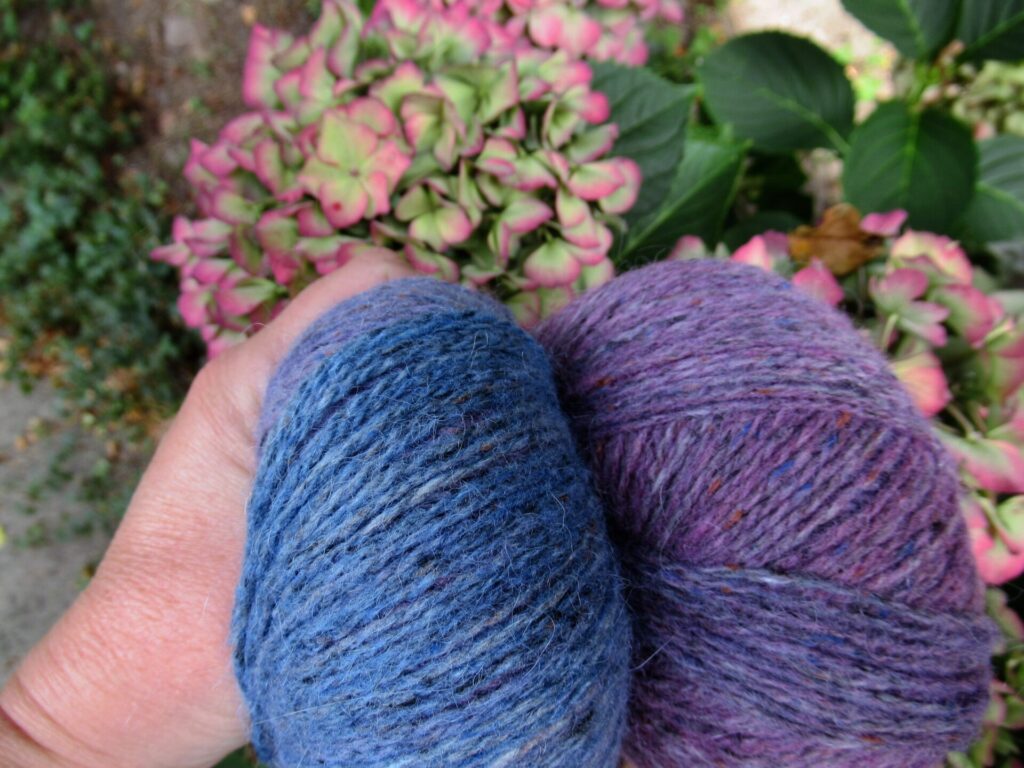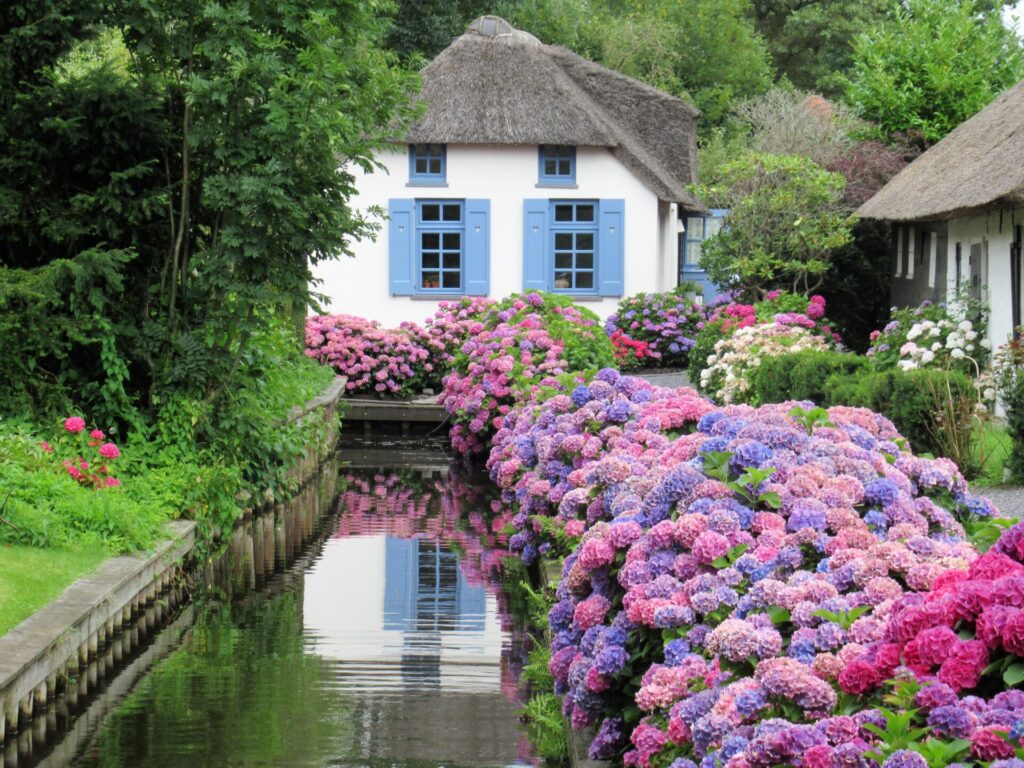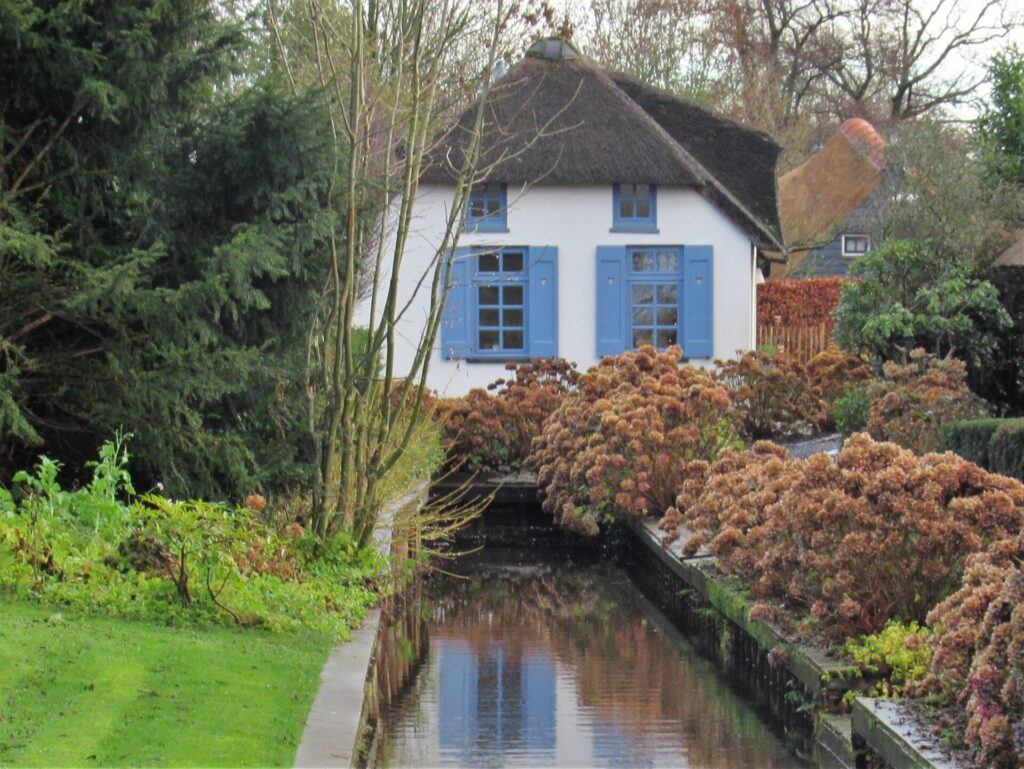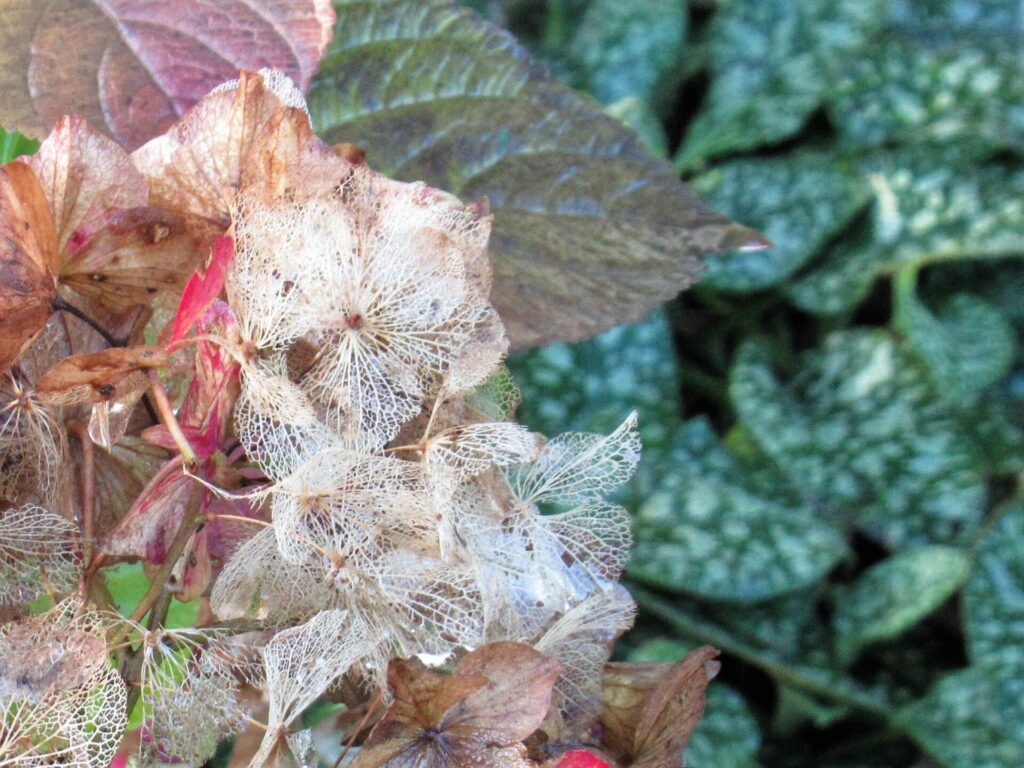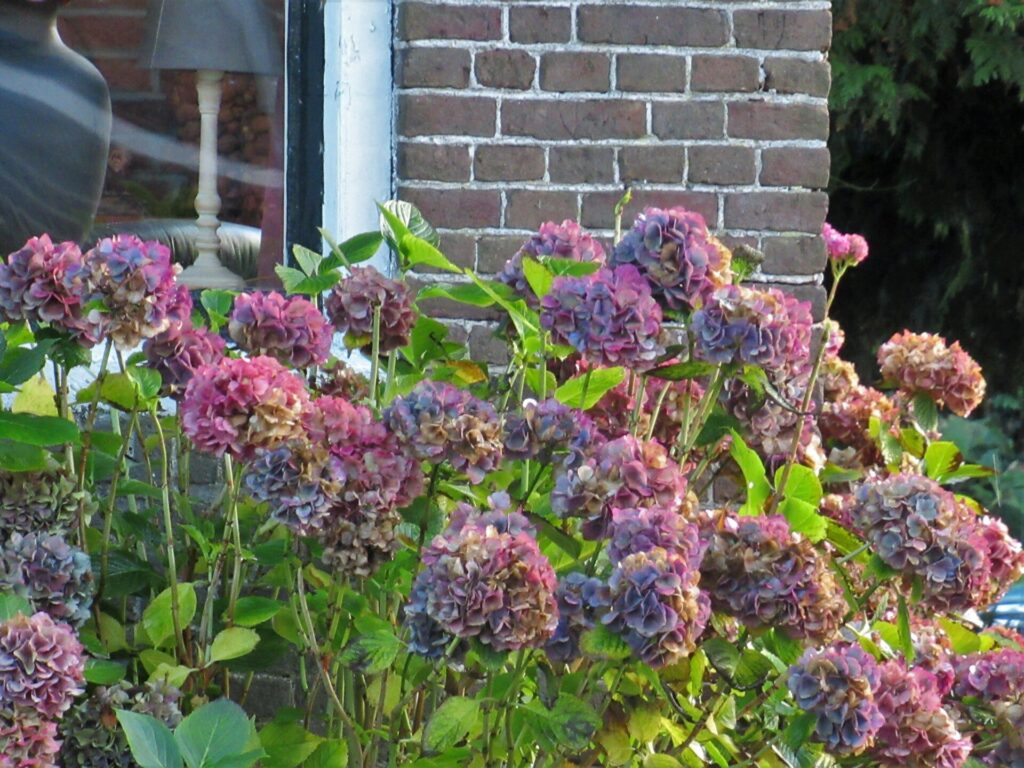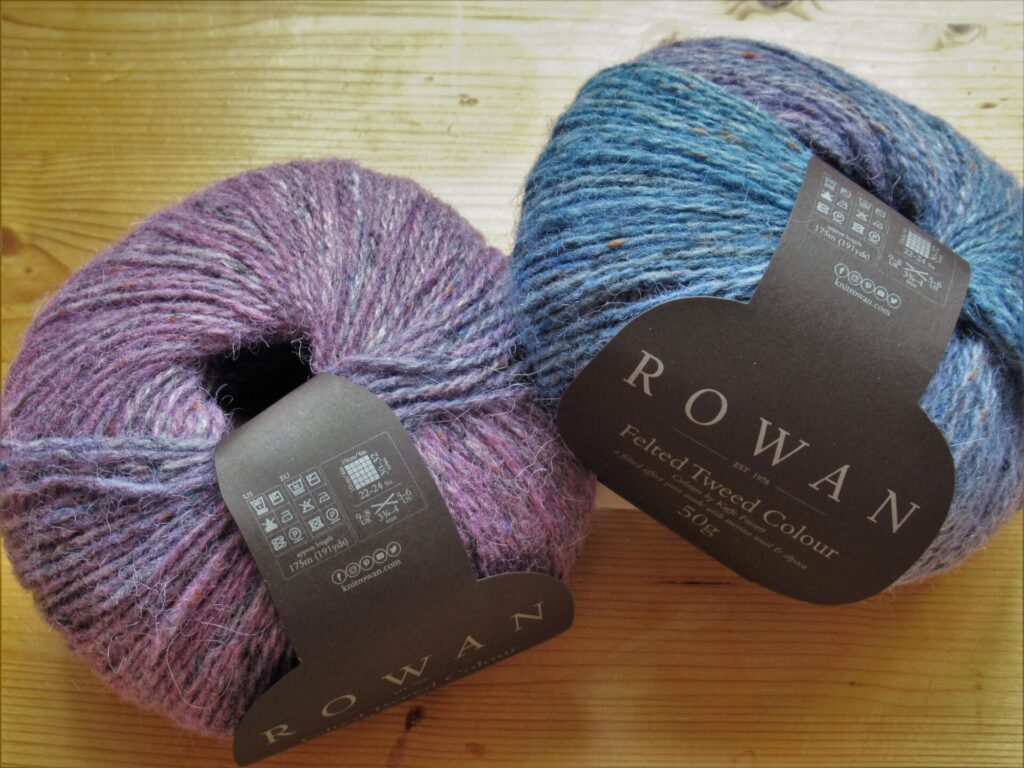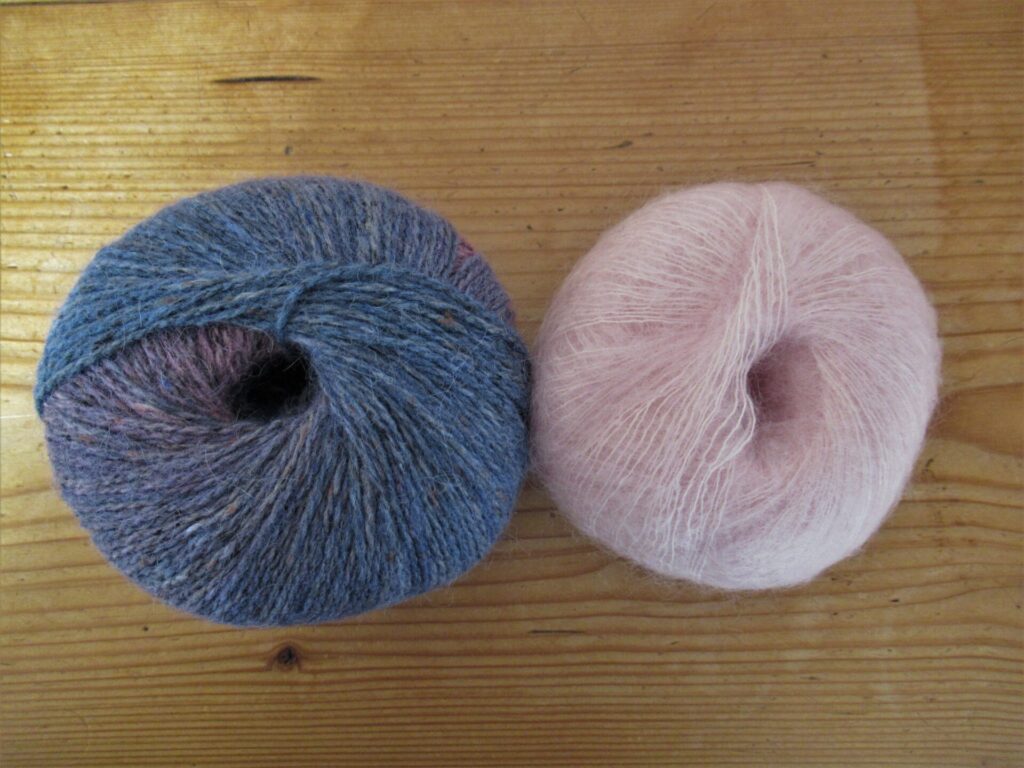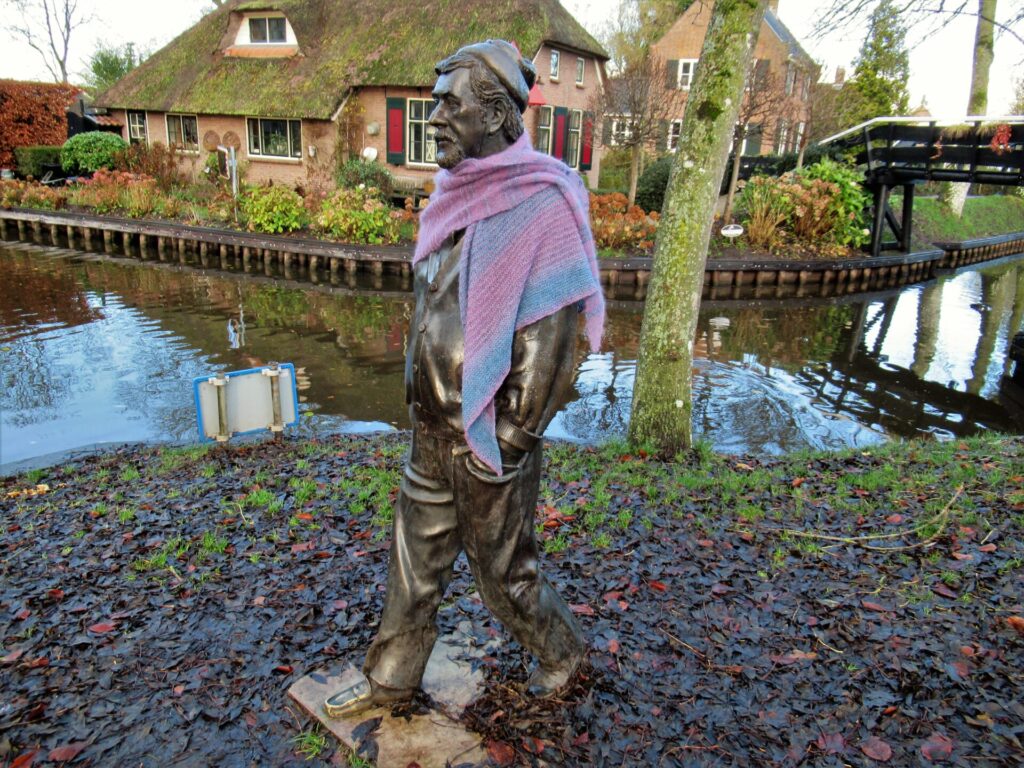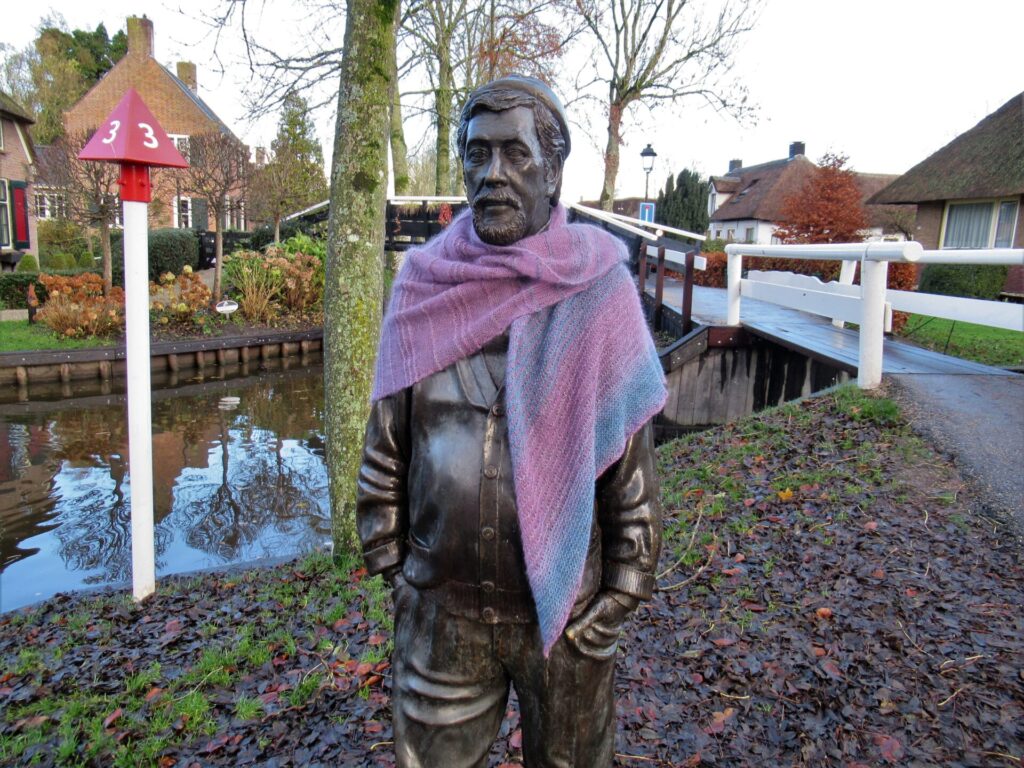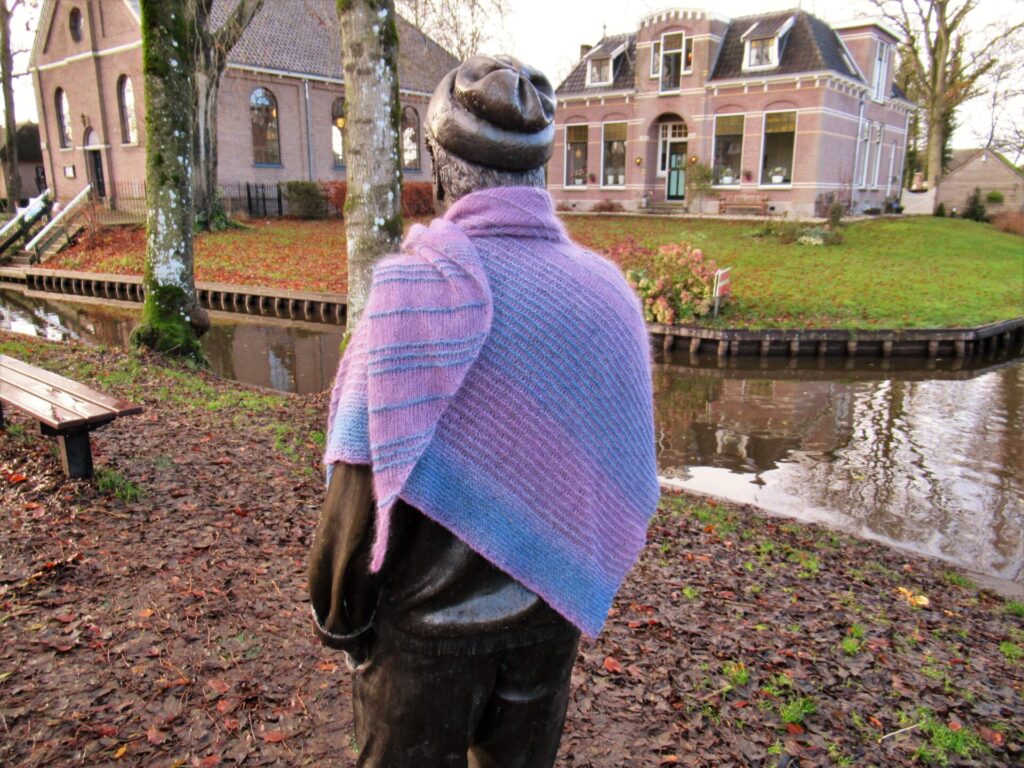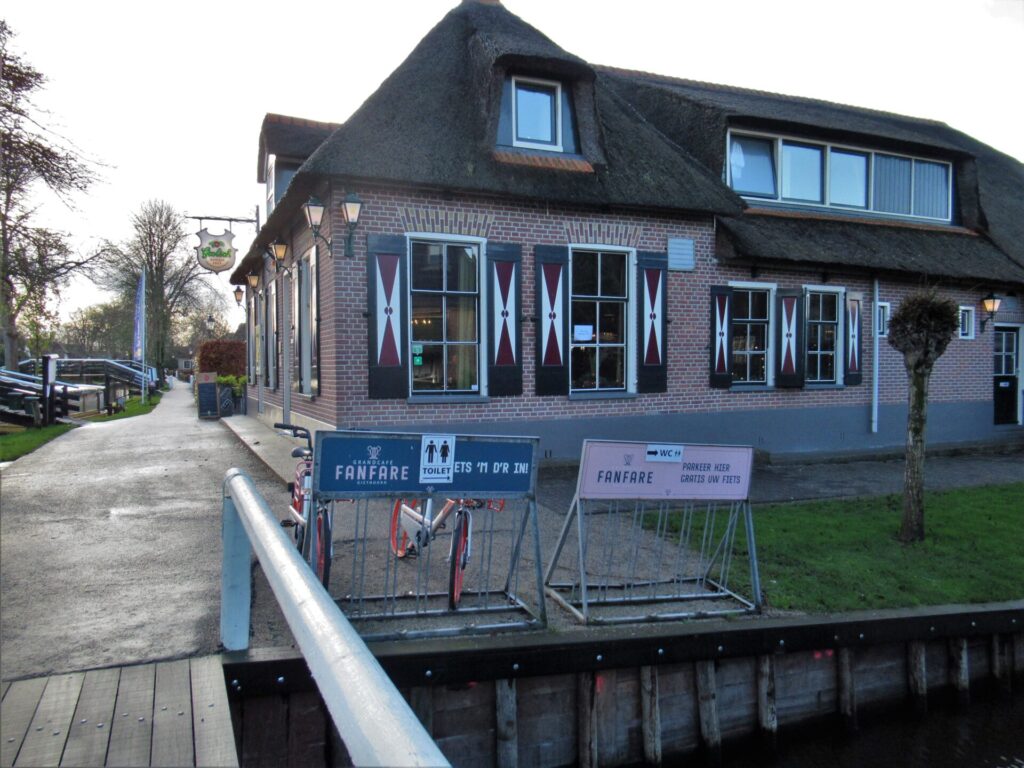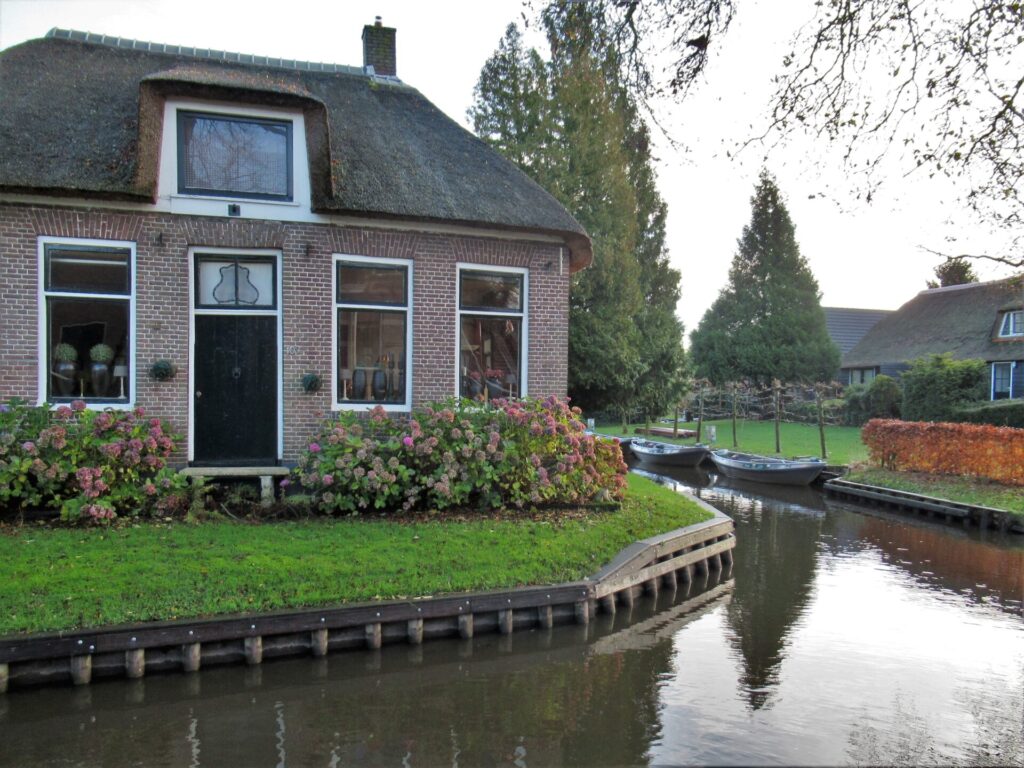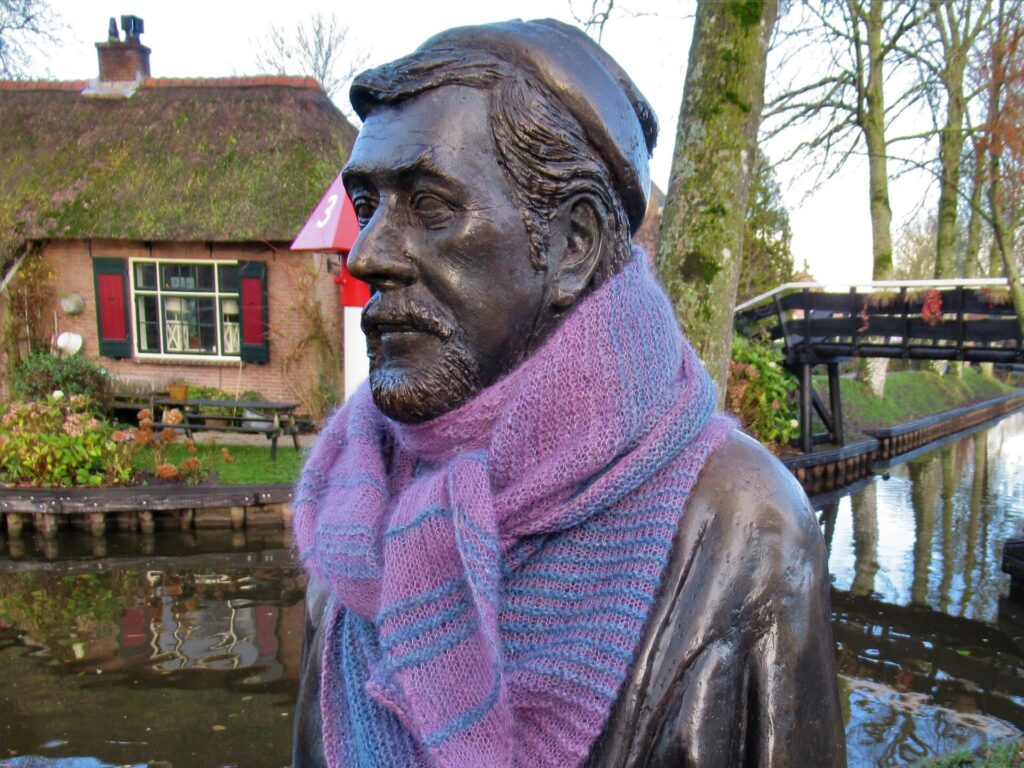accessories
Story Lines
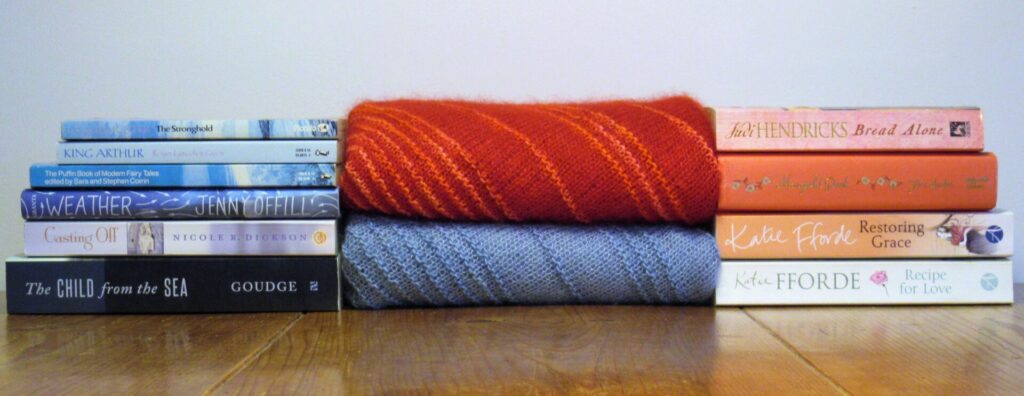
Hello!
It won’t come as a surprise that I love knitting. To me (and I know to some of you, too), seeing a knitting project grow stitch by stitch and row by row is immensely satisfying. Although I haven’t written much about books until last week, I love reading a good story just as much.
Now I’ve combined the two and knit a story in the shape of a shawl! Or rather two shawls, knit along the same lines but telling different stories.
The watery blue version of Story Lines, as I’ve named the design, tells the saga of a drowned village.
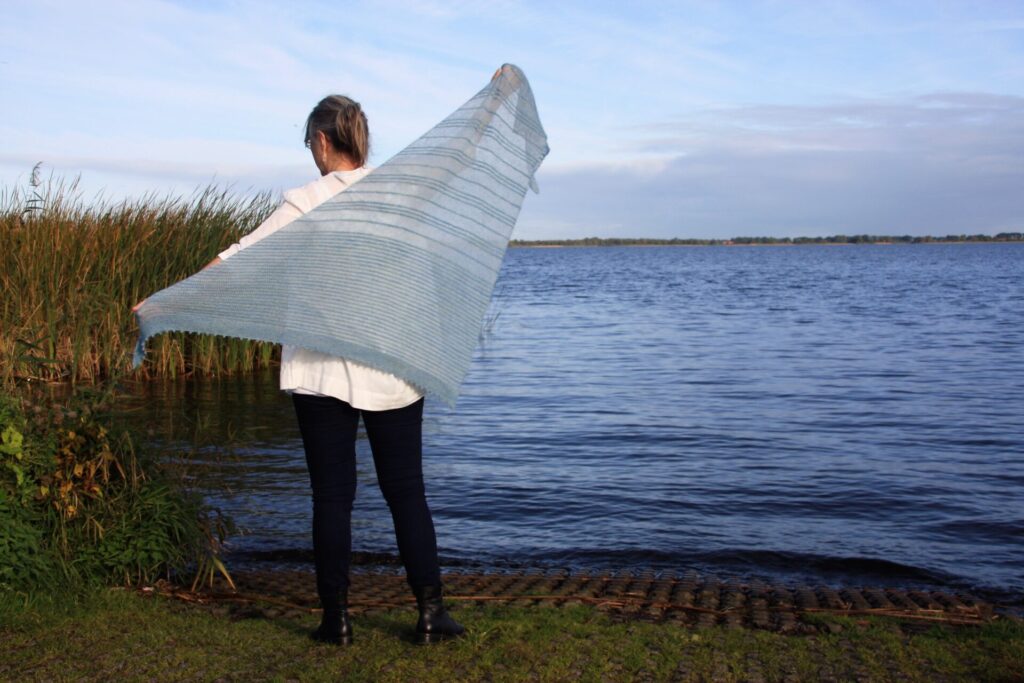
It is a slightly asymmetrical triangle that starts off on a light and airy note – transparent stocking stitch stripes with widely spaced out garter stitch lines. Later on, the plot thickens and the lines are knit closer together.
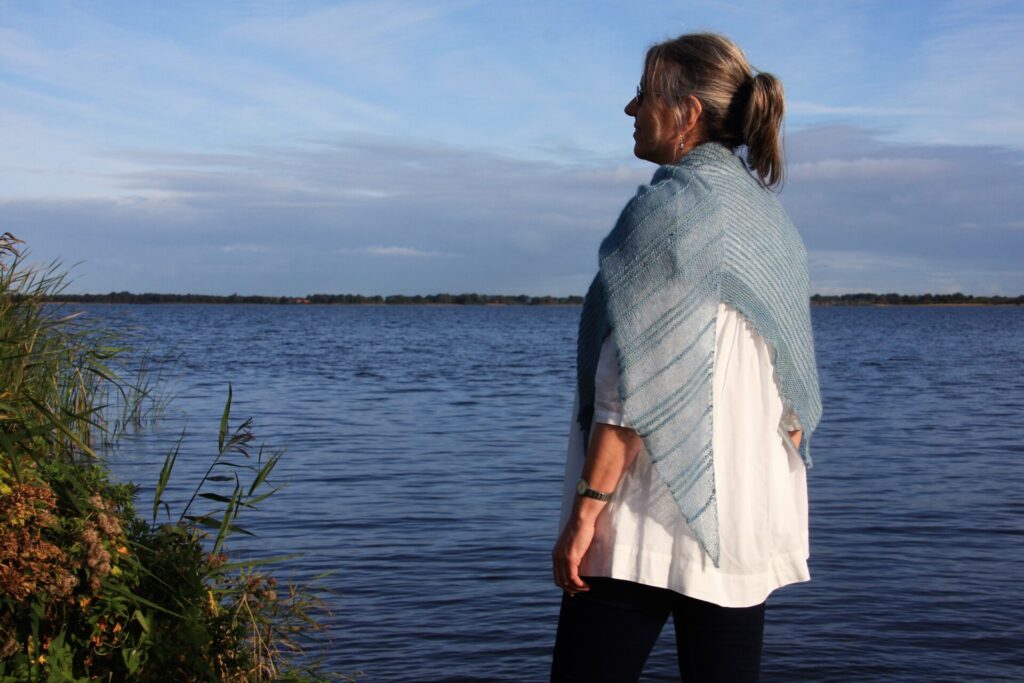
A village really did drown in the lake where these pictures were taken.
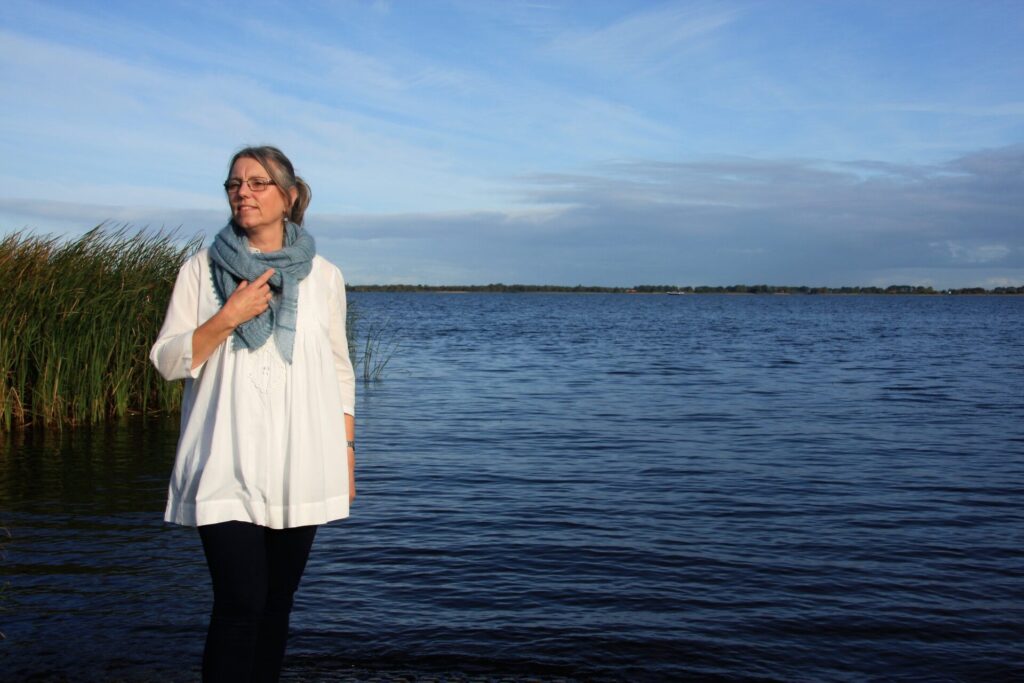
It was the village of Beulake. Extensive peat extraction had already made the area vulnerable. And when the dykes broke during a storm in 1776, Beulake disappeared beneath the waves. Only the church, where the villagers had fled to, was spared.
Fortunately no lives were lost, but the people who lost their homes must have shed a few tears. A row of Dainty Droplets seemed a fitting ending for this shawl.
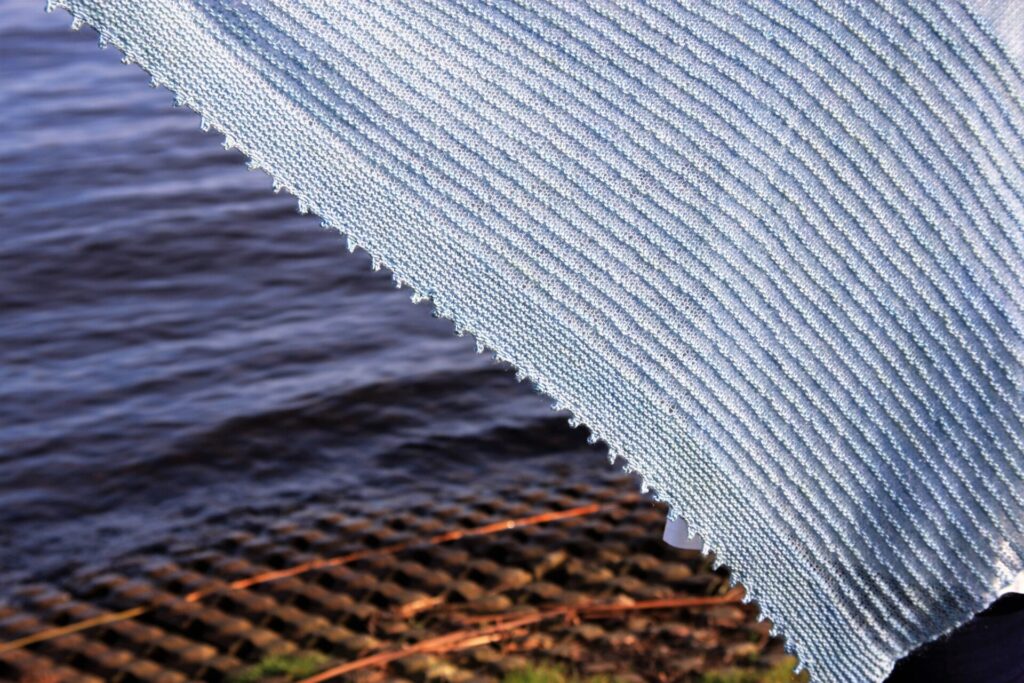
Although the basic pattern is the same, the other shawl I knit has a different tale to tell. In fiery reds, it tells a love story from a time long gone by.
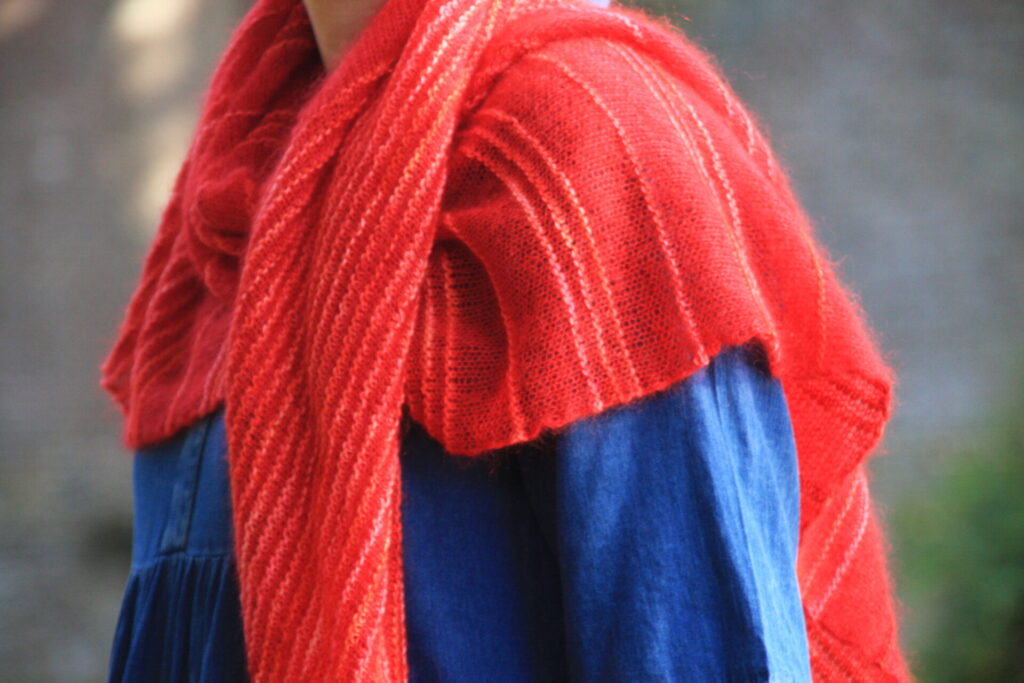
This story is set against the backdrop of a castle ruin, not far from the lake of the drowned village.
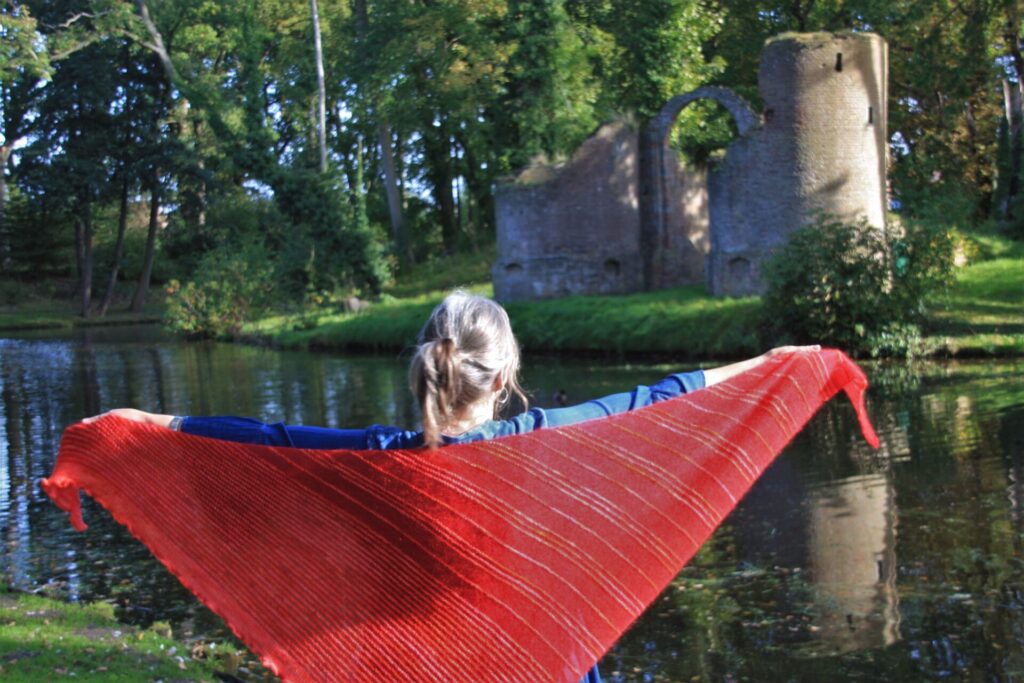
It is Toutenburg, the remains of a medieval castle in the town of Vollenhove. An utterly romantic spot. There is a moat around it, with a lovely fountain.
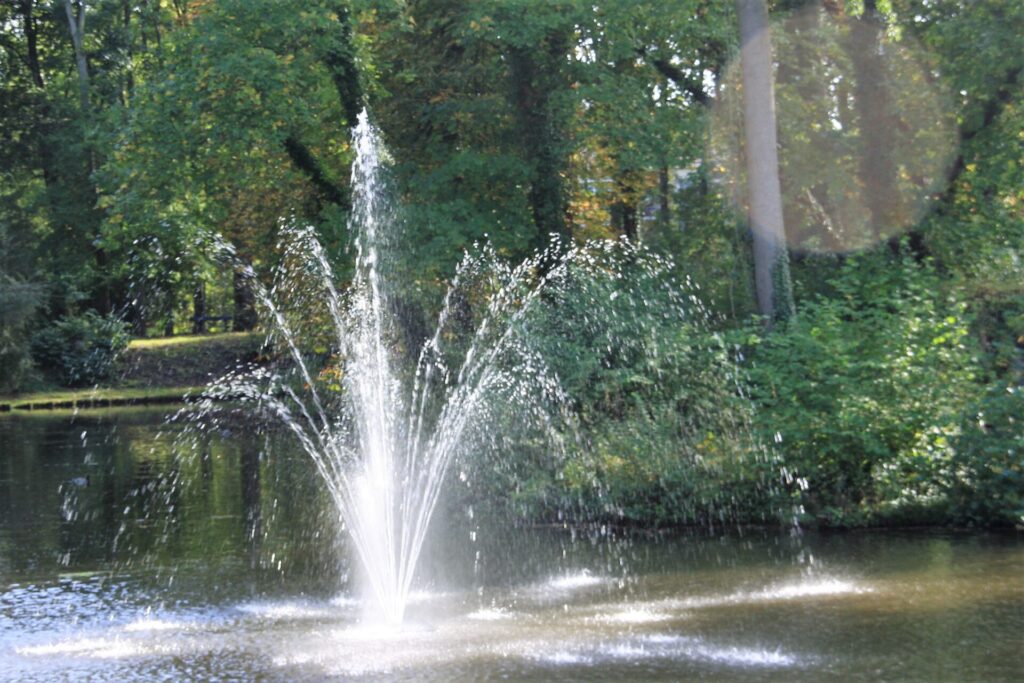
This version of Story Lines needed a different ending – a Romantic Ruffle. I’m not really a ruffle-y type, so I’ve kept it modest.
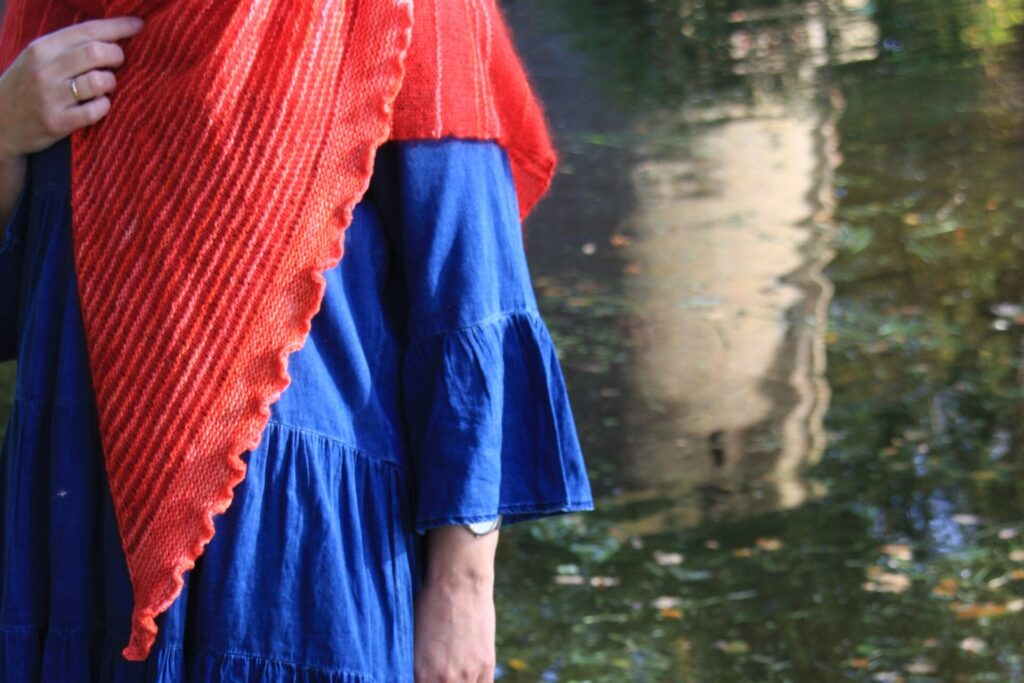
Story Lines is a very easy knit. The only reason I wouldn’t recommend it to an absolute beginner is that the thinner of the yarns used takes a little experience to handle.
The design combines two types of yarn: a lace-weight mohair/silk blend and a fingering-weight single-ply merino yarn – 1 skein (50 g) of the former and 1 skein (100 g) of the latter.
The yarns I used for both shawls come from an indie dyer in my little corner of the world. She creates many gorgeous colours. Below you can see the mohair/silk blend I used on the left, the 1-ply merino on the right:
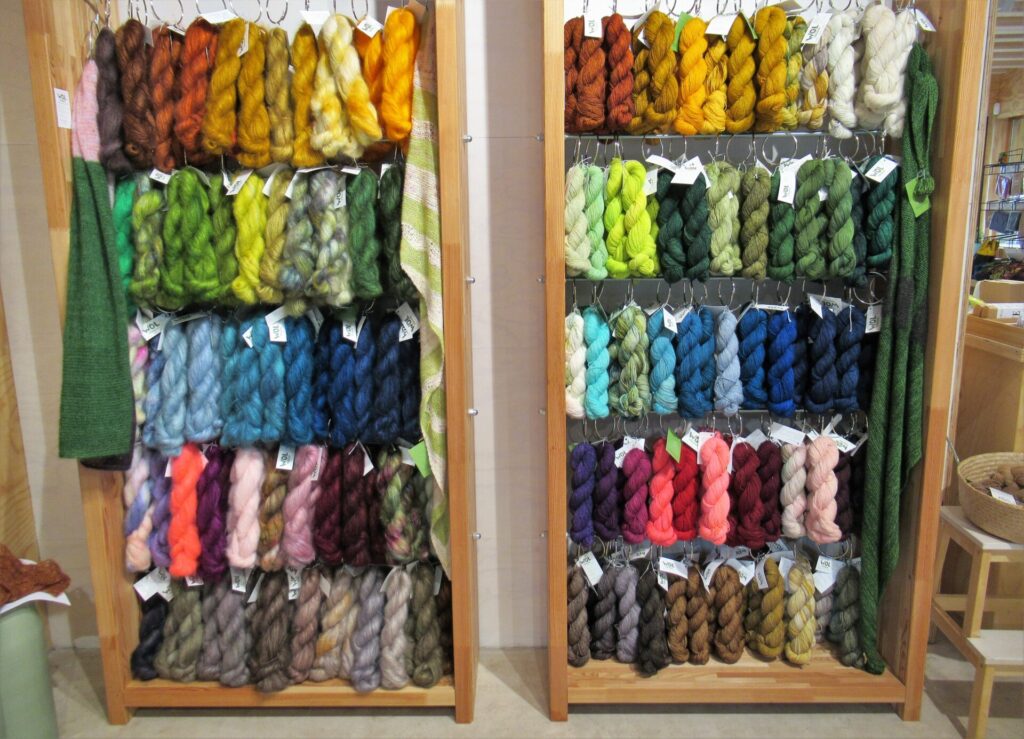
‘My’ indie dyer is happy to ship world-wide, but those of you not living in the Netherlands could also look for yarn closer to home. Here is a list of very similar yarns from indie dyers all over the world:
- Canada: Lichen and Lace (Marsh Mohair/1-Ply Superwash Merino Fingering-Weight)
- France: La Bien Aimée (Mohair Silk/Merino Singles)
- Germany: Walk Collection (Kid Mohair Lace/Cottage Merino)
- Ireland: Hedgehog Fibres (Kidsilk Lace/Skinny Singles)
- Norway: Norne (Kid Silk/Singles)
- Sweden: Fru Valborg (Fuzzy Mohair/Merino Singles)
- UK: Qing (Kid Mohair Silk/Merino Singles)
- US, New York: The Wandering Flock (Laceweight Mohair Silk/Fingering Weight Singles)
- US, Oregon: Ritual Dyes (Fae/Crone)
Some people find a triangle a difficult shape to wear and I understand. Worn in a traditional way it can look old-fashioned. But it can be worn in so many ways, as already shown in some of the pictures above. Here are some more ideas.
Worn nonchalantly with the two long ends on one side:
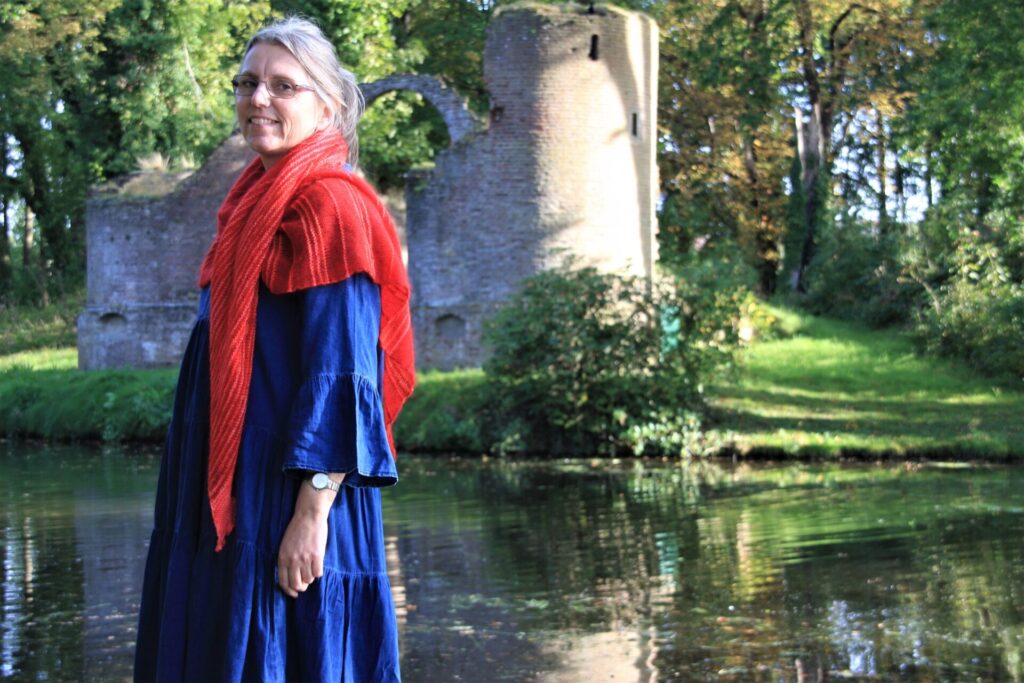
Rolled up with the point at the back of the neck inside, worn much like a rectangular scarf:
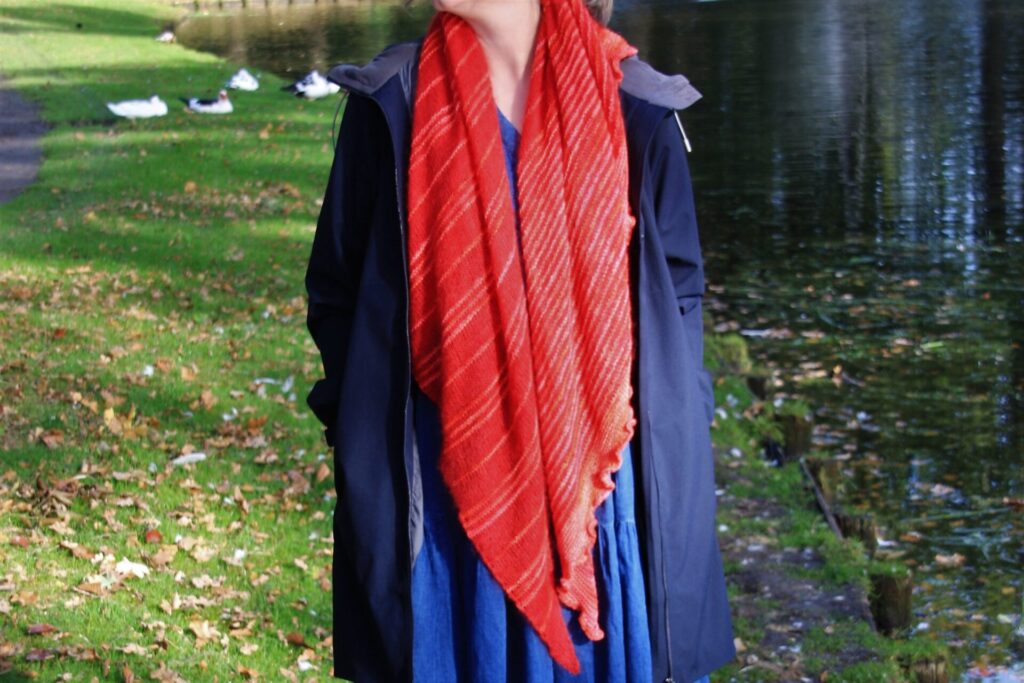
With the ends knotted loosely:
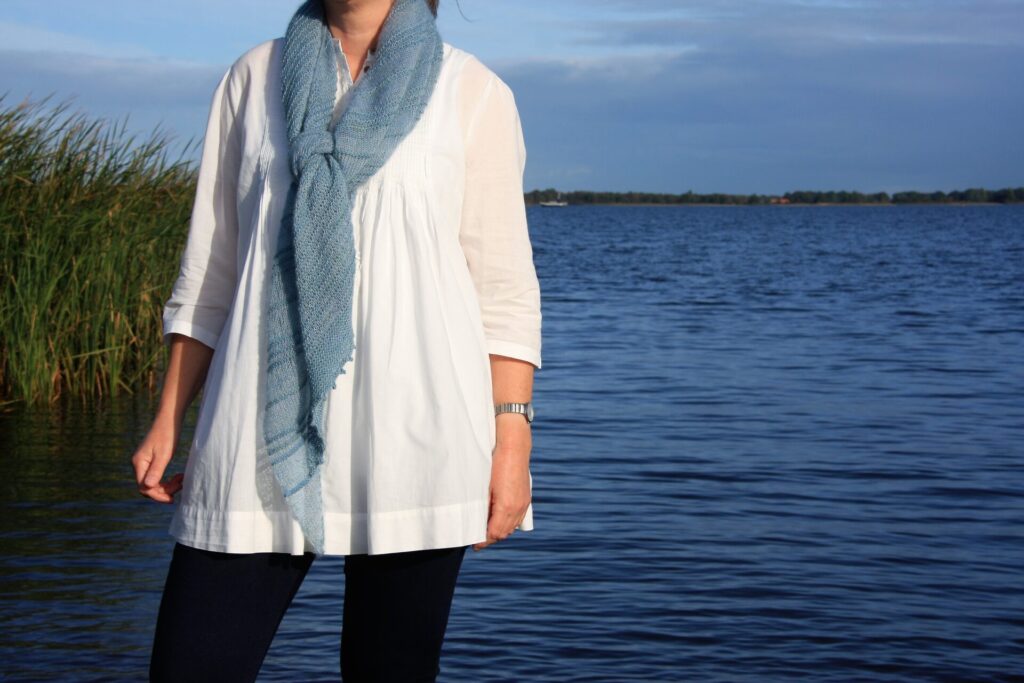
Or scrunched up cosily:
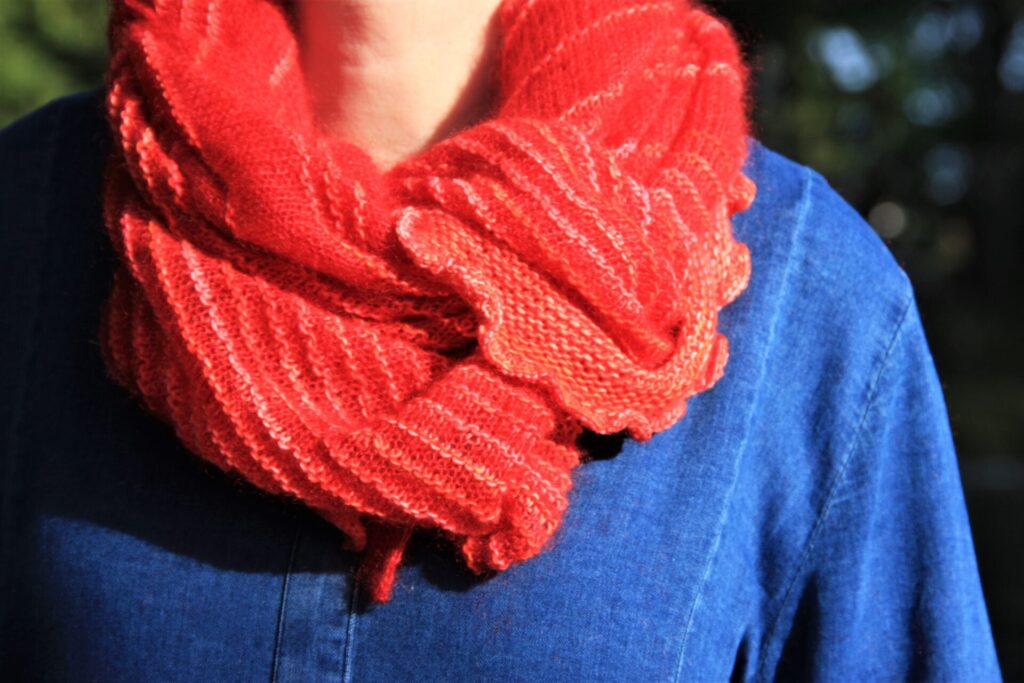
The shawl has a versatile shape and can tell many different stories, depending on the colours chosen. Choose icy shades for an arctic adventure, greys for a ghost story, greens for a jungle book, or………………… The possibilities are endless.
If you’d like to knit your own Story Lines,
you can find the pattern HERE ON RAVELRY.
In addition to the Dainty Droplets and Romantic Ruffle shown here, the pattern also includes instructions for a Basic Bind-off that ties everything up neatly. And there is a Dutch as well as an English-language version.
Well, that brings us to the end of today’s story. Thank you so much, dear photographer, for your patience and for capturing everything so well. And thank you, dear friends near and far, for reading and for your always kind support!
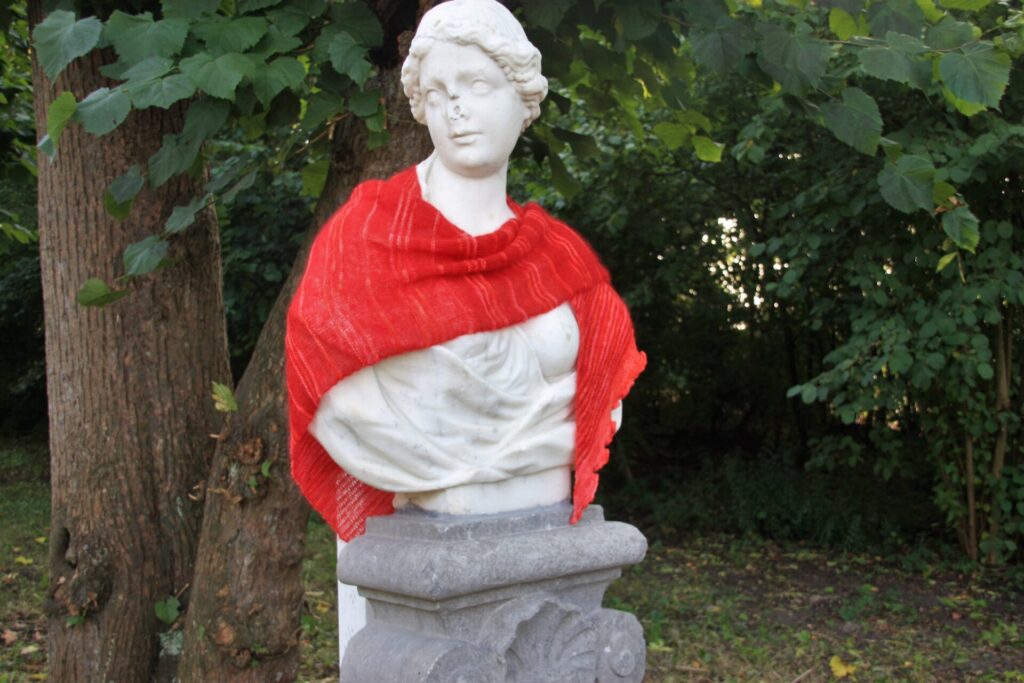
Gazelle Mitts
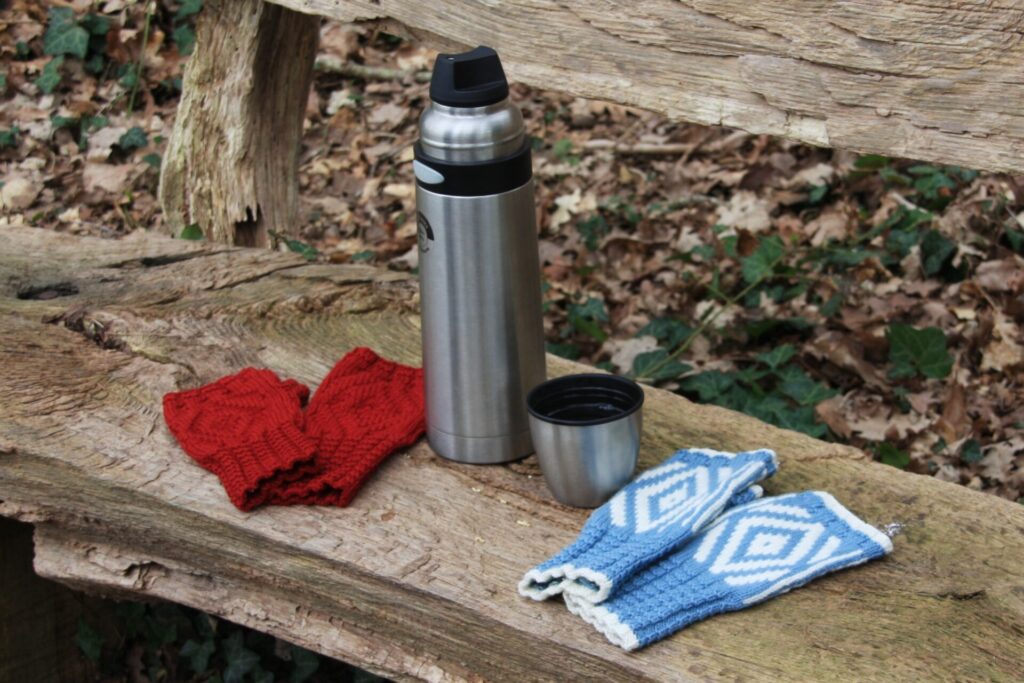
Hello!
Thank you so much for all your kind and supportive words after last week’s post, here and through other channels. While I’m writing this, we’re waiting for the plaster on our walls to dry with as many doors and windows open as possible. I’m using this quiet interlude before the next stage (ceiling repairs) for some focused work, and I’ve finally finished my pattern for a pair of fingerless mitts. Or rather, two pairs.
Meet the Gazelle Mitts!
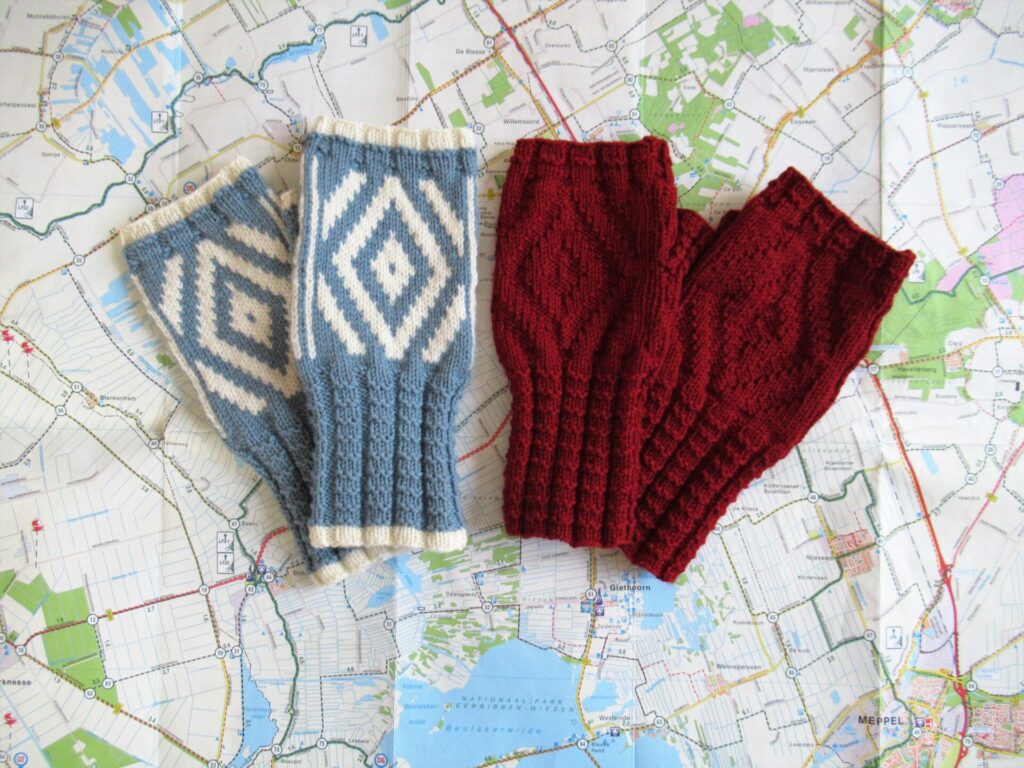
I’ll explain why I photographed them on a cycling map and with a thermos flask further on. First a little about the design.
Taking the inherited knitting sampler I’ve written about before as a starting point, I began visualizing, drawing, thinking, calculating and swatching. After lots of swatches and prototypes I was ready to knit the final mitts in a single-coloured and a two-coloured version. I already had the yarn, but kept changing my mind about which colours to use for which version.
Red and cream together and blue on its own? Or blue and cream together and red on its own? In the end I asked your advice, and you were unanimous: Blue and cream for the two-colour version and red on its own.
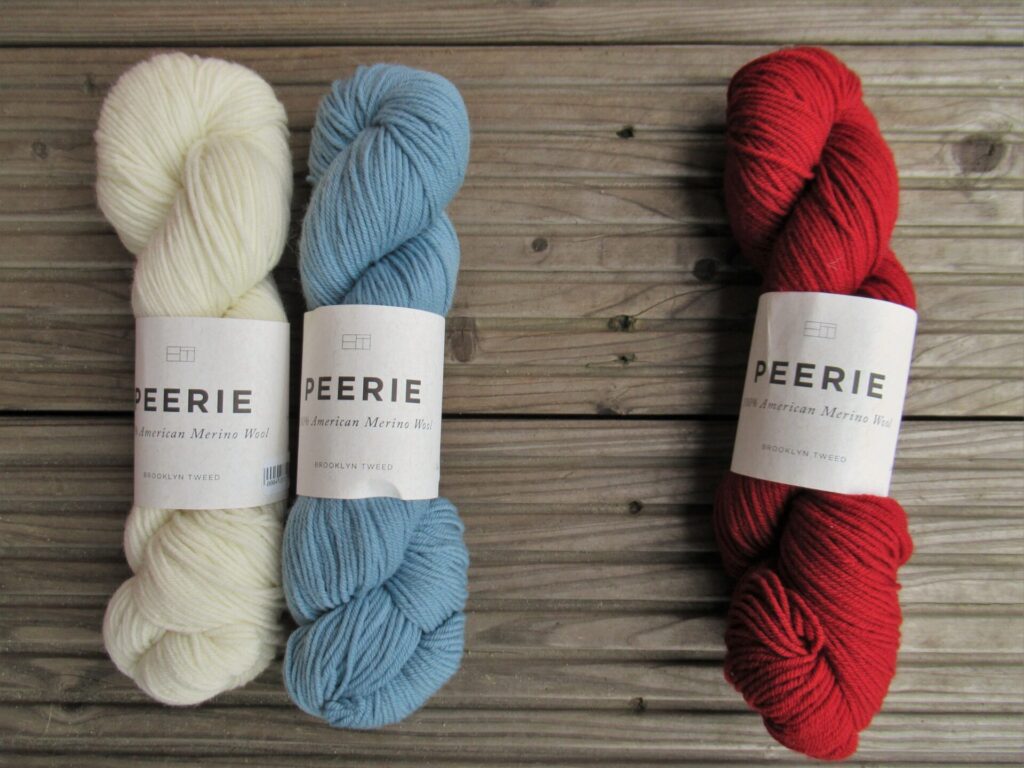
So that is how I knit them.
The red single-colour mitts combine three knit-and-purl stitch patterns from the sampler. For the palm of the hand, I used the sampler’s diagonals.
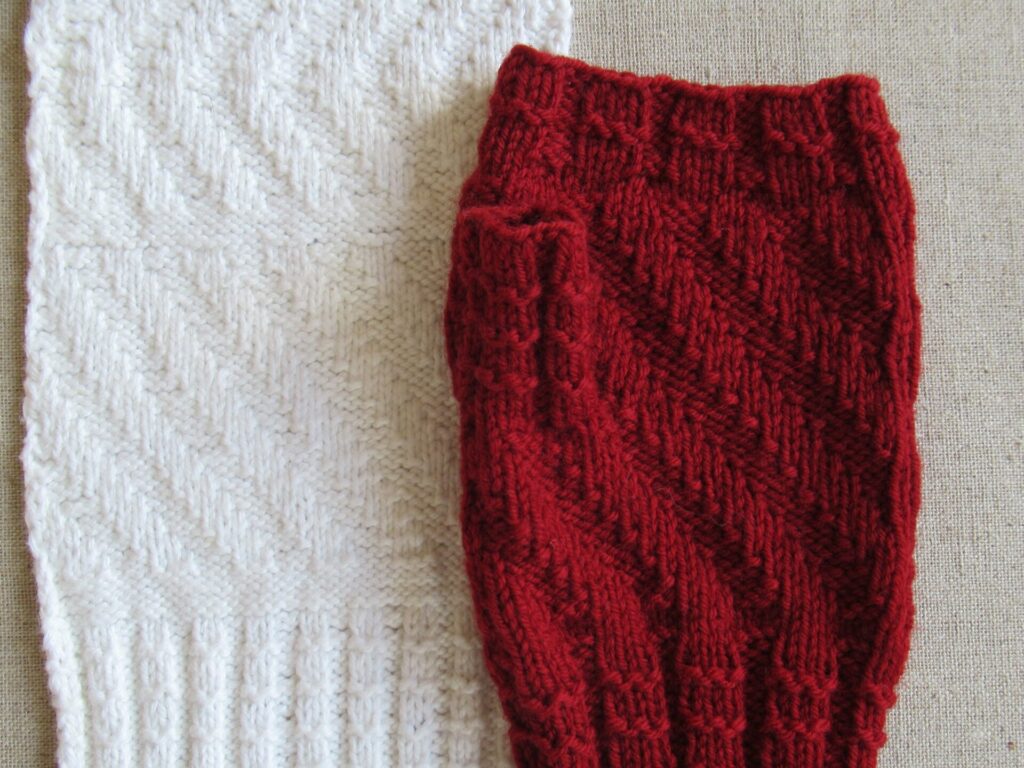
For the back of the hand, I took the zigzags and mirrored them to make diamonds.
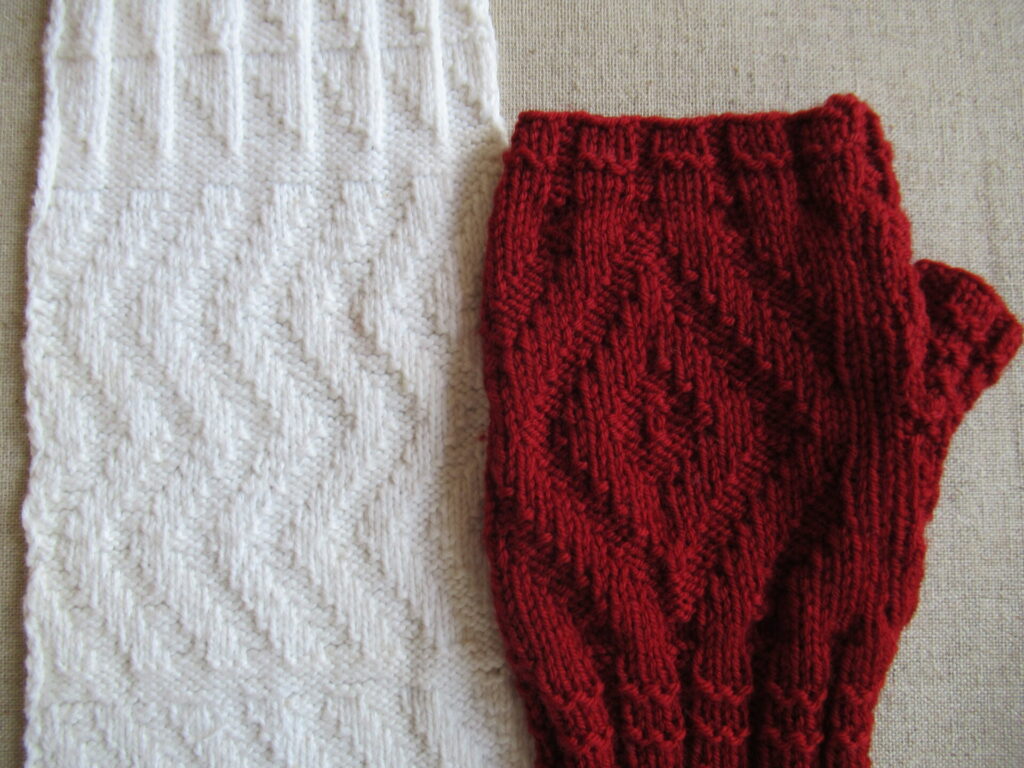
And a two-by-two knit-and-purl rib with purl ridges was perfect for the cuffs and thumbs. Only I changed it into a three-by-two rib to link it up with the diagonals and diamonds.
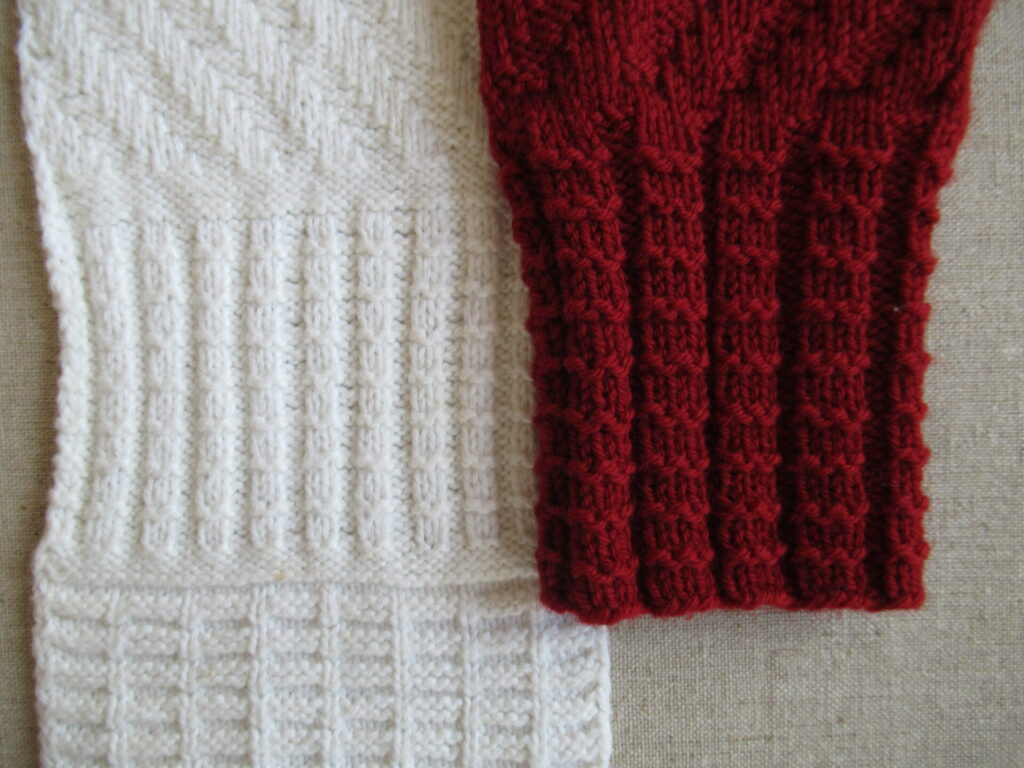
Although they look very different, the two-colour mitts are basically the same. They have the same diagonals and diamonds, and the same ribbing on cuffs and thumbs. Only this time instead of knit and purl stitches on the palm and back of the hands the patterns are knit entirely (no purling) and picked out in different colours.
Diagonals on the palms…
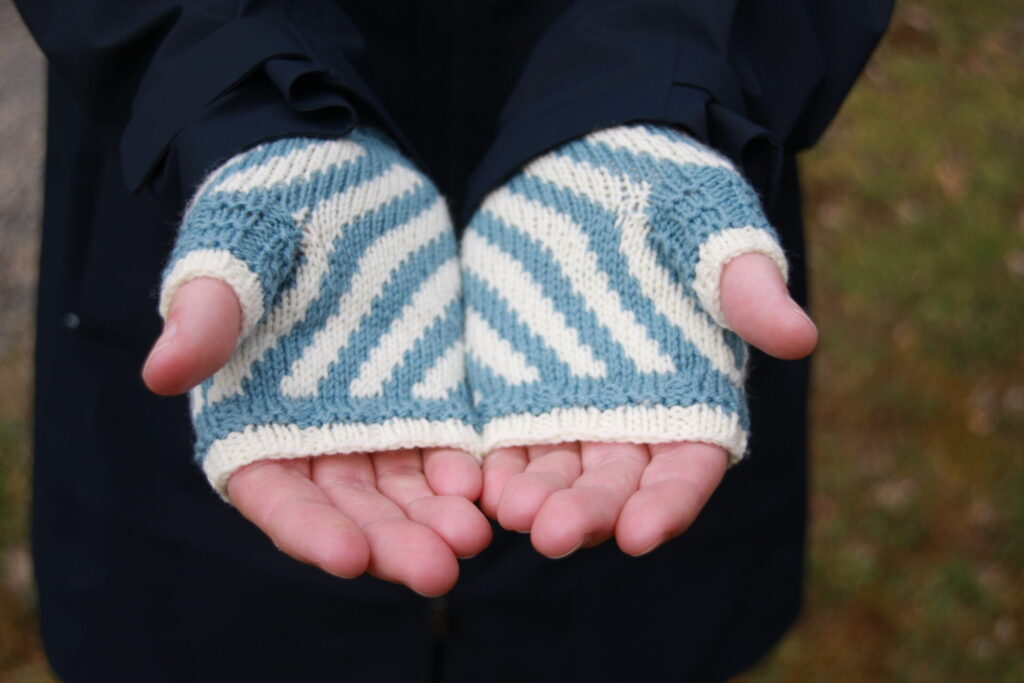
… and diamonds on the backs of the hands.
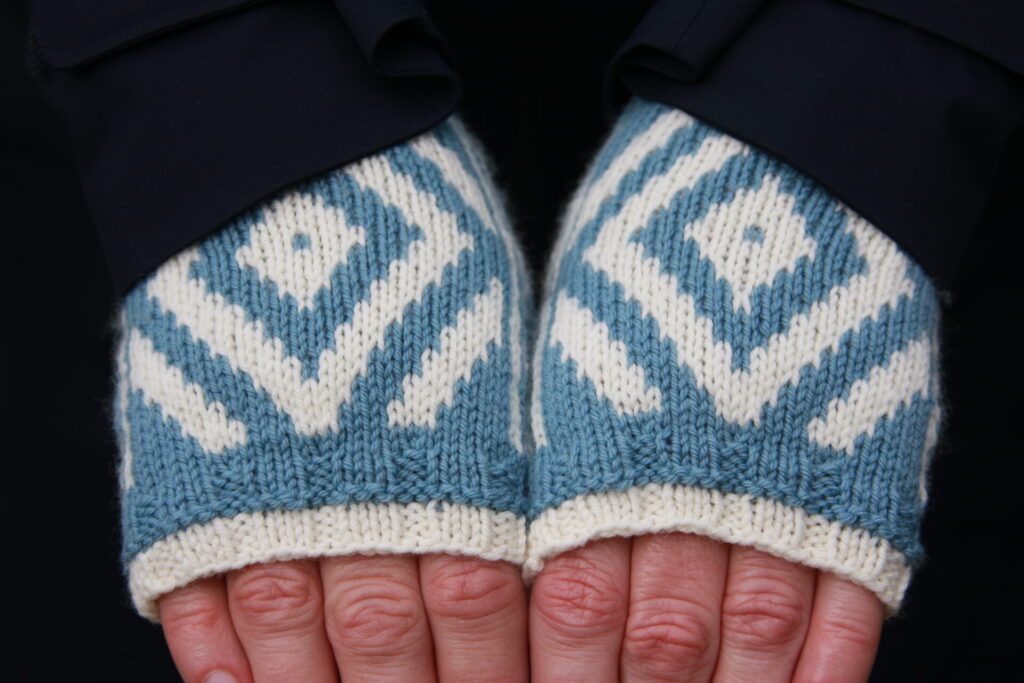
With bicycle rides on chilly days in mind, I named the mitts for my trusty Gazelle bicycle, my friend for over 15 years.
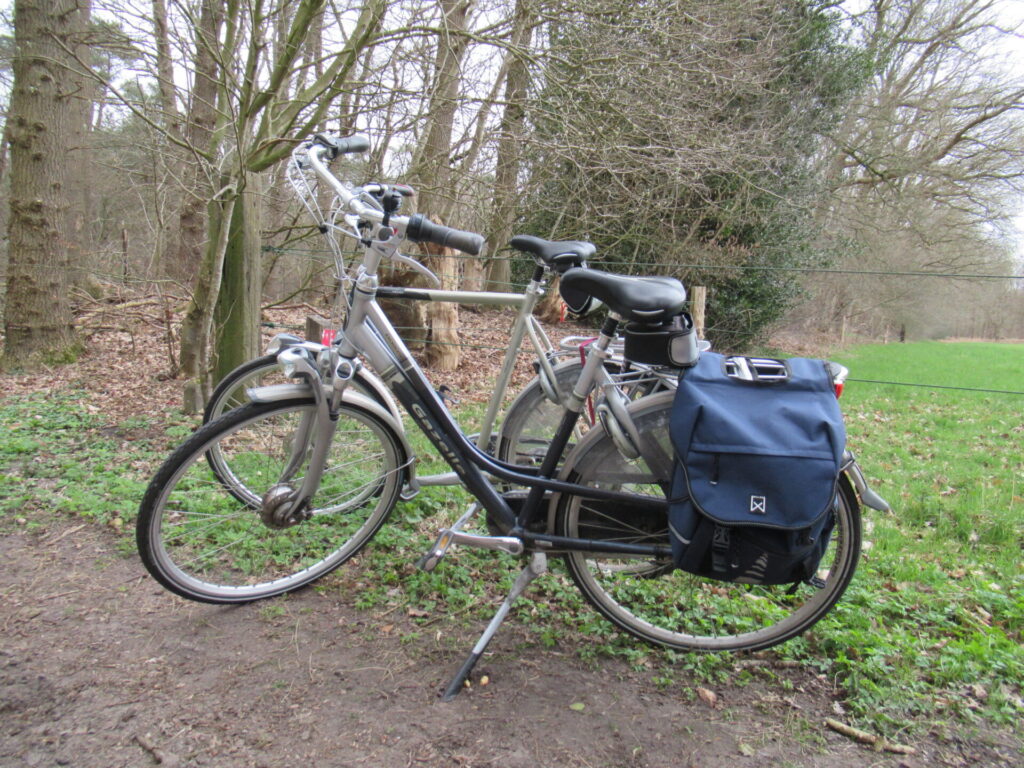
It gives me a sense of freedom and keeps me fit. I’m very much attached to it and not yet ready to trade it in for an e-bike like many people do nowadays.
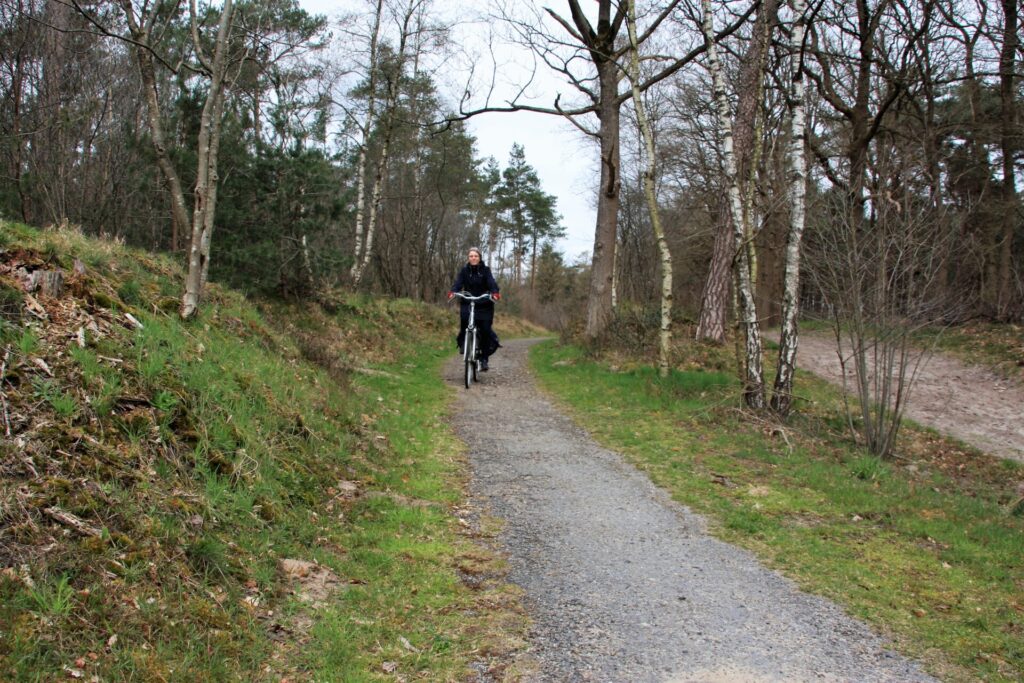
We (well, mainly my husband – thank you!) took most of the pictures for this post along one of my favourite stretches of bicycle track. It meanders through the wood just outside our village.
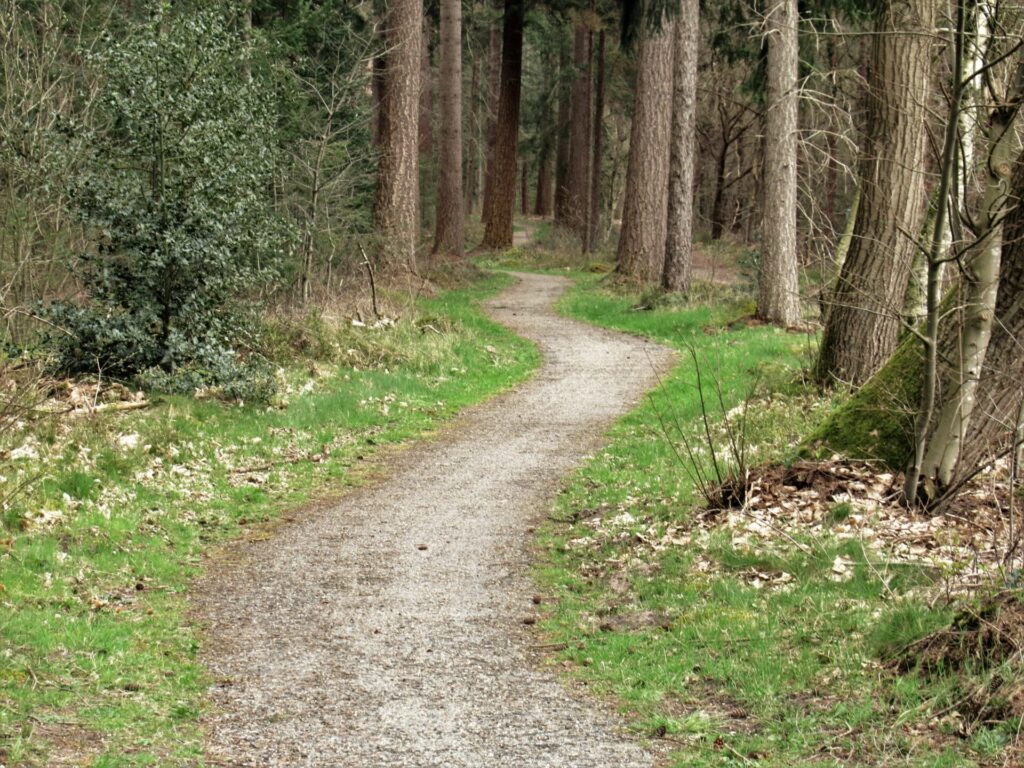
For the picture below, I’ve pulled up my coat sleeve to show you the nice and snug cuff.
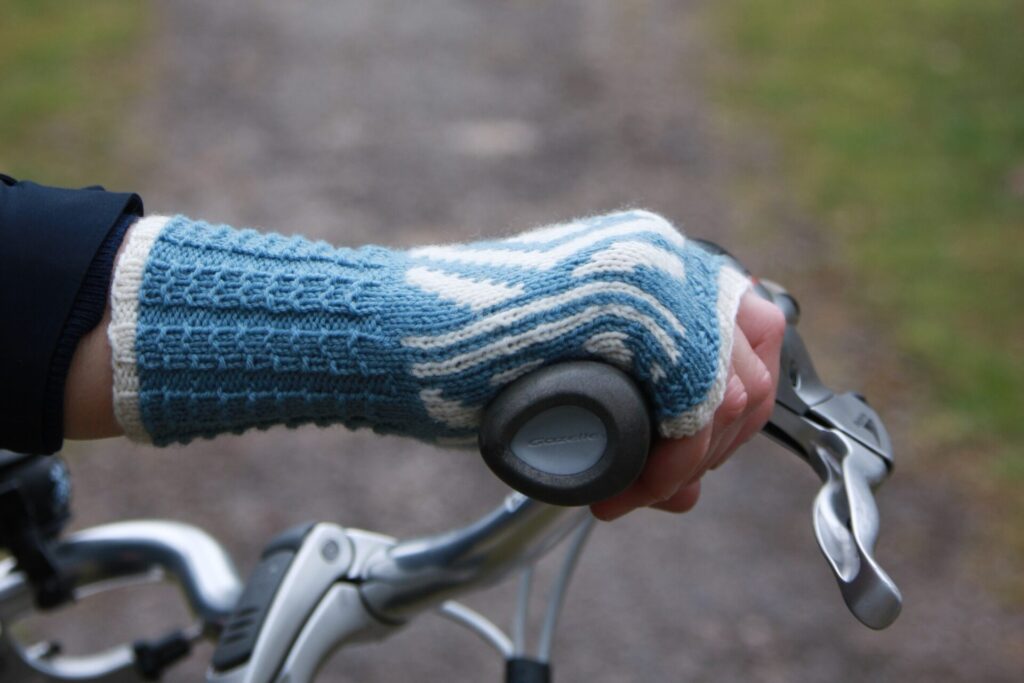
And here is a picture of my bicycle bell. It not only shows you the construction of the mitt’s thumb, but also tells you what my favourite beverage is. If I place my thumb on the teapot spout and release it, it gives off a sharp PING!
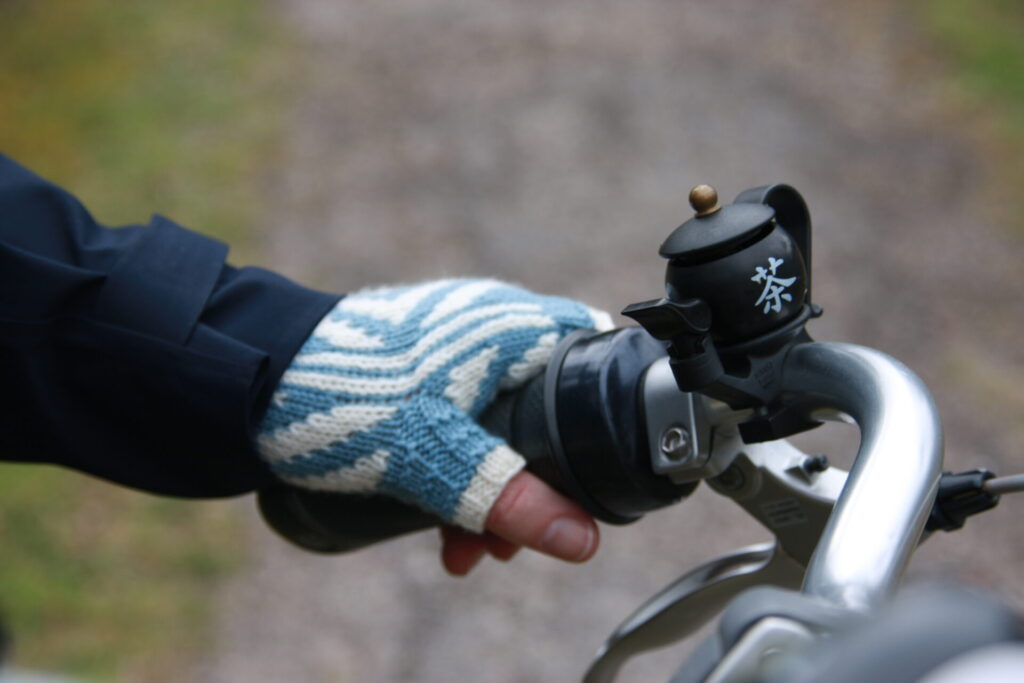
On longer bicycle rides, I often bring a thermos flask of tea. (Just for me – my husband prefers coffee.) Coffee-and-tea-to-go places have sprung up during the past year even around here, but they are still few and far between. And anyway I prefer my own.
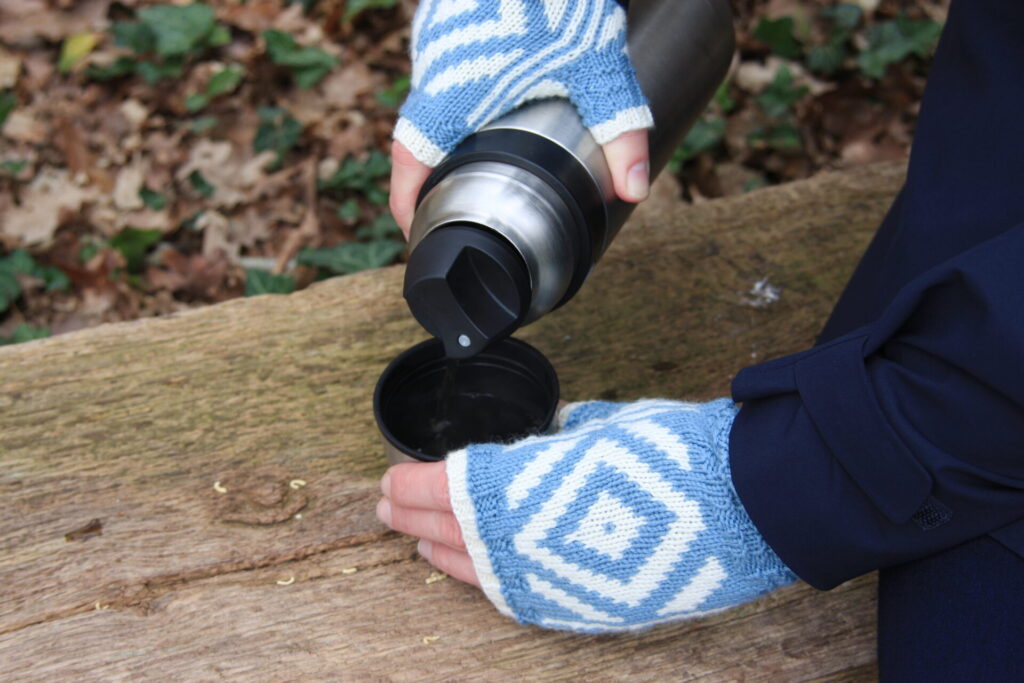
The Gazelle Mitts can be knit on a set of double-pointed needles or on long circulars using the Magic Loop method. Personally, I prefer double-pointed needles for the cuffs and thumbs…
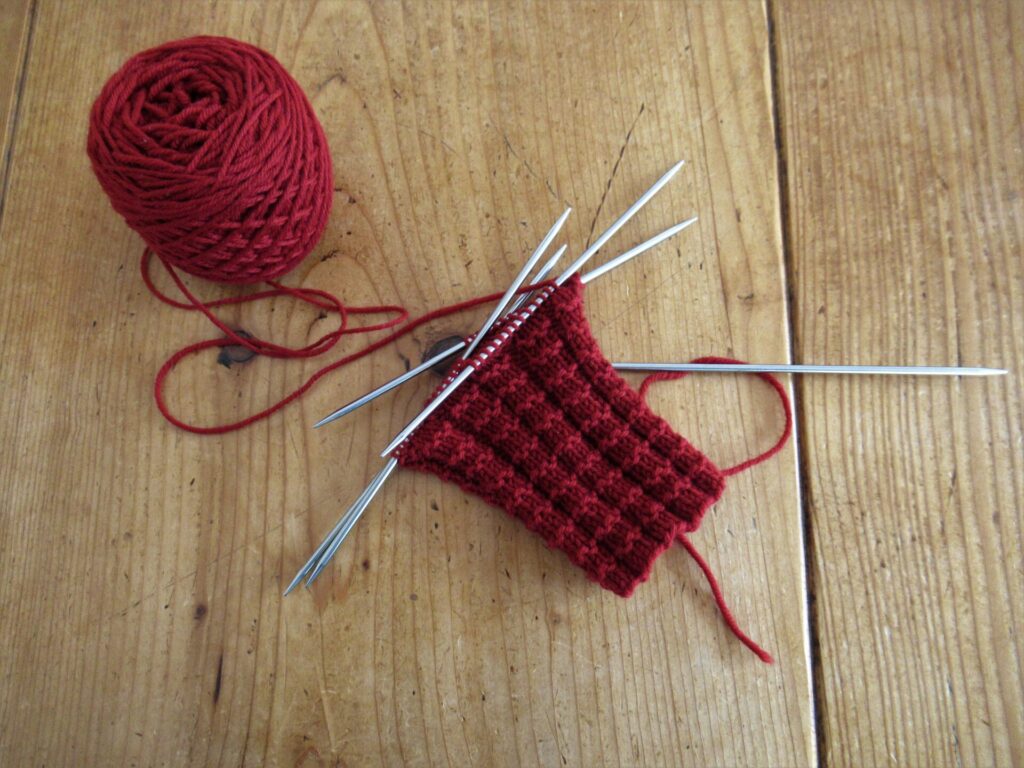
… and the Magic Loop method for the hands.
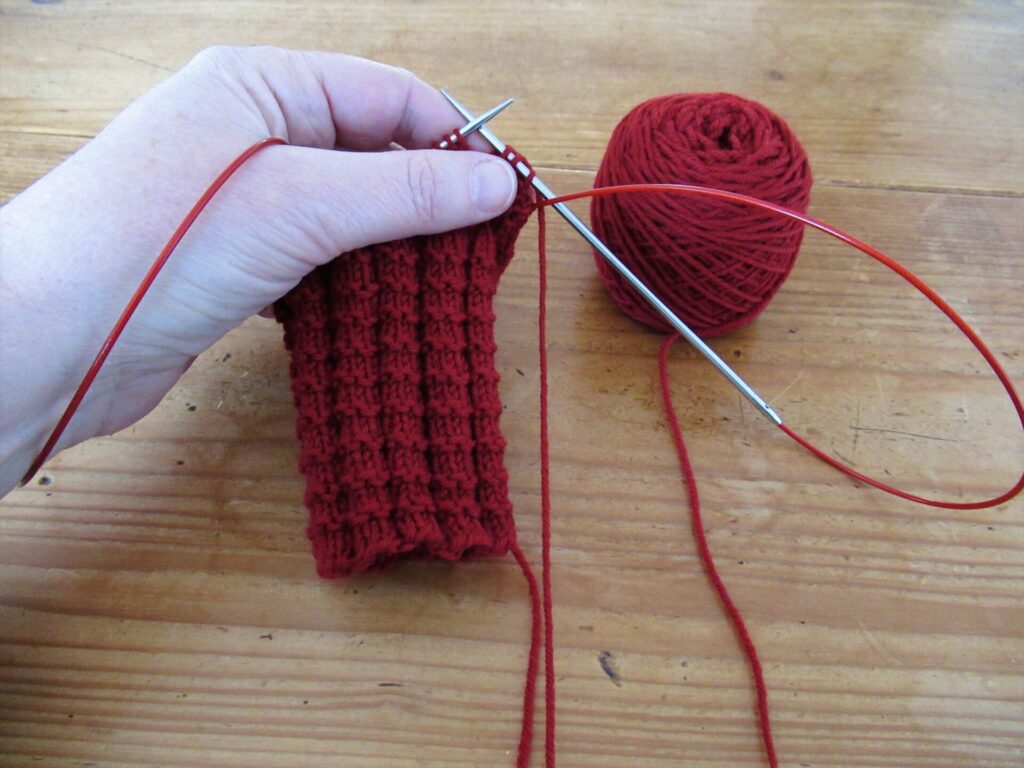
The yarn I’ve used is Brooklyn Tweed ‘Peerie’. One 50-gram skein for the single-colour mitts. And two 50-gram skeins in different colours for the two-colour version, with enough yarn left for a second pair with the colours reversed.
The Gazelle mitts can, of course, be knit in different yarns – I think that for instance many sock yarns are suitable. But should you decide to knit them, make sure your yarn is the same weight (fingering), and is smooth with a good stitch definition. And always check your gauge.
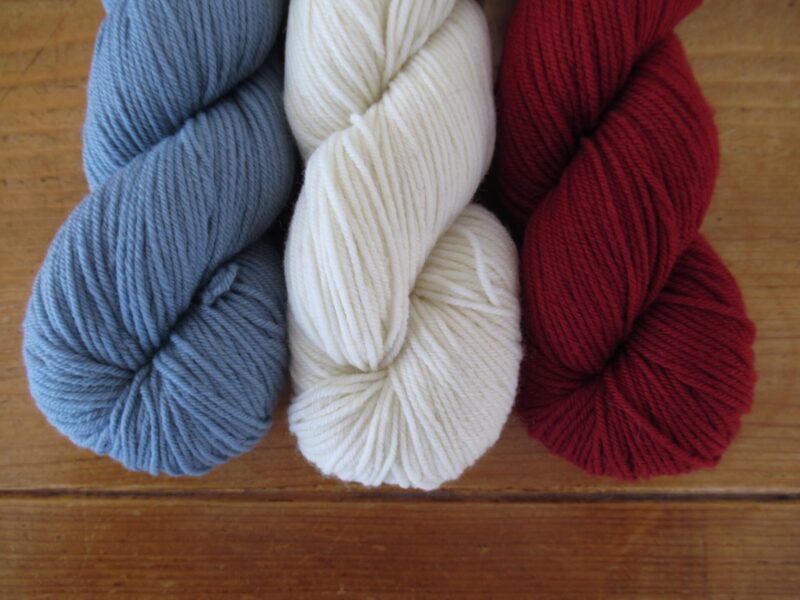
For those of you who’d like to make a pair,
The pattern for the Gazelle Mitts can be found here on Ravelry
(available in English and Dutch, also to non-Ravelry members)
There is more information there on needles & notions, finished measurements etcetera. I’ve done my utmost to make the pattern as clear as possible. Apart from detailed instructions, photographs of the mitts, and charts for the diagonals and diamonds, I’ve also included a photo tutorial for the ‘afterthought’ thumb.
Well, that’s all about my Gazelle Mitts for now. If you have any questions, please leave a comment here or contact me through Ravelry (my Ravelry name is MerulaDesigns). As always, thank you for reading!
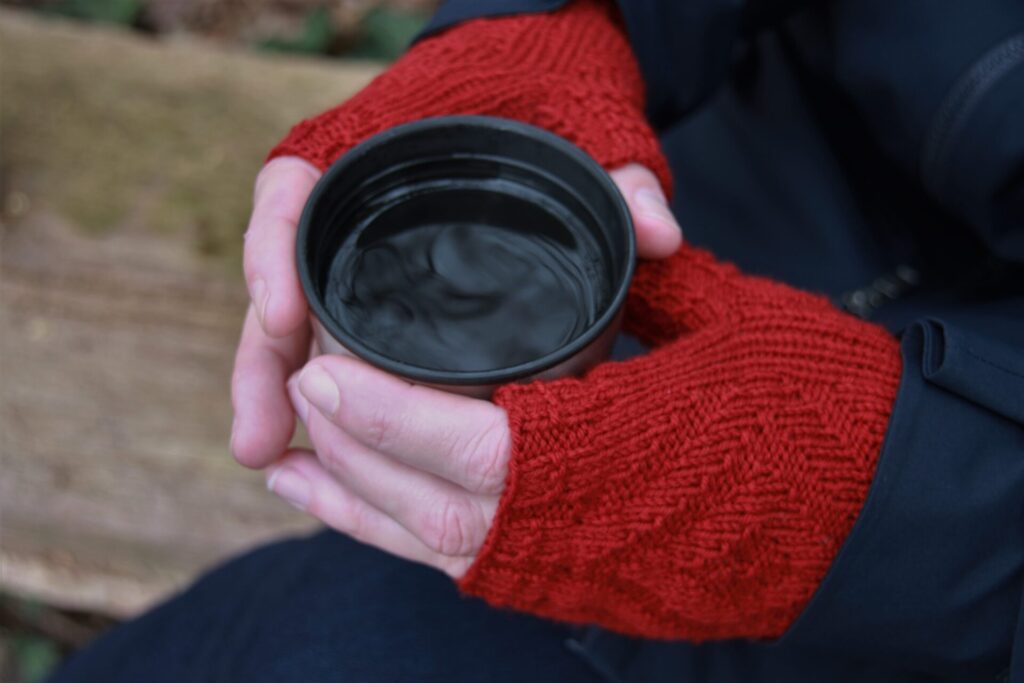
Thinking about Flow
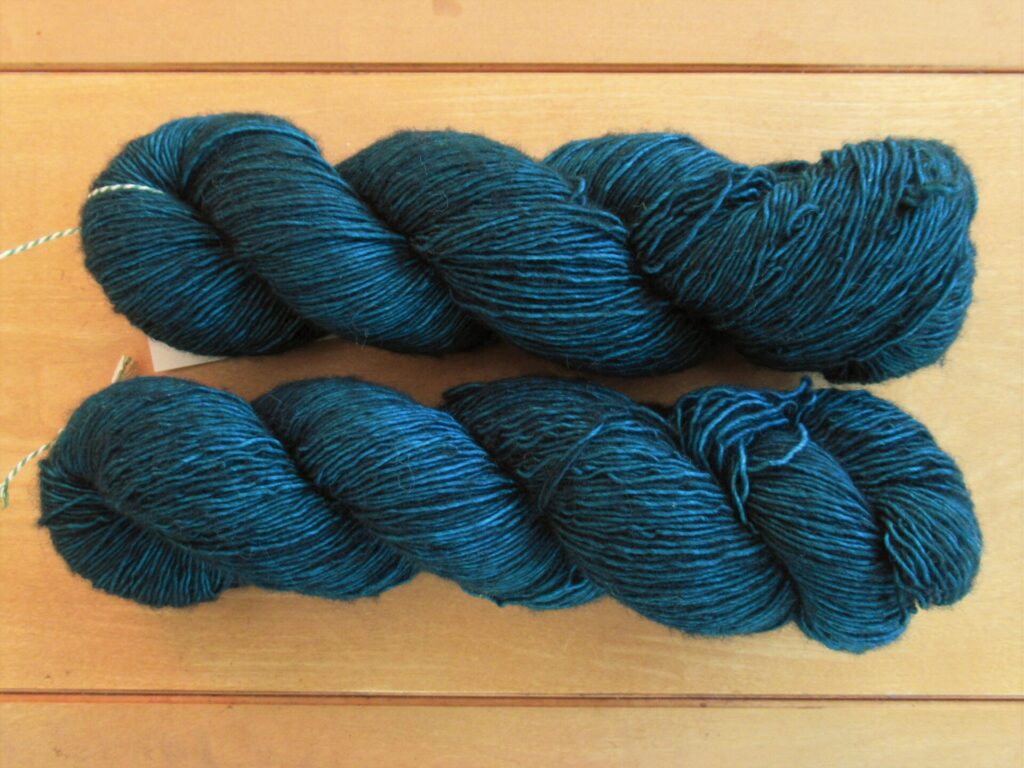
Hello!
(Because I think it would interrupt the flow of this blog post too much to insert links into the actual text, I’ve added a list at the bottom.)
It was yarn that first made me think about flow. Two skeins of a beautiful blue-green yarn hand dyed by Catharina at Wolverhalen. I chose this colour first of all because it caught my eye. The name – Flow – was of secondary importance, but it did catch my attention.
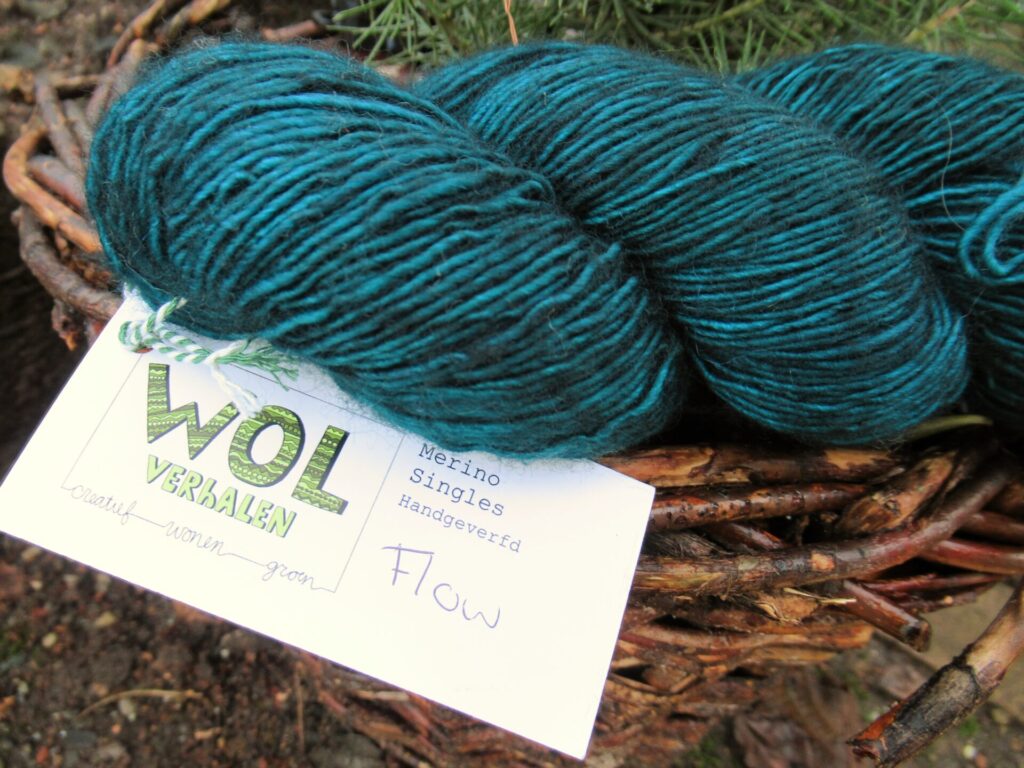
I asked Catharina about it, and she told me that she dyes a whole series of colours named for states of mind. Flow is one of them. Others are Positivity, Wisdom, Joy, Passion, Faith, and Stillness.
Flow… What exactly is it? It makes me think of water.
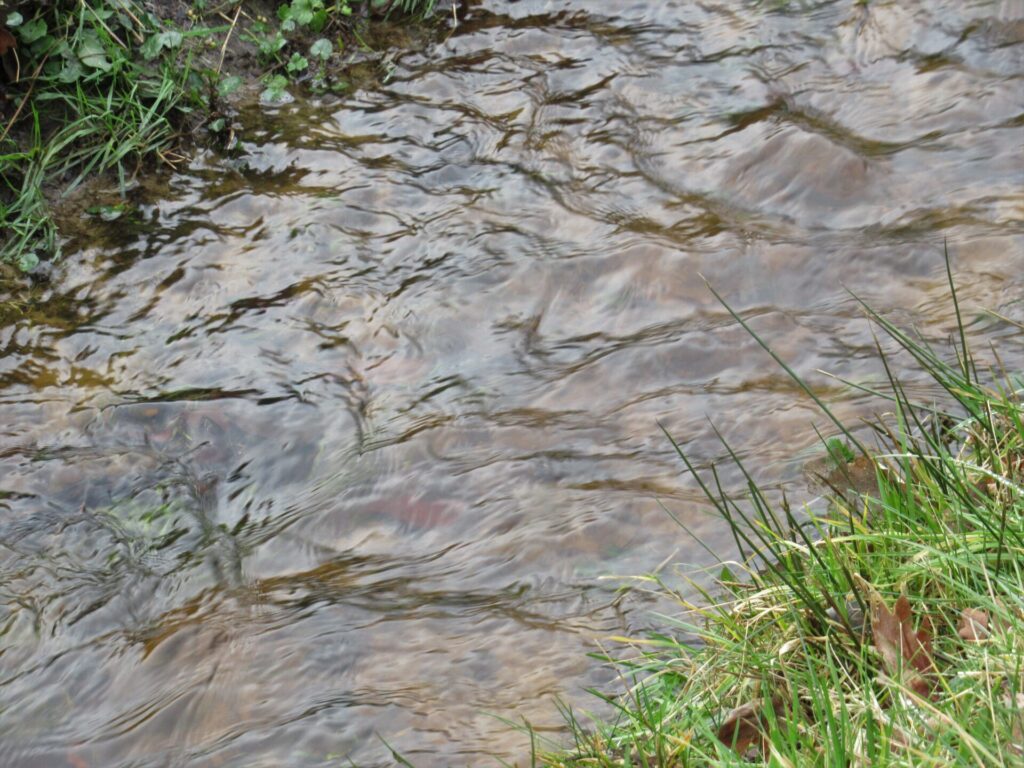
It also makes me think of somebody with the unpronounceable name Mihaly Csikszentmihalyi. In my previous life as a translator, I’ve translated many psychology books and articles. During my background reading, I repeatedly came across his research.
In his famous book Flow: The psychology of optimal experience (that I haven’t read), he defines flow as: ‘…the state in which people are so involved in an activity that nothing else seems to matter…’ It is a particular kind of focus that seems to lead to intense feelings of happiness.
Am I ever in a state of flow? I don’t really know.
I used the flow yarn to knit another Thús 2 – a design I published in November last year.
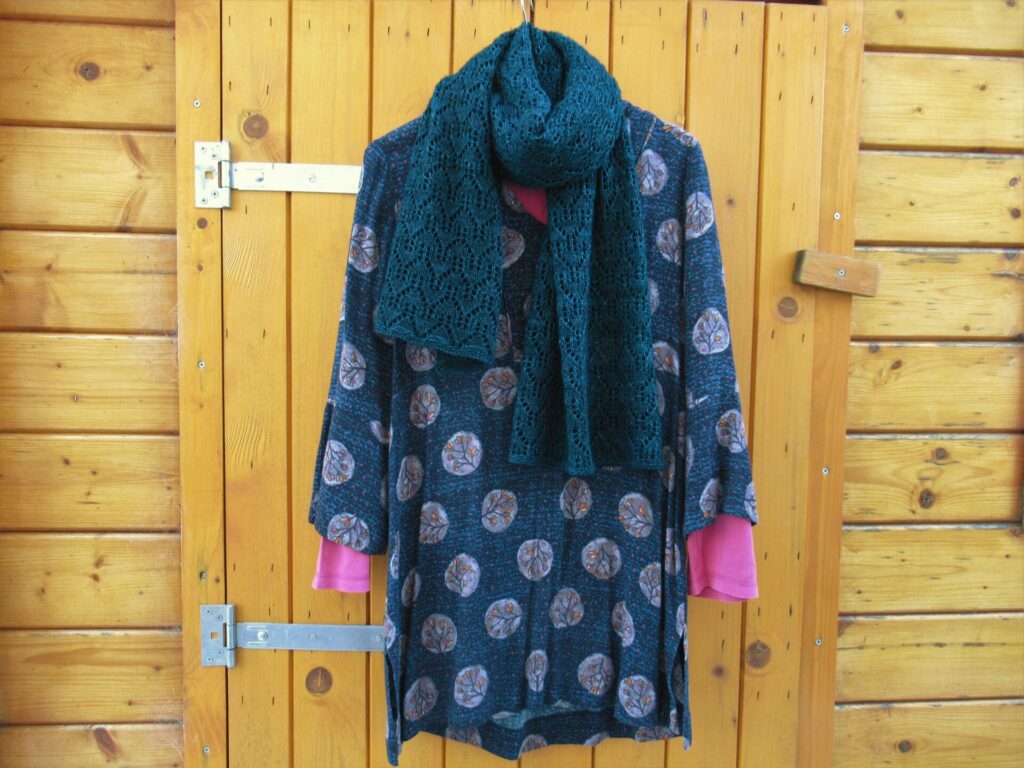
Am I in flow when I’m knitting? Or when I’m designing a pattern?
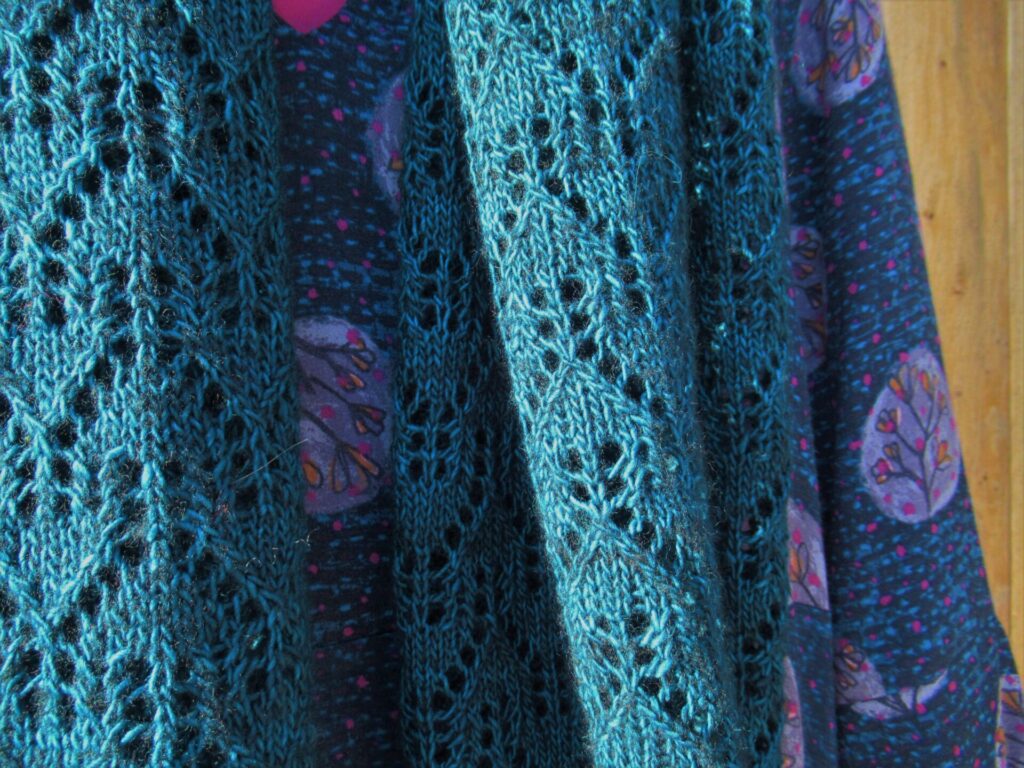
Or when I’m faffing about with photography?
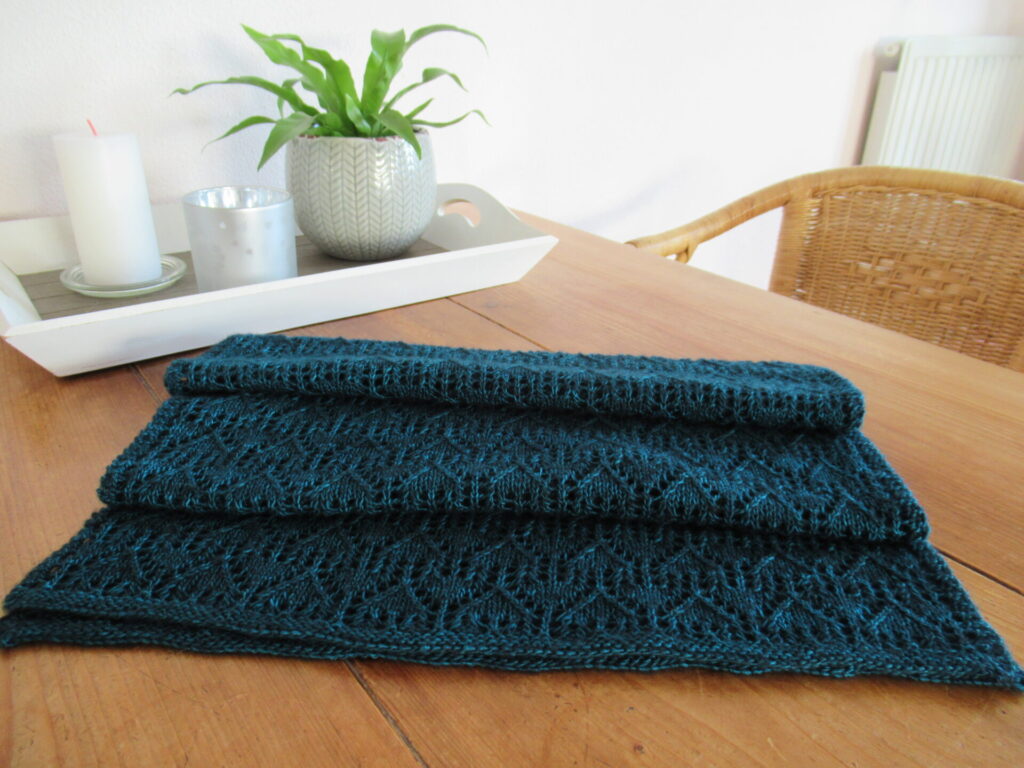
Or when I’m writing? Or when I’m doing other things entirely? Yes, no, well, maybe, sometimes…
Flow as a yarn colour is something that makes me happy. Flow as a state of mind is something I’d like to know more about. Are people generally aware of being in this flow state? What does it take to get there?
Flow is also a Dutch magazine that I sometimes buy. In the editors’ words, it is about ‘Celebrating creativity, imperfection and life’s little pleasures’. This is the first issue of 2021.
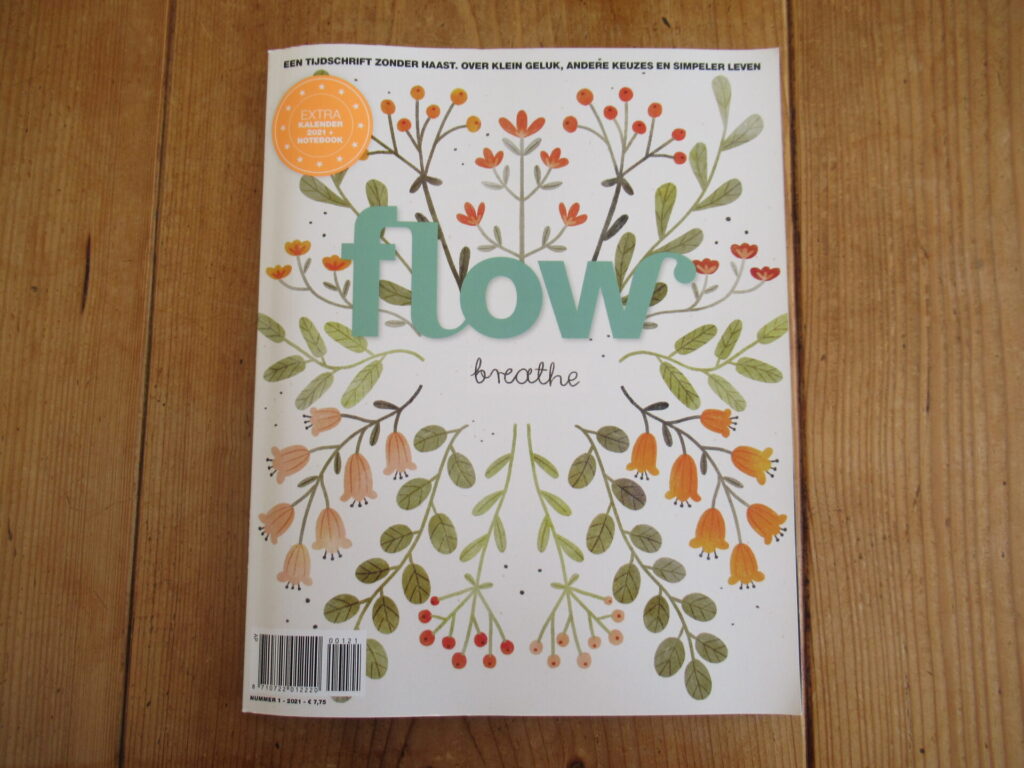
There used to be and English edition as well, but they’ve recently stopped publishing that. They do still have an interesting English-language website, and back issues and specials are still available.
My favourite articles in the latest issue are about navigating life in uncertain times and about tools for people working from home. And the item about Aheneah, a Portuguese artist who does cross stitch on a large scale, made me smile.
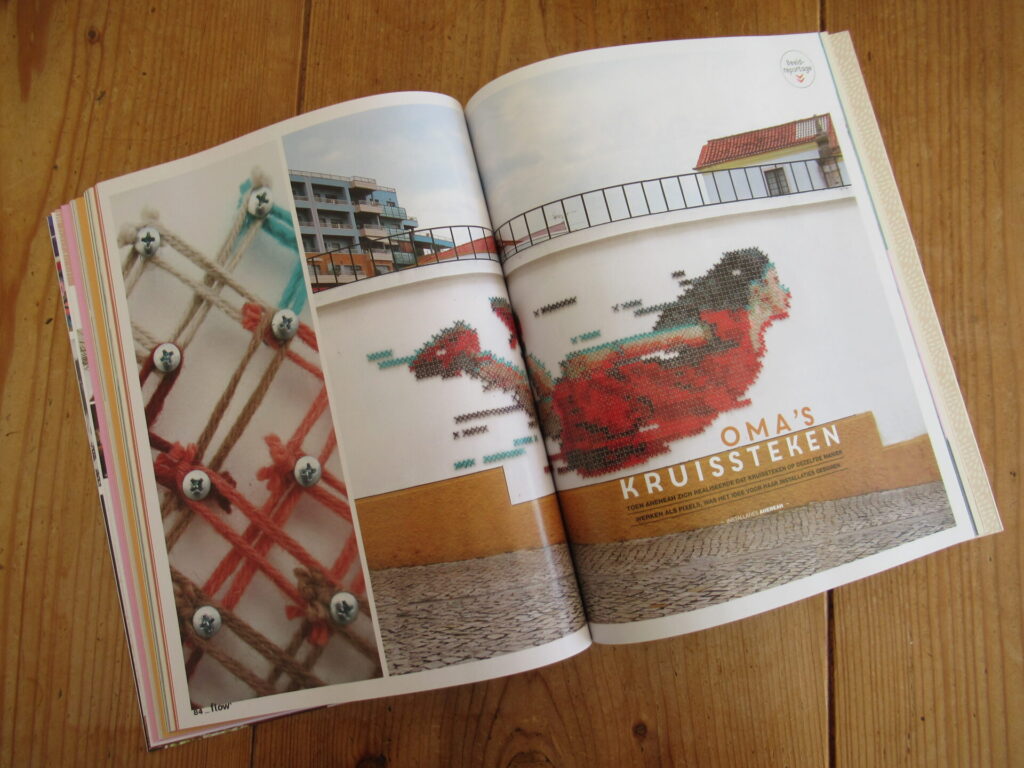
The message Aheneah gives off with her installations is to think outside the box and look at one’s roots and traditional techniques as things that can be transformed in unexpected ways and so given a new lease of life.
I’m ending today’s post with a poem by Wilder Poetry that really spoke to me. It comes from the Flow ‘Calm Down’ special.
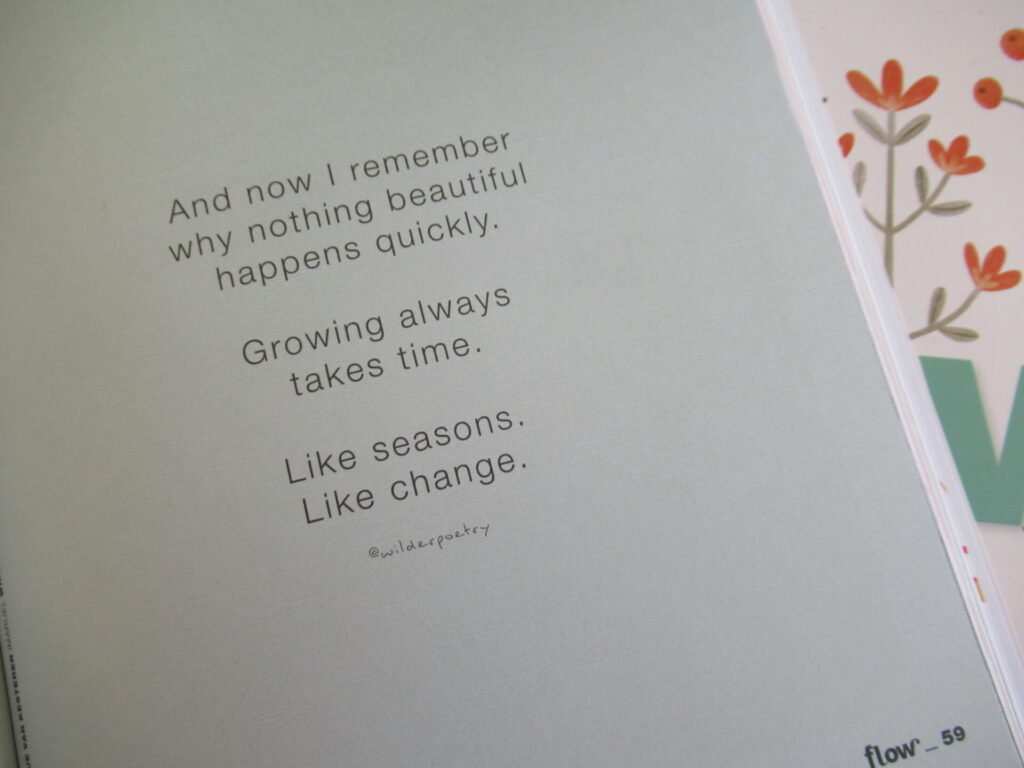
Thank you for reading!
If you’d like to read more (or knit your own Thús 2), here is a list of links:
- Thús 2 (free) pattern on Ravelry
- Blog post about Thús 2
- Wolverhalen website (I used 2 skeins of her Merino Singles)
- Blog posts about my visits to Wolverhalen here and here
- Mihaly Csikszentmihalyi’s webpage
- Flow Magazine English and Dutch website
- Aheneah on Instagram
- Nocturnal, Wilder Poetry’s collection of poems
Knitting Spa
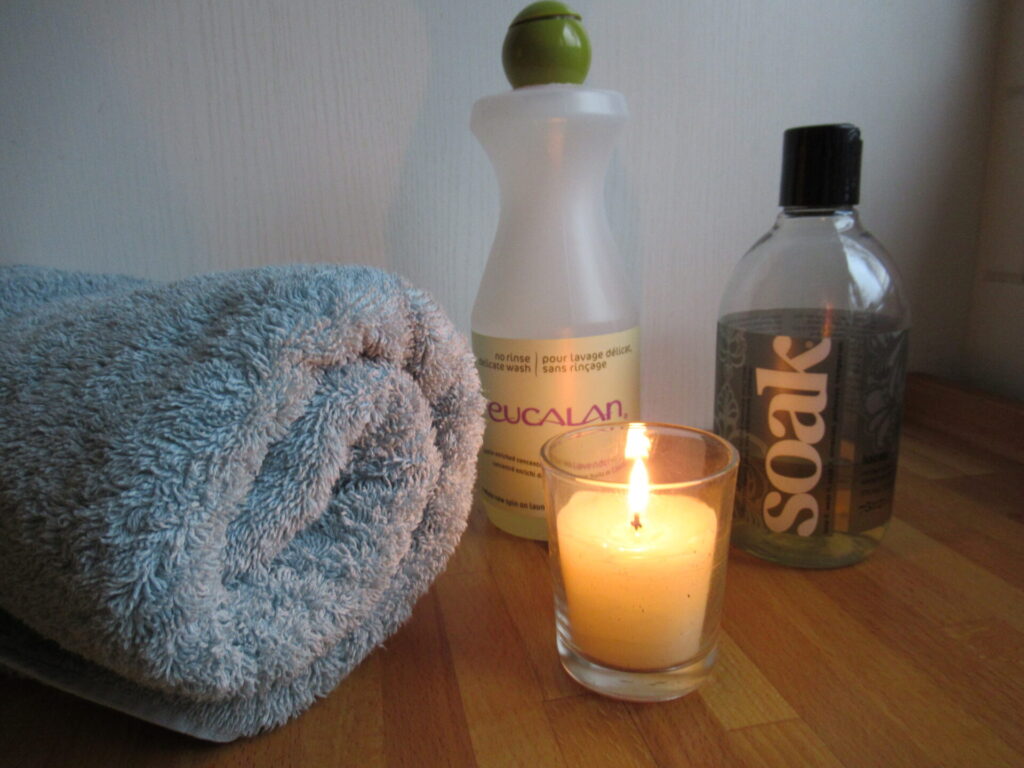
Hello!
OK, complete focus on knitting today – no tangents or digressions. Maybe this is all old hat to you, but I thought I’d show you what happens to my knitwork after the actual knitting is finished and the ends have been darned in.
Last week I said the hat and scarf I made for my brother needed some TLC to relax. Well, they got more than just some TLC – they received a full 4-star spa treatment!
It all started with a bubble bath.
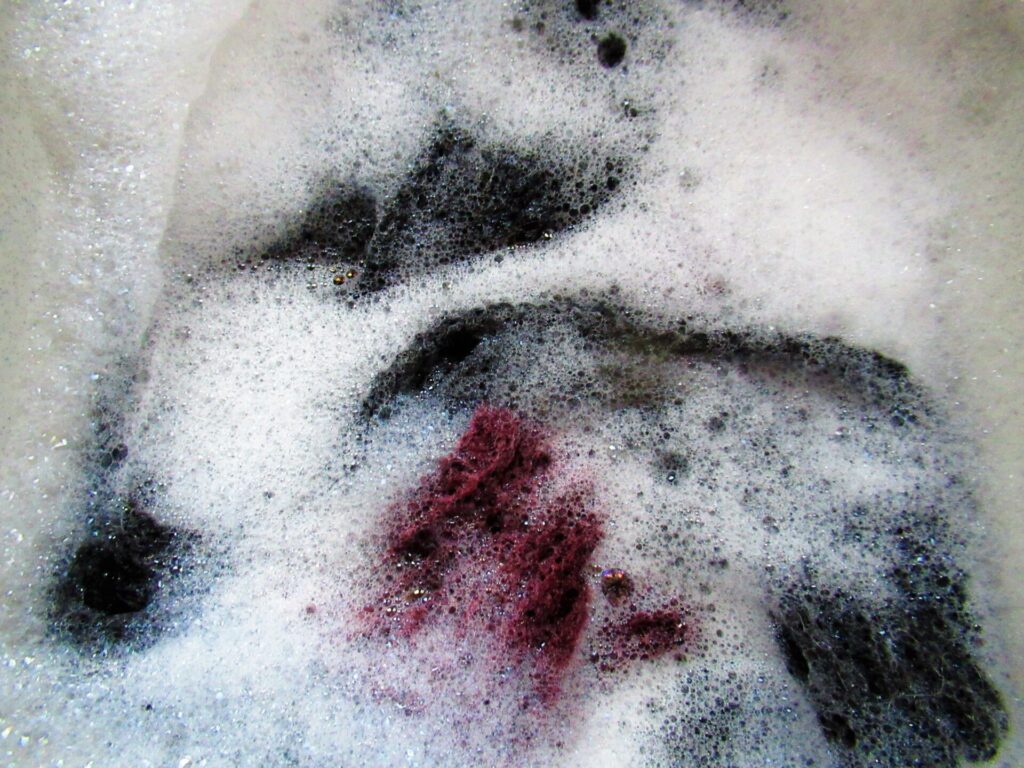
Aaaaah, so relaxing, especially when combined with aromatherapy. To make the bubbles, I use a no-rinse detergent for delicate fabrics – Eucalan or Soak. There may be other brands, but these are the only two I know.
I can’t say that I prefer one to the other. Eucalan is sort of syrupy and yellowish, whereas Soak is thinner and clear. Both are available in various lovely scents. The Eucalan I have has a very mild lavender scent. My Soak favourite is Lacey, a subtle flowery scent that is harder to pinpoint.
Only a teaspoon of detergent is needed, so a bottle lasts forever. Both also come in small trial packages, that are ideal not only to try out the products, but also to tuck in with a knitted gift.
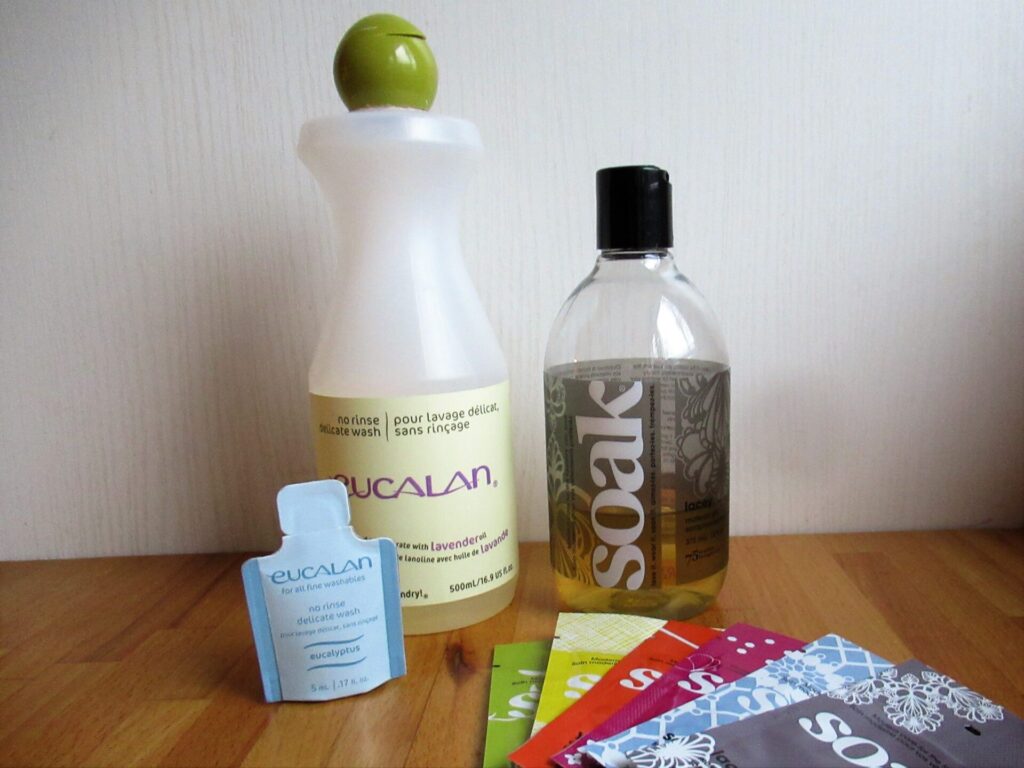
As their name says, no-rinse detergents do not need to be rinsed out. After a bubble bath of about 30 minutes, I first gently squeeze out most of the moisture. After that I’d roll a more fragile knit in a towel to squeeze out more water, but robust knits like these I put in the spin dryer.
Now, still slightly moist, the scarf and the hat get different wellness treatments, tailored to their specific needs. I thought the scarf would benefit from acupuncture, while some steam would be best for the hat.
First the scarf. These are my acupuncture (in knitting terms also known as blocking) tools.
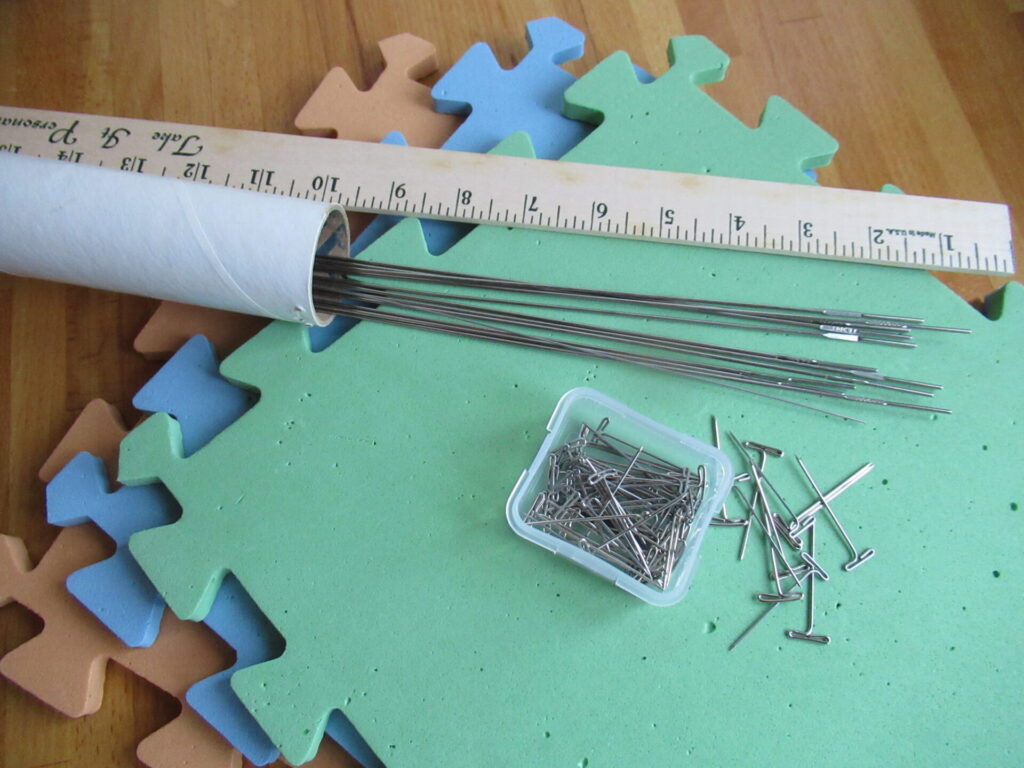
Foam blocking mats, blocking wires (that come with a wooden ruler), and T-pins (stainless steel pins in the shape of a capital T). At first I used this kit only for lace knits, but now I’m using it for many other projects, too.
I threaded wires along the long sides of the scarf, between the edge stitch and the next, going up and down every other row.
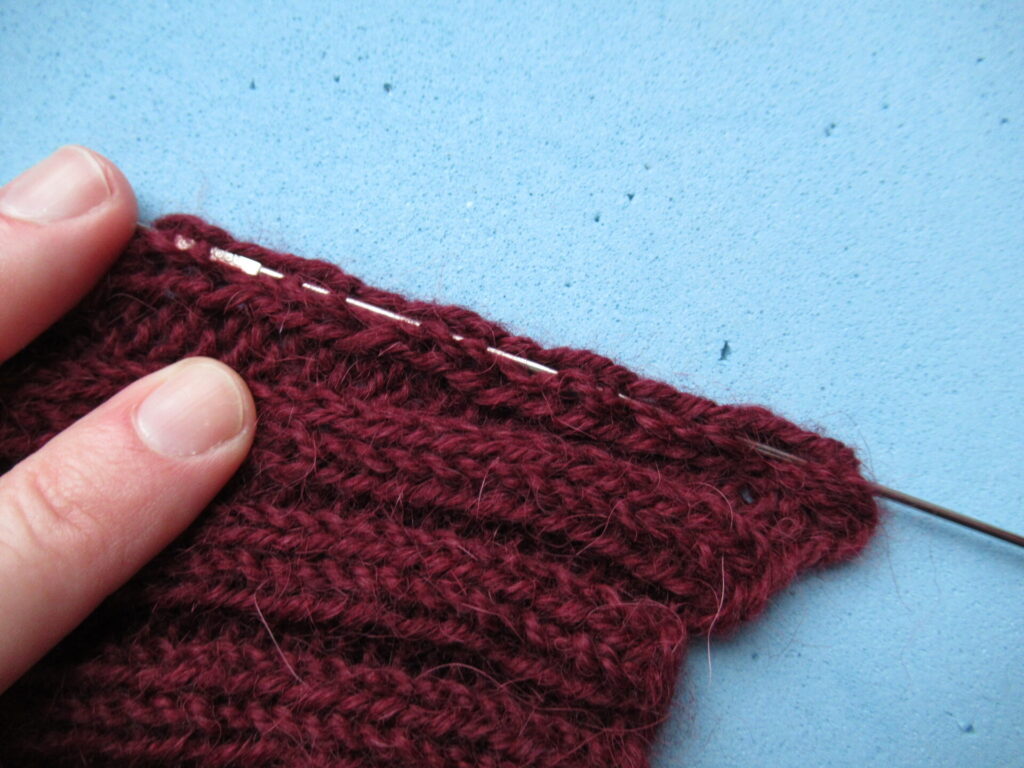
Then I pinned it onto the blocking mats, smoothing the scarf out along its length and pulling firmly widthwise. (Never do this on a wooden table or floor – the T-pins may prick through the mats and damage the surface underneath.)
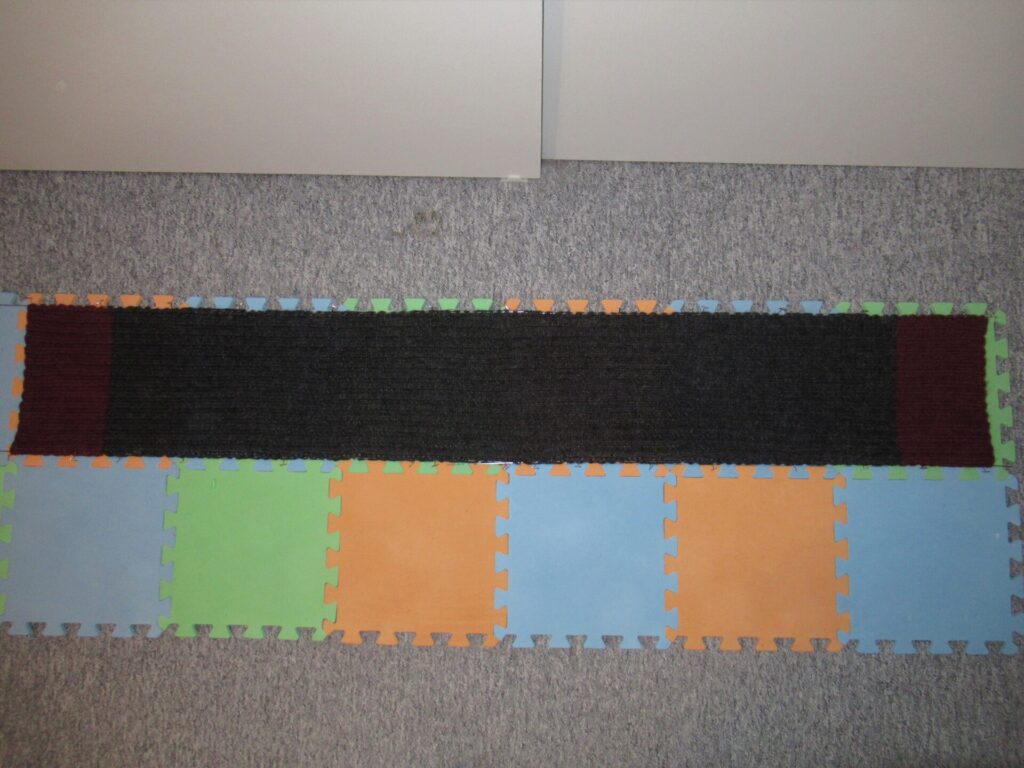
And here is a close-up. I hope you can see the wires and T-pins.
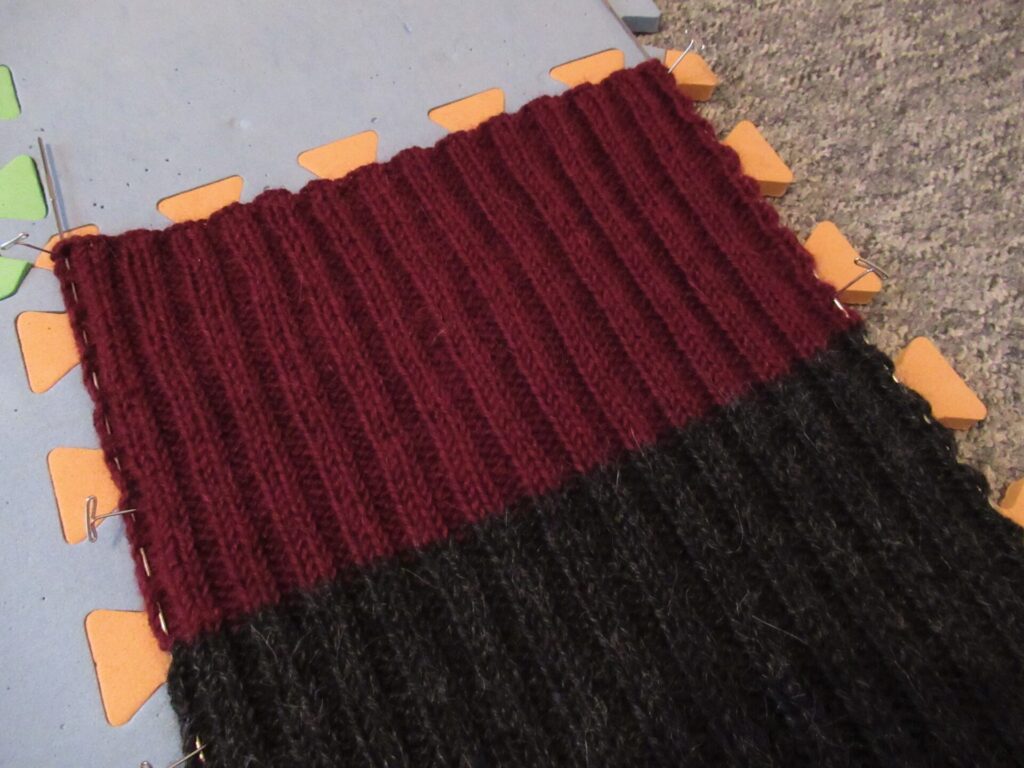
Now, let’s leave that to dry and continue with its mate. The still moist hat is pulled around the end of the ironing board.
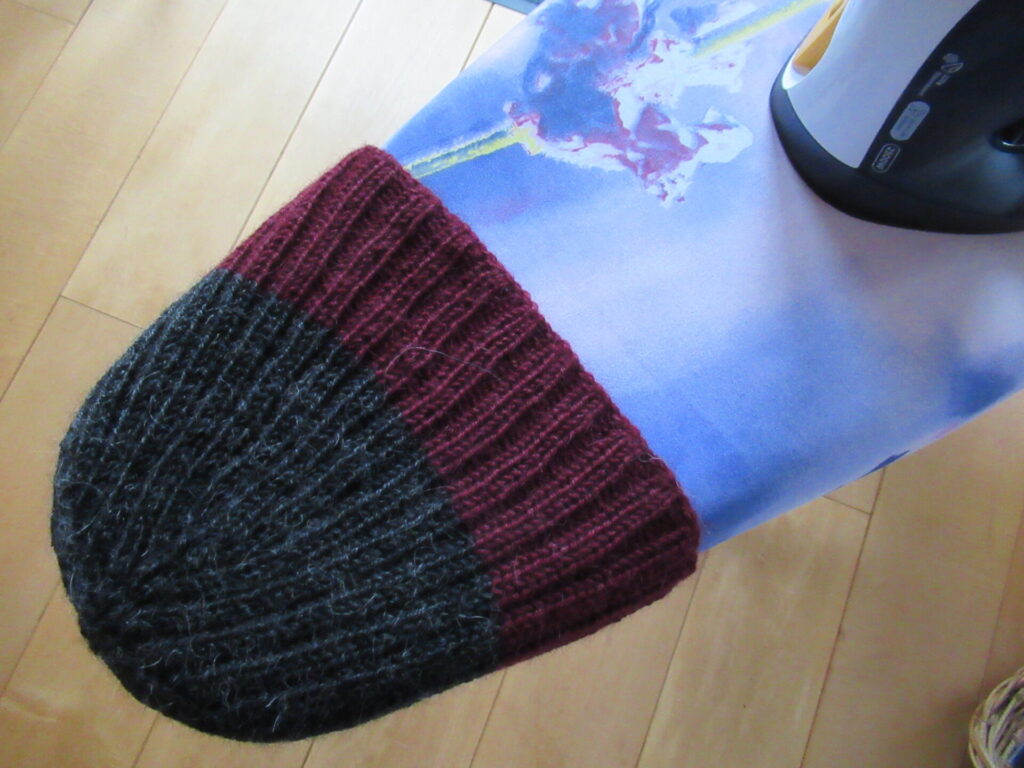
Then it is covered with a moist press cloth (i.e. an old tea towel that doesn’t give off colour) and steam-pressed. I used the lowest setting that will give steam (silk/wool). If the picture looks slightly blurry, that’s the steam.
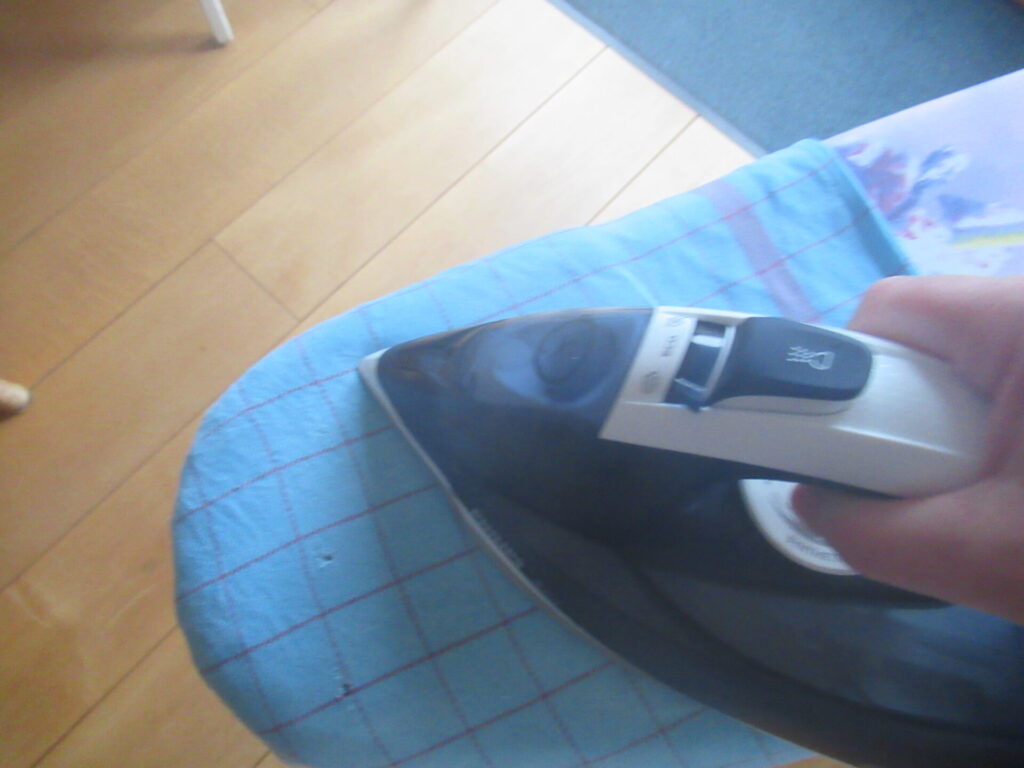
I tried all this out on a swatch first, to make sure nothing terrible (like felting) happened to my ‘clients’ and they would benefit from their treatments.
After pressing the hat was still slightly wet and I placed it on the blocking mats with the scarf. Twenty-four hours later everything was dry and I unpinned the scarf.
A lot of work for a simple hat and scarf. Is it really worth all the effort? I think it is – very much so. I took before and after pictures, but unfortunately they are not very clear because of the dark yarn colour and the dark weather.
Here are the hat and scarf (before on the left and after on the right):

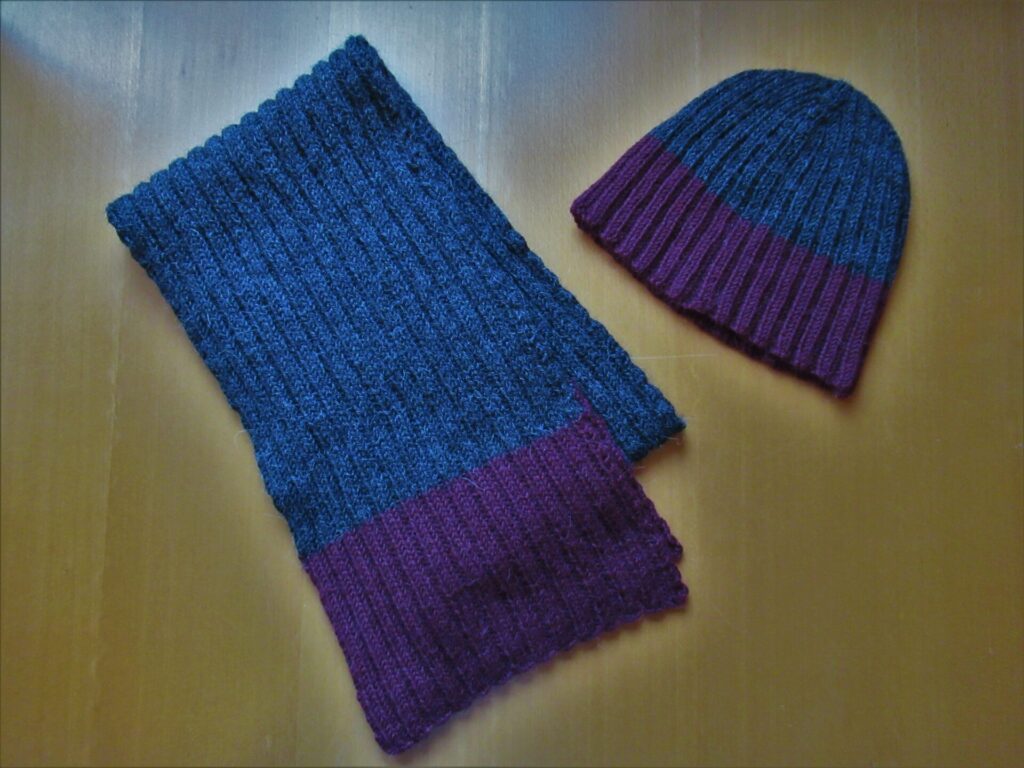
And here is a close-up of the k2, p2 rib pattern (again before left and after right):
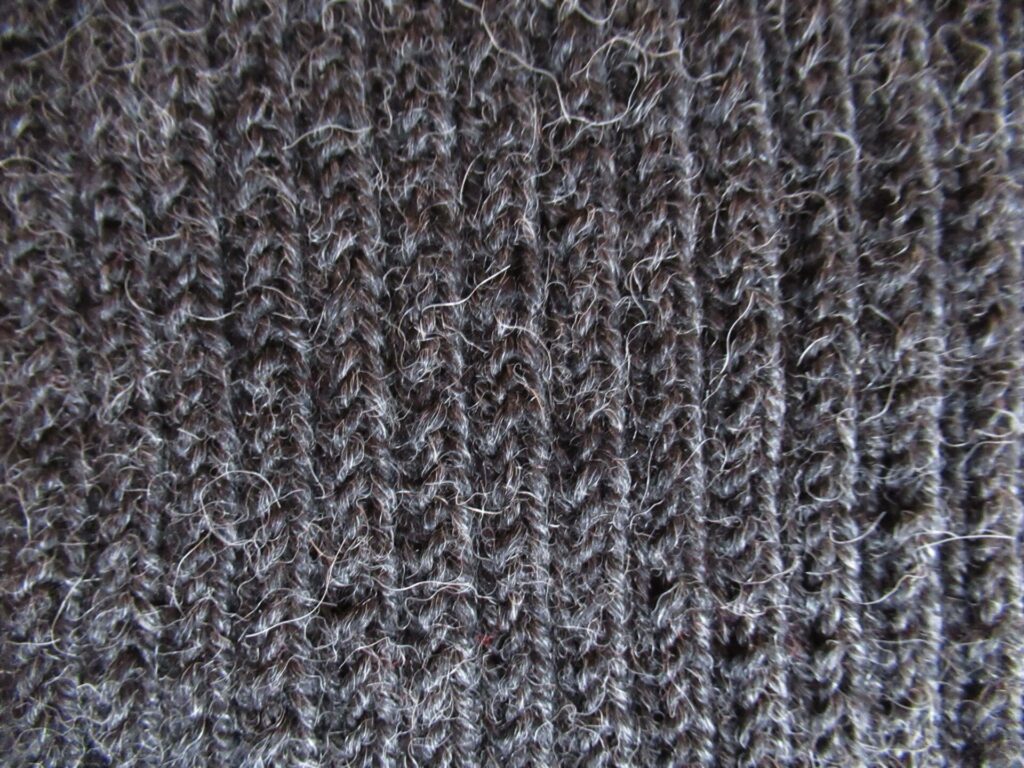
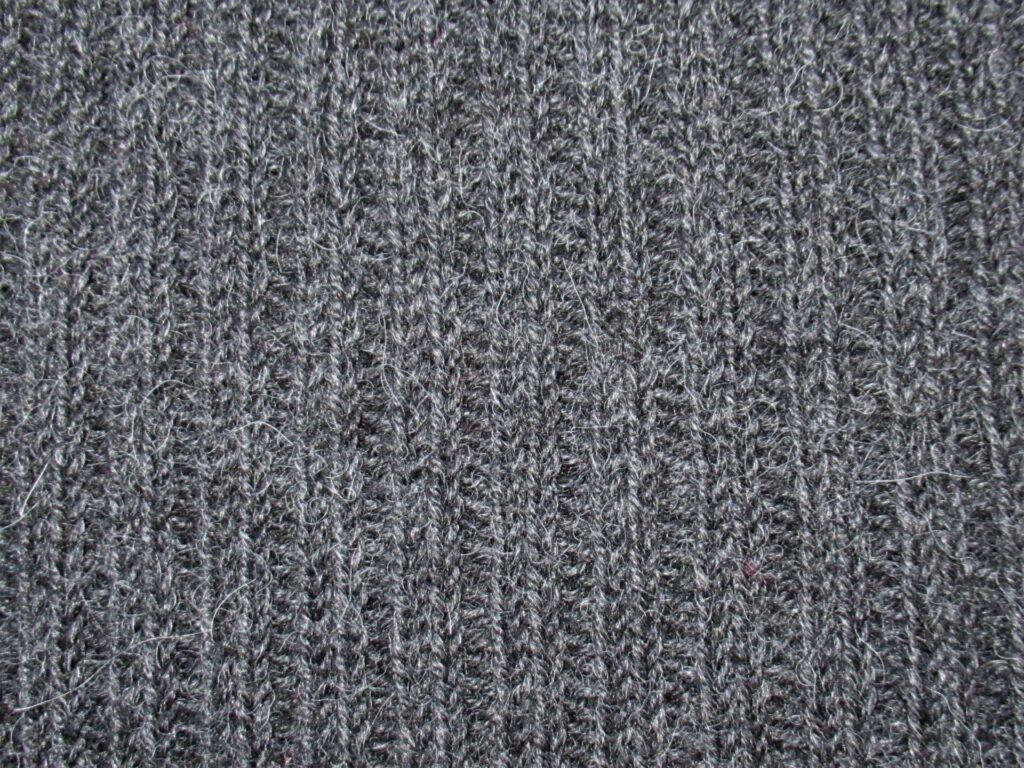
Can you see the difference? Before blocking the knitting was irregular, and the purl stitches disappeared between the knit stitches. After blocking the knitting evened out and the purl stitches became visible. And before blocking the scarf was 1.5 m x 14 cm, so stiff that it could almost stand up on its own, and slightly scratchy. After blocking it was 1.6 m x 25 cm, with a lovely drape and nice and soft.
Now all that’s left to do is gift-wrap the set, put it in a box, add a few Dutch treats and send it off to Germany, in time for my ‘little’ brother’s Birthday.
Here is a behind-the-scenes picture of the ‘Knitting Spa’ photo shoot.
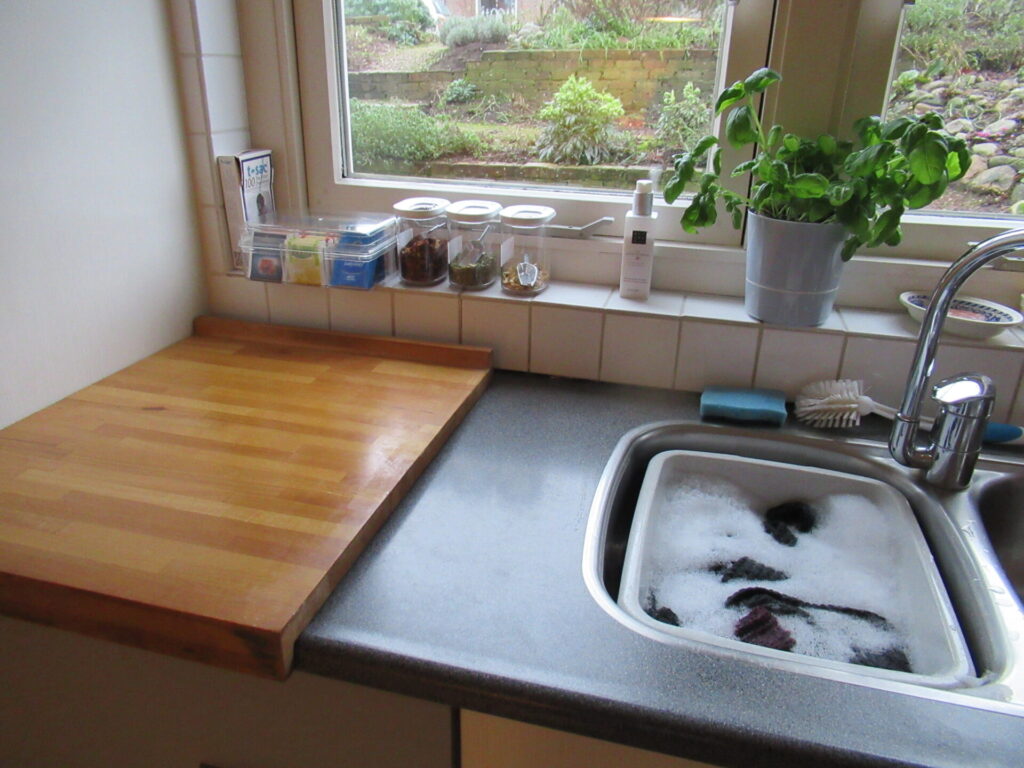
The kitchen counter was the lightest place in the house on a dark day, and the bread kneading board made a nice natural surface for photographing the tools and detergents. A perfect Knitting Spa with everything to hand: hot & cold water, a bath tub, teas & tisanes, and a nice view of the front garden.
The yarn and the pattern I used:
- Yarn: Berroco Ultra Alpaca (50% wool, 50% alpaca; 200m to 100g)
- Pattern: Pressed Rib Cap & Muffler by Churchmouse
Comfort and Joy
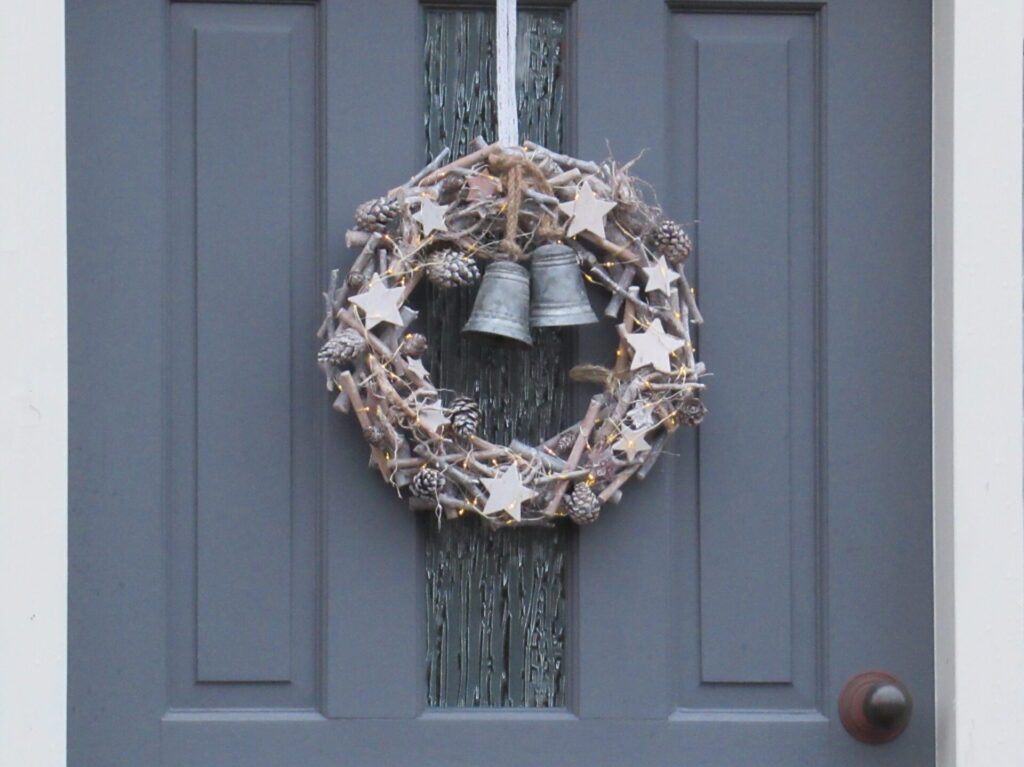
It’s Christmas Eve, and we’re nearing the end of a challenging year. Thinking about writing this post beforehand, I felt that I should say something Profound and Meaningful, but what? I wouldn’t know where to begin. I’m not some kind of oracle or Wise Woman, after all. I’m just an ordinary person muddling along like everybody else.
In the end, I’ve gone back to what this blog is basically about and decided to share a few of the things that have given me comfort and joy over the past weeks, hoping they’ll do the same for you.
The front door with the lovely garland at the top of this post isn’t ours. It belongs to a house further down the street.
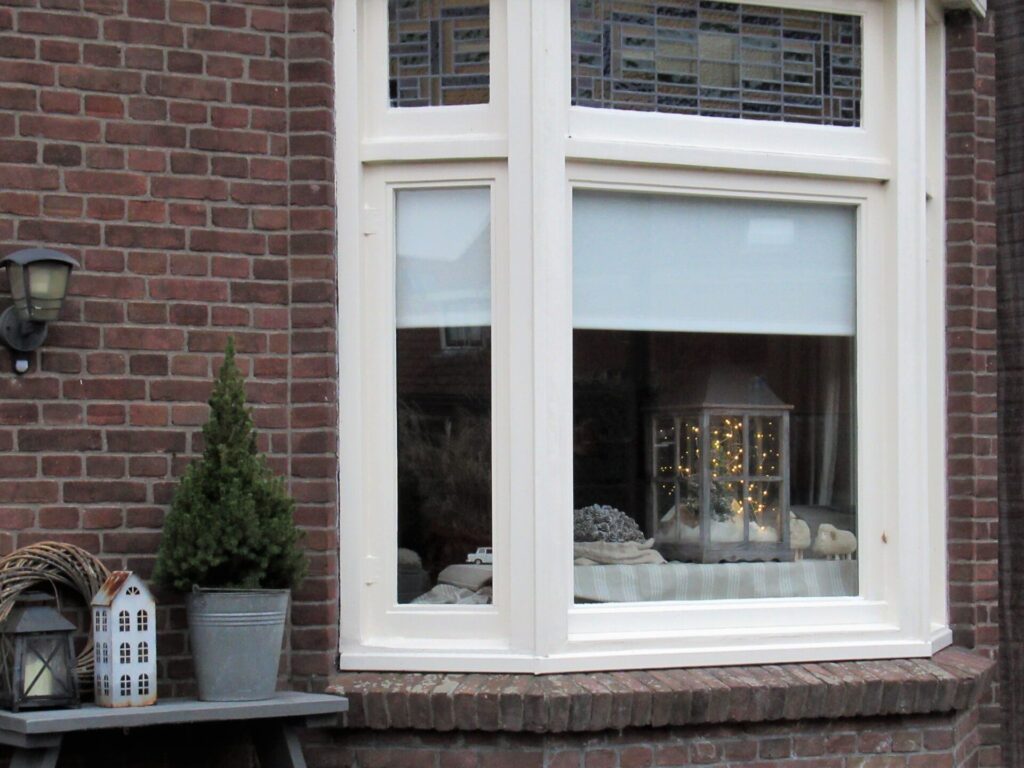
Every time I pass this house, looking at these neighbours’ stylish grey-and-white decorations brings me joy.
Our style is more traditional, mainly red, green and silver. It’s comforting to take the same old Christmas baubles from their box every year. This one symbolizes 2020 for me.
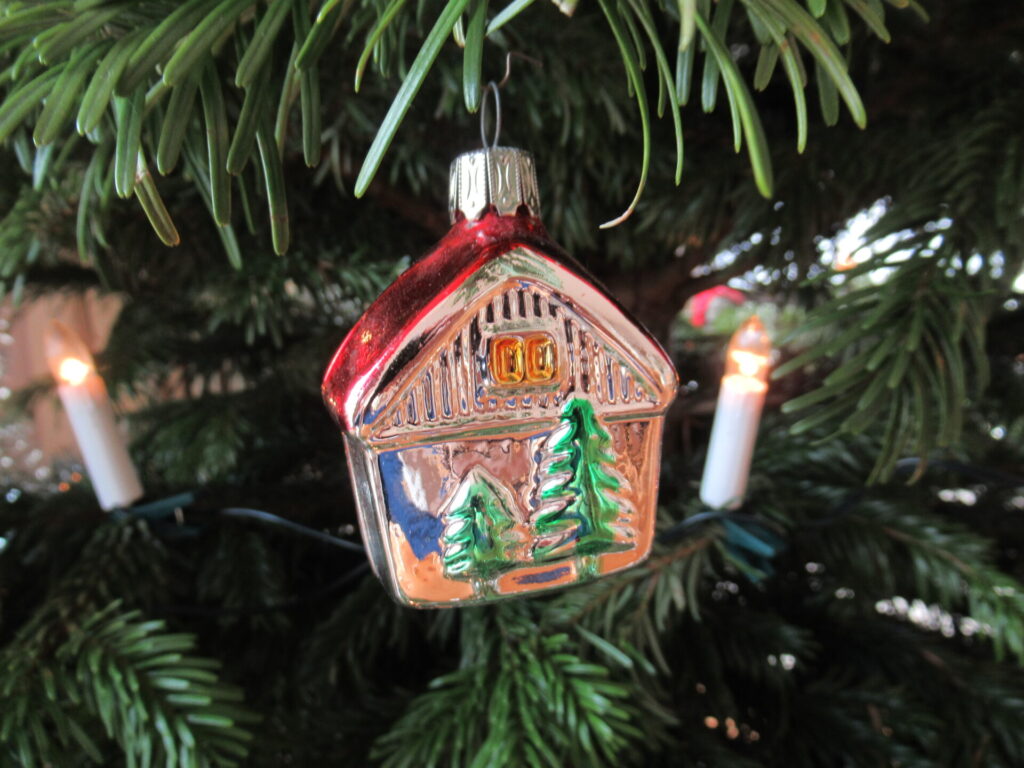
White hyacinths opening their flowers at exactly the right time scent our living room.
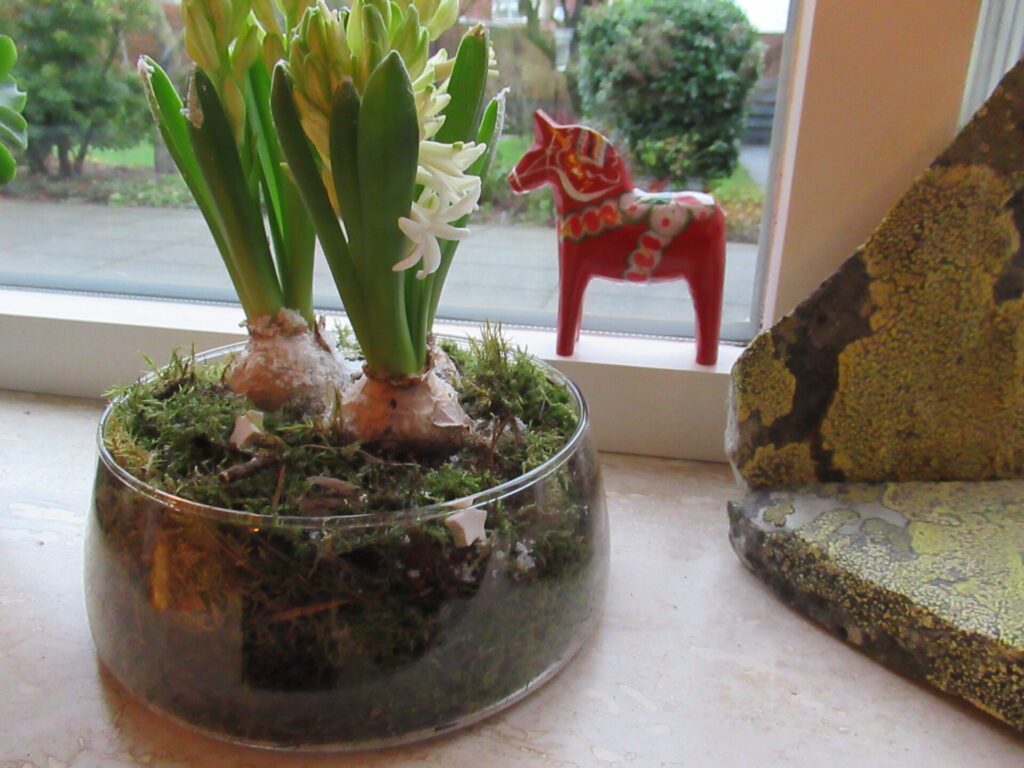
The upstairs Advent calendar has now opened its last door. And I put the star on the top of the downstairs one this morning. One of the first creatures I placed on this cardboard fir tree was a woodpecker.
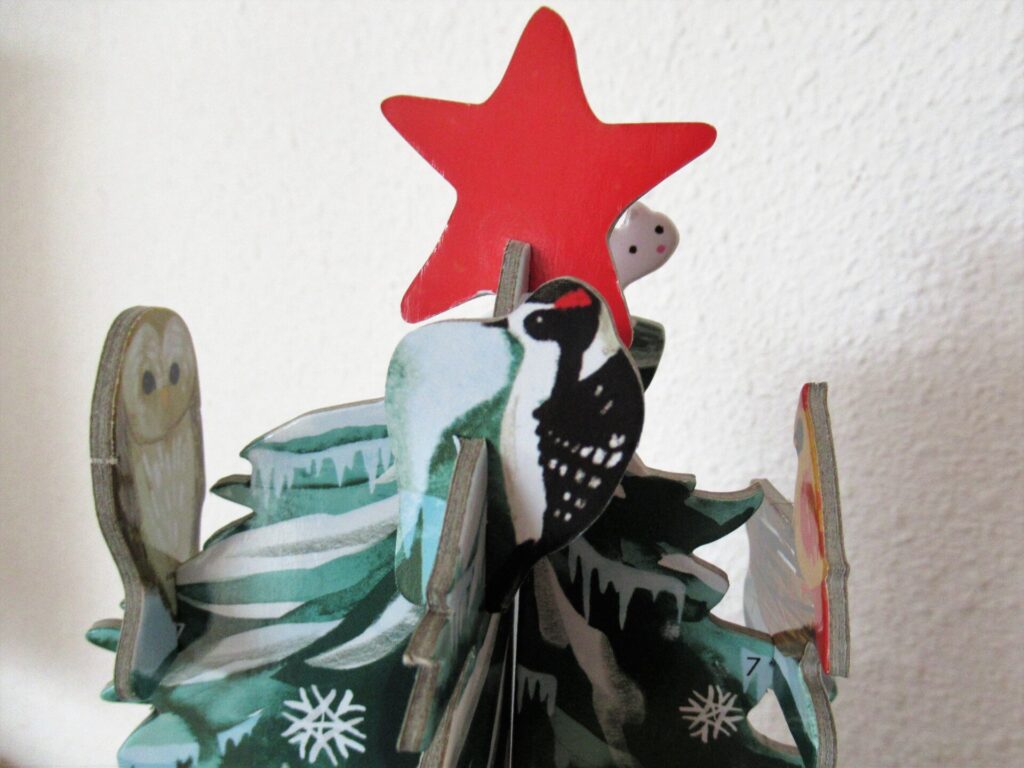
It looks just like the great spotted woodpeckers that visit our garden. They’ve been away for a while, retreating to the wood during their moulting period, but are back in full force now. Sometimes there are four of them at the same time, looking for insects on the branches of our old pear tree and fighting for a place on the peanut feeder.

Watching these beautiful birds always brings me joy. They are fairly shy, but if I’m very quiet and patient, they allow me to take a picture now and then.
Something that always brings me a lot of comfort is knitting. It is the feeling of the yarn in my hands combined with the rhythmic movement that makes it so. And what’s more, knitting things for others makes me feel connected with them during a time we are unable to meet. That’s also a comfort.
Apart from knitting several pairs of socks, a scarf and a hat to give away, I’ve treated myself to two skeins of exquisitely soft yarn for a hat and a cowl.
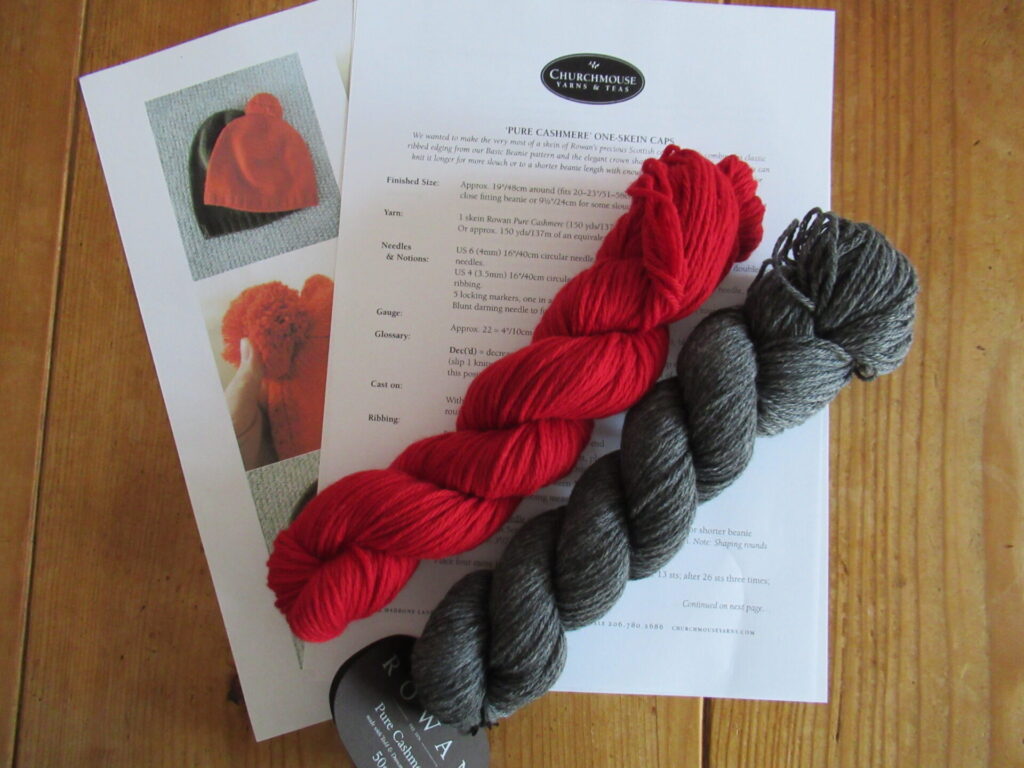
The hat pattern was a freebie from Churchmouse Yarns & Teas. They have a very active and friendly knitting group on Ravelry that I’ve enjoyed being a part of for years. The moment I saw this simple hat and read that the yarn they used for it was a sustainable cashmere, I knew that this was going to be my special December knit for me this year.
I was not just going to knit the hat, but also a matching cowl. Although I could have finished each of these projects in an evening, I decided to take it slow and enjoy every minute of the process, including winding the yarn and taking photos along the way.
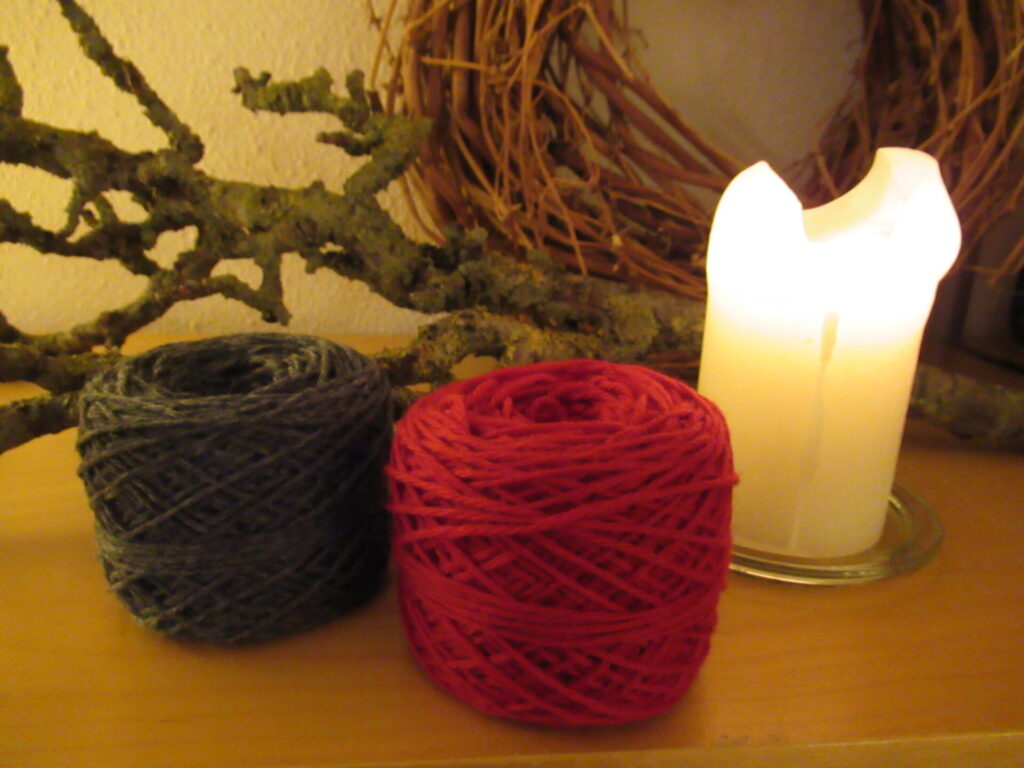
I limited myself to knitting no more than a few rows a day. During these quiet, contemplative moments, I first saw my hat grow.
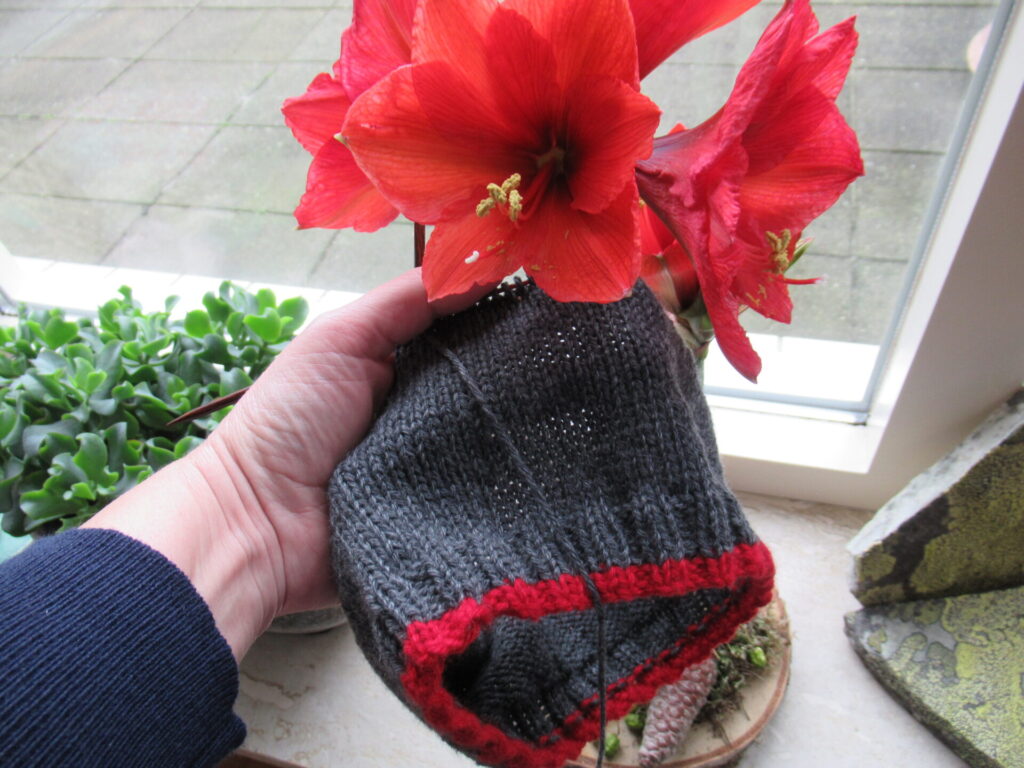
And then my cowl.

Knitting a pattern thought out by someone else is especially comforting – no stress about how many stitches to cast on, getting the right size, what decreases to use, and whether there will be enough yarn. I’ve given my own twist to it by adding a bit of contrasting colour to the rim of the hat, making a matching cowl, and finally duplicate stitching hearts onto both.
For the duplicate stitching I’ve tried out a new (to me) type of needle, with a bent tip. I’ve laid my ordinary darning needles and the new ones out on the finished cowl to show the difference.
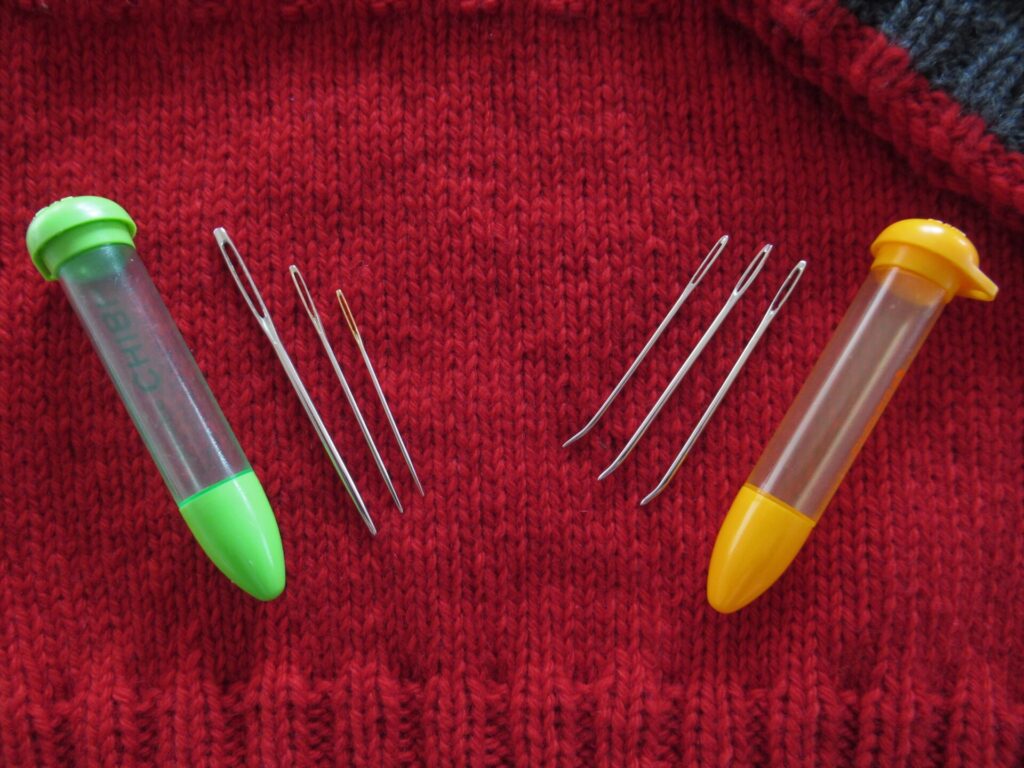
The new ones are officially called tapestry needles, and they are a real improvement for duplicate stitching, I have to say. The bent tip slides easily between the knit stitches and is really nice to work with. (I’ll keep using the regular straight ones for darning in yarn ends, though.)
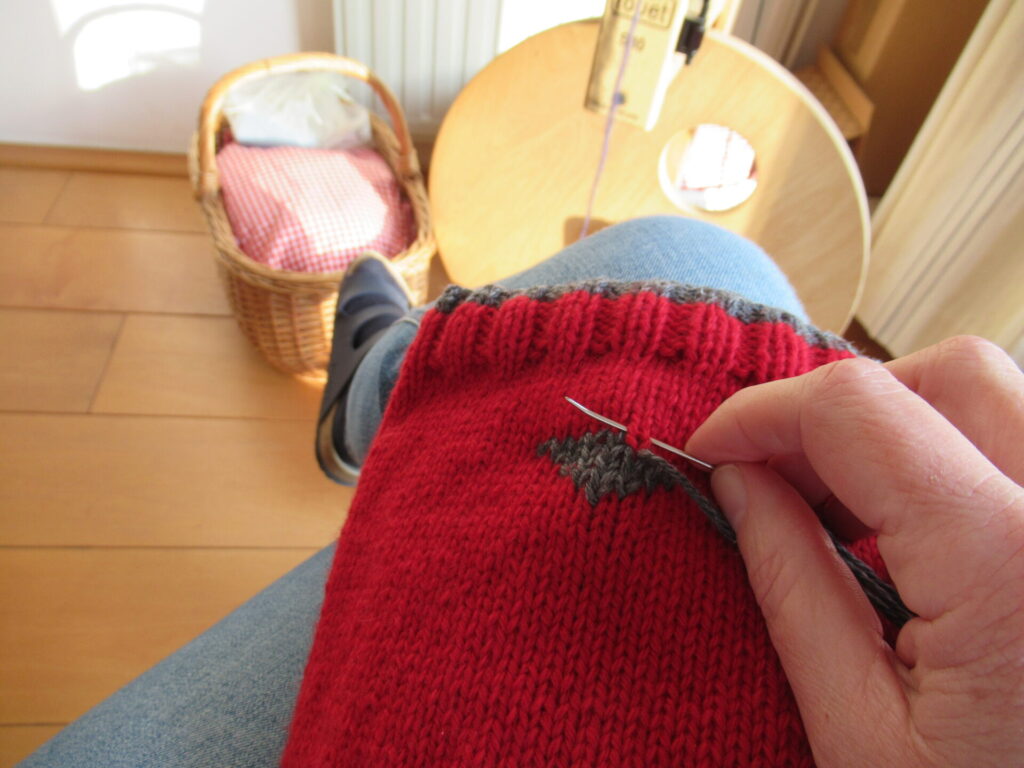
And here are my hat and cowl all finished.
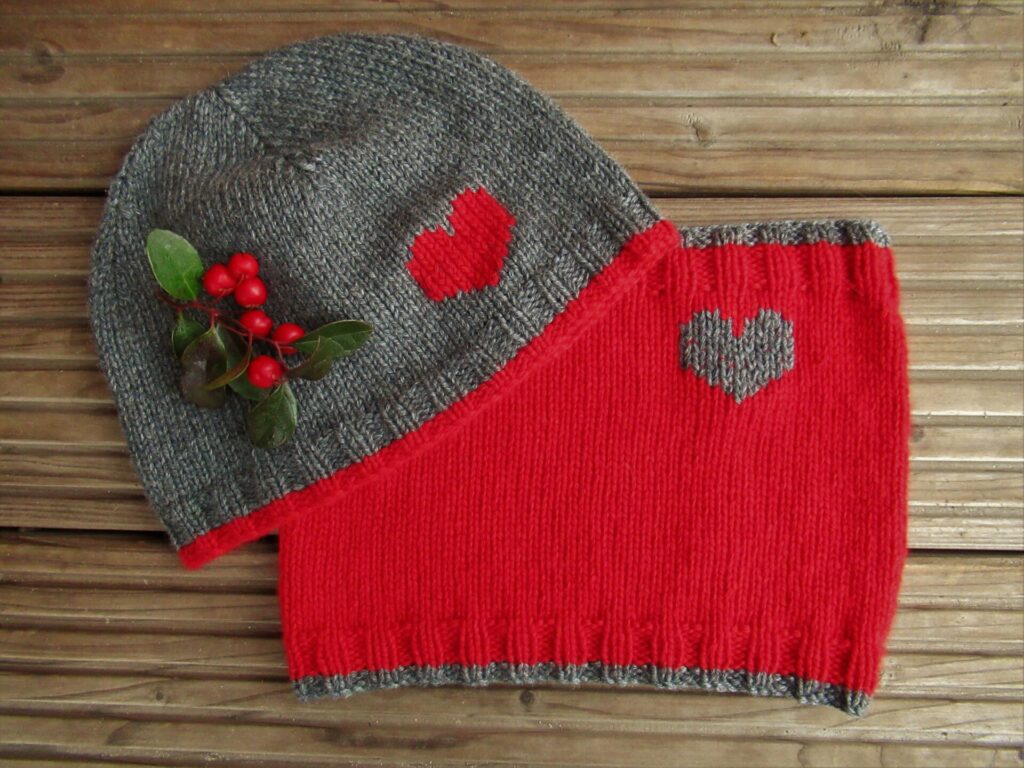
They were a joy to knit, and I know they’ll be a joy to wear for a long time to come.
Now there is just one last thing I’d like to share with you – a gift we received on Tuesday. This year the organic farm that delivers groceries to our door, gave all their customers a bag of organic daffodil bulbs. It came with a message on a bit of sunny yellow paper. Translated it said:
When all of a sudden ordinary things
Can no longer be taken for granted
We realize how extraordinary
Ordinary things really are

Such a lovely gift – a ray of sunshine and hope during these dark days.
Thank you so much for reading my blog over the past year, and leaving a comment now and then. These small virtual moments of contact mean a lot to me. I’m taking a break now and hope to be back here somewhere in the course of January. I’m looking forward to ‘seeing’ you again then.
I wish you a safe and peaceful Christmas and the very best for 2021!
Thús 2
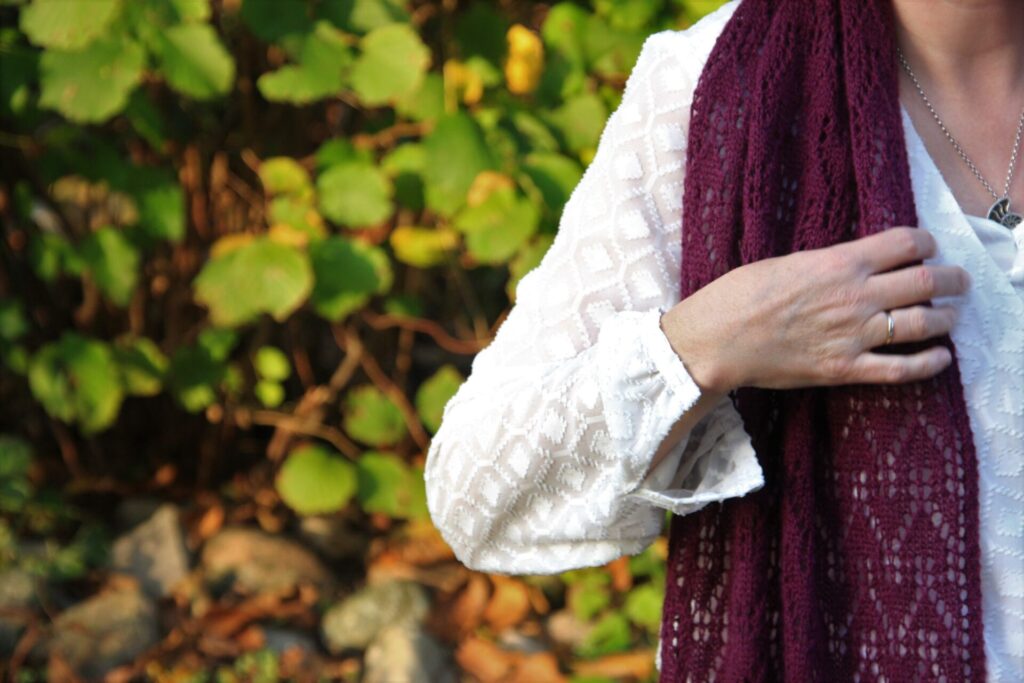
Hello!
How are things going in your part of the world? I really hope that you are safe and well, and have enough to do to keep your hands occupied and your mind free from too many worries.
Here, in the Netherlands, we are still spending an inordinate amount of time at home, or thús, as the Frisians say. And what better thing to do at home than knit? It’s utterly comforting and relaxing. Plus you end up with something nice for yourself or someone else.
So, high time for a new version of Thús, a pattern I published earlier this year. Here it is – Thús 2!
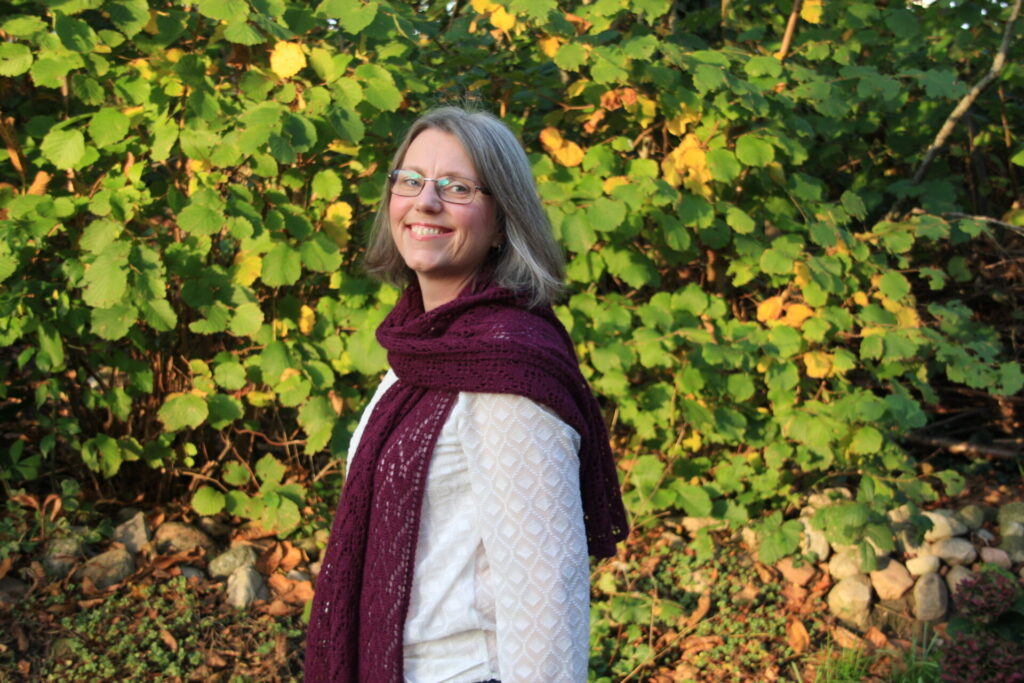
The original version of Thús was a one-skein project, with an all-over stitch pattern of rows of interconnected houses.
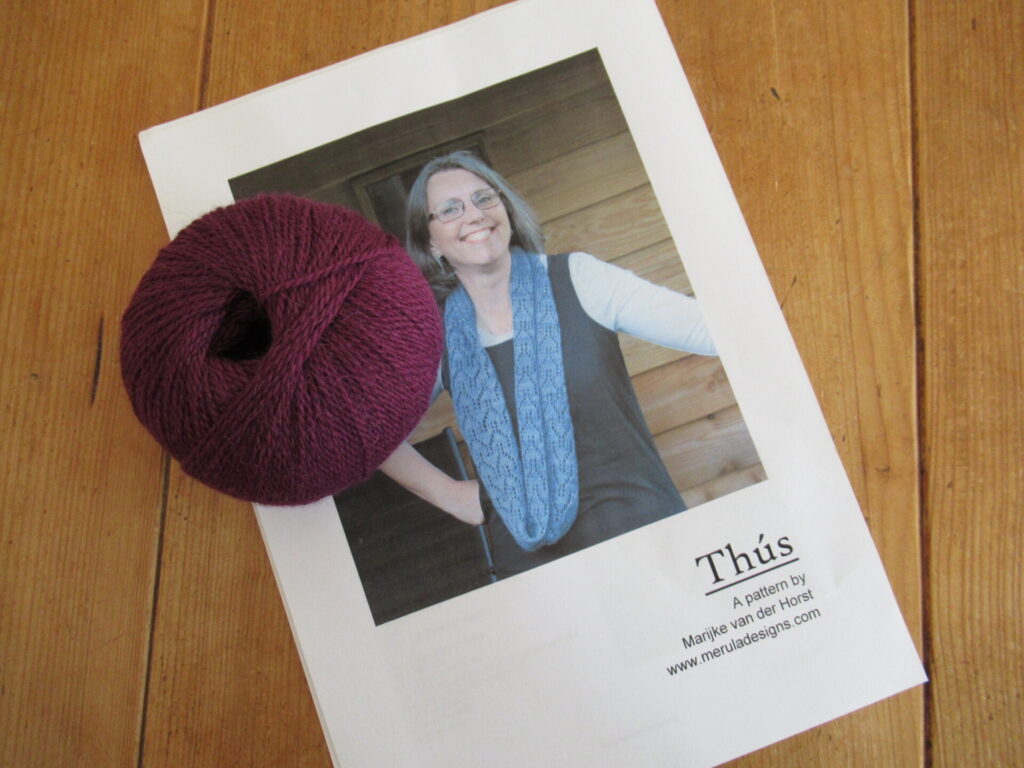
Thús 2 is covered in the same tiny houses, but is wider and longer. And it is a scarf instead of a loop – a bigger symbolic hug for yourself, a friend or a relative.
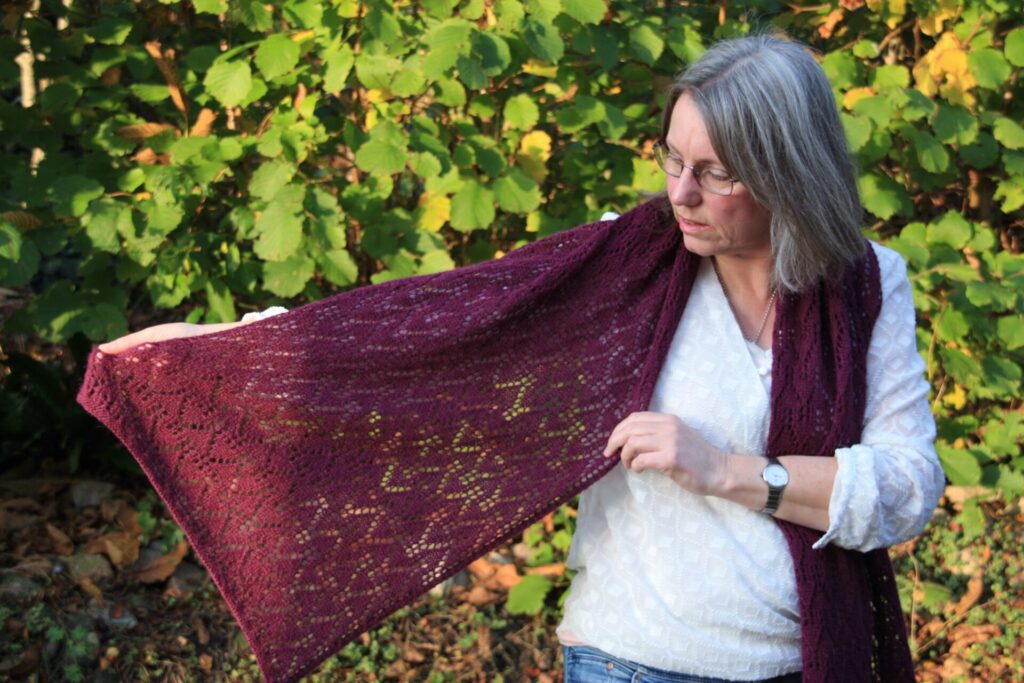
I hate having my pictures taken, but my beloved photographer was patient, I called upon my inner Doutzen Kroes (who also grew up in Friesland, by the way), and we actually ended up with a few in which my eyes aren’t closed.
Thús 2 is long enough to be worn wrapped around the neck.
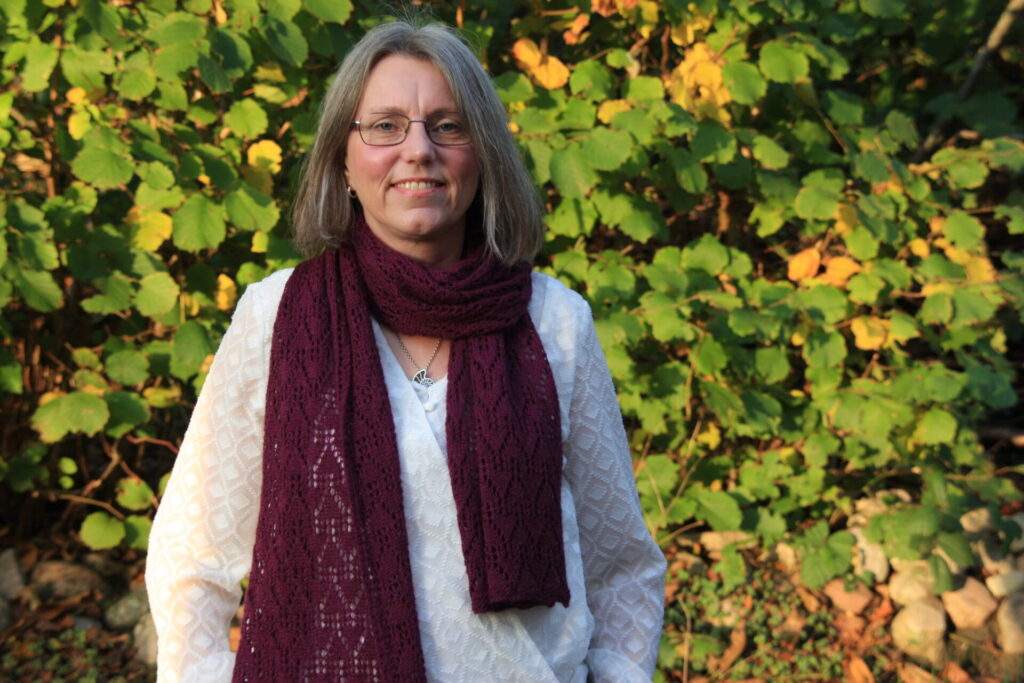
Or folded in half with the ends pulled through the loop.
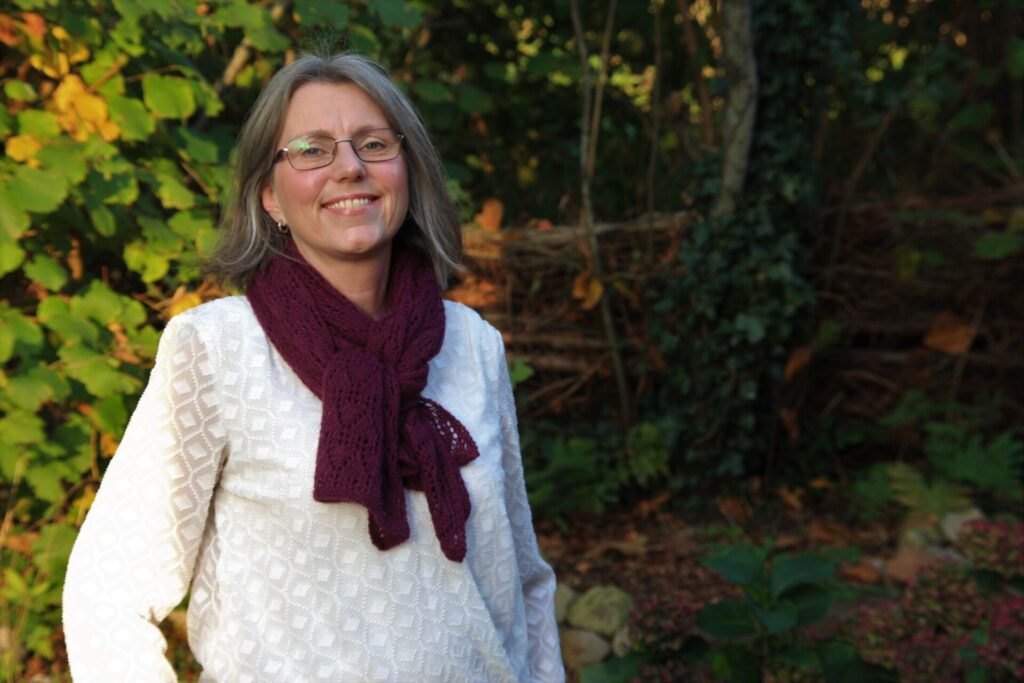
Thús 2 may look like a lot of knitting, but it isn’t really. It takes four 50-gram balls of fingering-weight yarn. That is the same quantity as two pairs of socks. I won’t say it is done in a jiffy, but on 3.5 mm (US 4) needles it is a fairly quick knit. And an enjoyable one, too, I think/hope.
The yarn I used is Pascuali ‘Balayage’, a blend of 20% organic merino wool and 80% baby alpaca. The wool is certified organic. The alpaca isn’t certified, but is produced sustainably. Both fibres are produced in Peru, where the yarn is also spun and dyed.
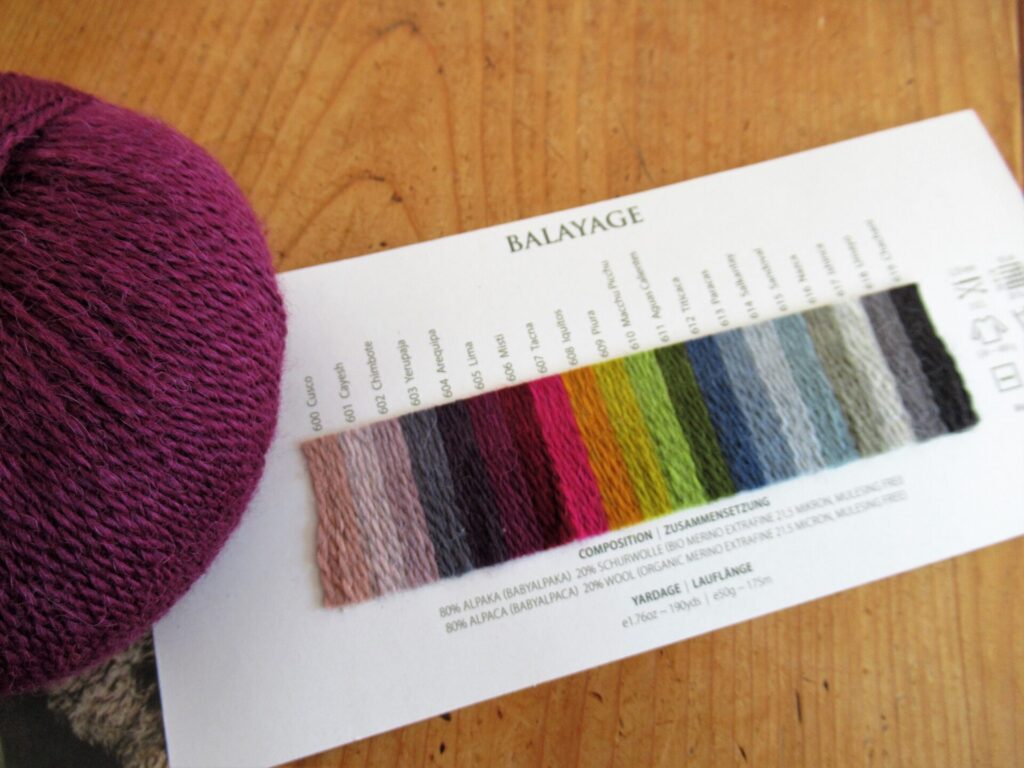
This was a delicious yarn to knit with! (I’m not sponsored to say this – it is my own honest opinion.) It is very, very soft and smooth. To my mind, the yarn has the best of both worlds. It has the drape and smoothness of alpaca, but thanks to the wool content it isn’t as ‘limp’ as 100% alpaca can be. I think it is ideal for lace and will also show up other stitch patterns very well. I don’t agree with the yarn producer that it is suitable for Fair Isle knitting, though. Imho it is too slippery and not stretchy enough for that.
Something that doesn’t show in my dark plummy shade, is that part of the alpaca is grey, which gives the lighter shades a lovely heathered look.
Although I have a shade card (I love shade cards!) it works best for me to choose colours in real life, in the skein or ball. From the rainbow of gorgeous colours at the not-so-tiny-anymore yarn shop I recently wrote about, I chose a shade called ‘Lima’ after the capital of Peru.
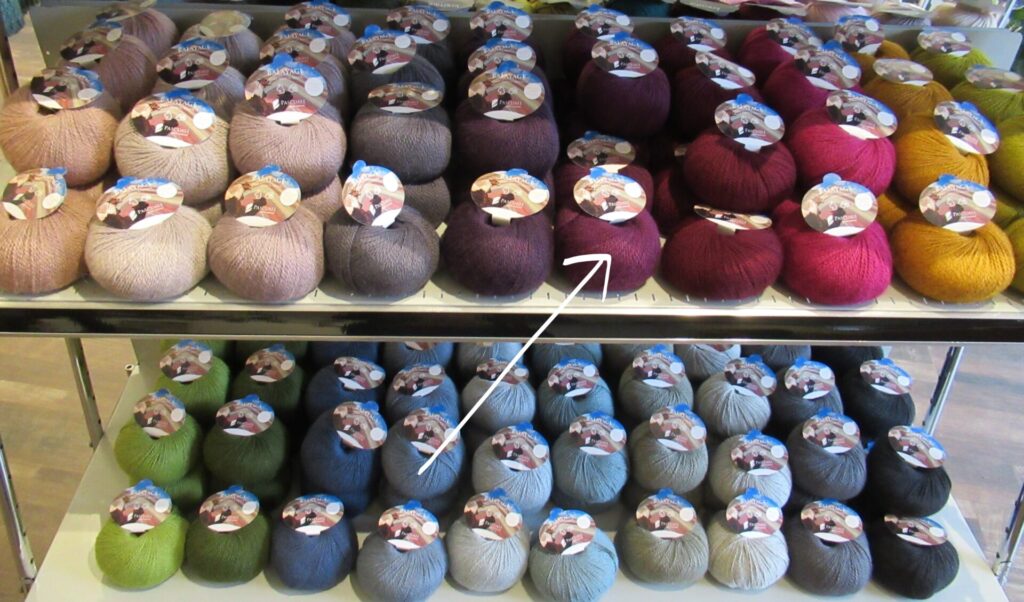
What always helps me choose, is seeing colours in relation to each other. Take the gradient of pinks and purples below. Lima is on the darker end of the spectrum. Compared to the burgundy to the right of it and the eggplant to the left, it isn’t really purple or red, but something in between.

I made this Thús 2 for a friend, in lieu of a real hug. She has a cardi in the same kind of red-purple that looks very good on her, and I am fairly confident that she’ll like it.
(That I wrote about the yarn I used in so much detail, is just because I’m a little obsessed with yarn. Please don’t feel that you have to use the exact same yarn if you’d like to make a scarf like mine – 200 grams of another, similar fingering-weight yarn will be fine, too.)
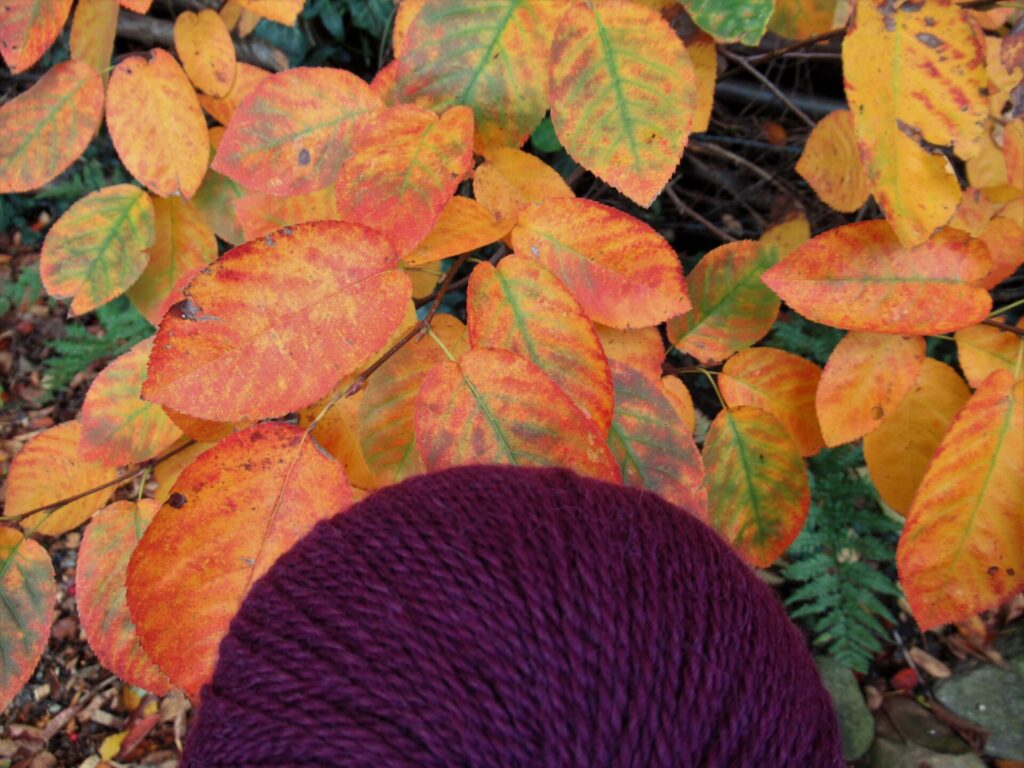
Here is a tip for starting a new ball and weaving in the ends invisibly. (This also applies to the original version, and any other shawl or scarf with garter stitch edgings.) In my experience the best place to do this is on the inside of the narrow bands of garter stitch along the long sides. This is what I mean on the wrong side:
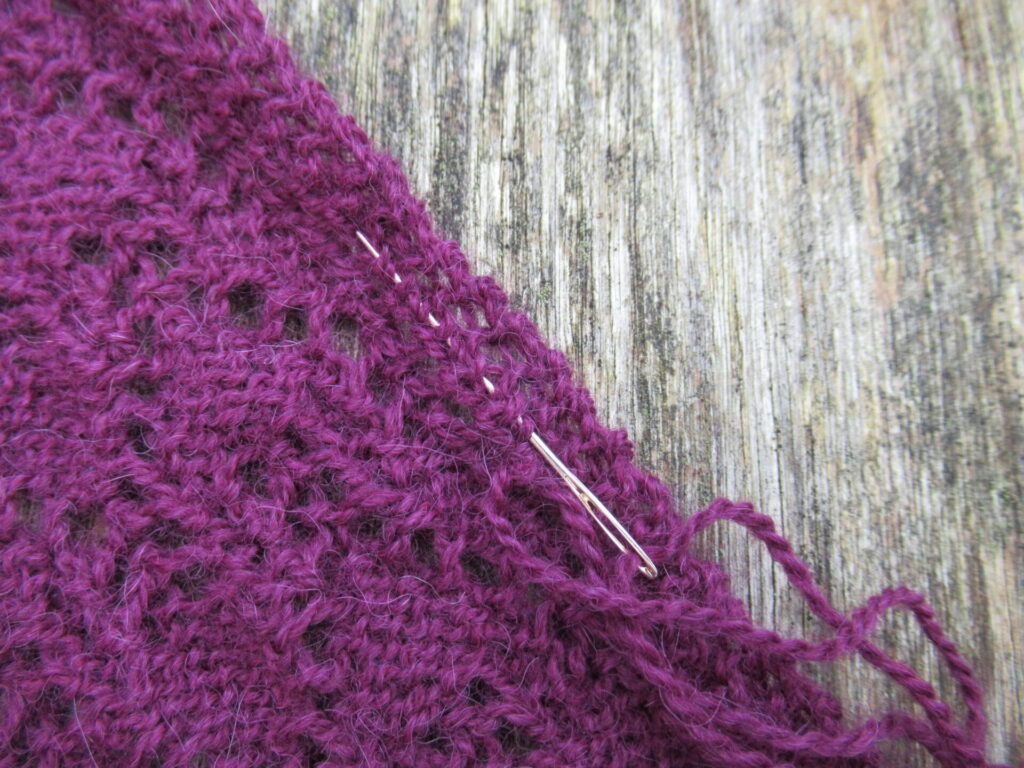
And if that picture isn’t clear enough, this is the place indicated on the right side (the actual weaving-in is done on the wrong side).
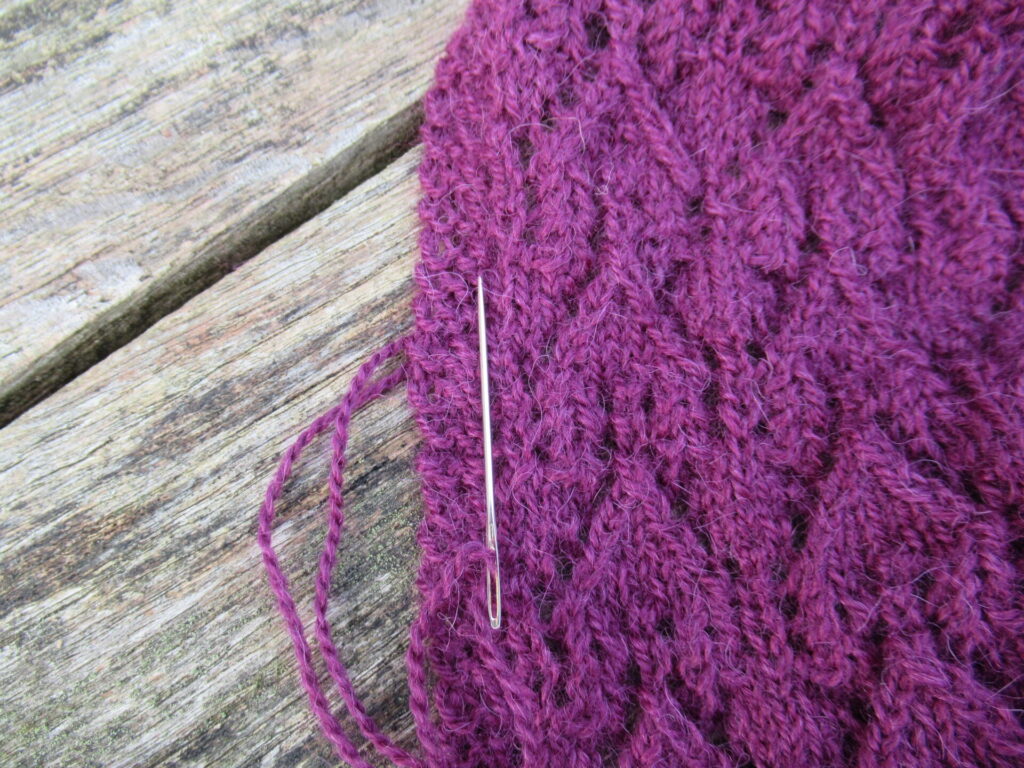
Well, I think that is all I can tell you about it for now. After the original Thús, I hope you like Thús 2, too.
Oh, and like the original version, Thús 2 is a free pattern – a small positive gesture in this challenging time. If you’d like to take some positive action in return, please consider making a donation to an organisation supporting refugees, other homeless people, or children/adults in unsafe home situations.
Thús 2 can be downloaded here from Ravelry
(available in English AND Dutch, also to non-Ravelry members)
Thank you and happy knitting!
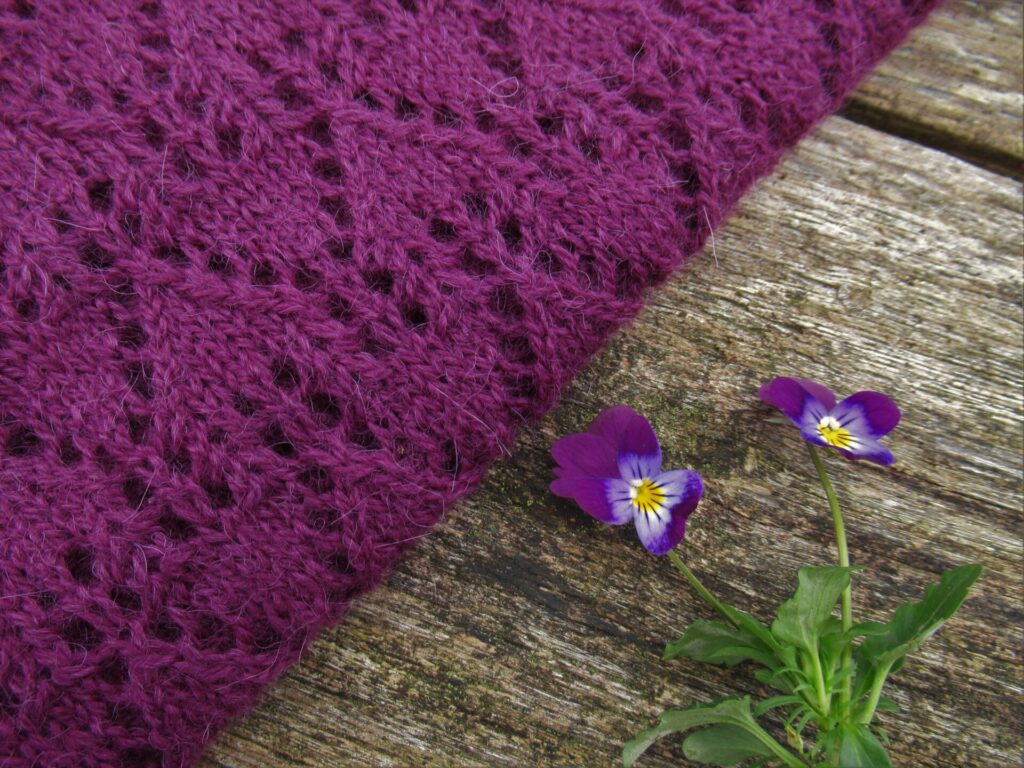
Van Dyke Lace
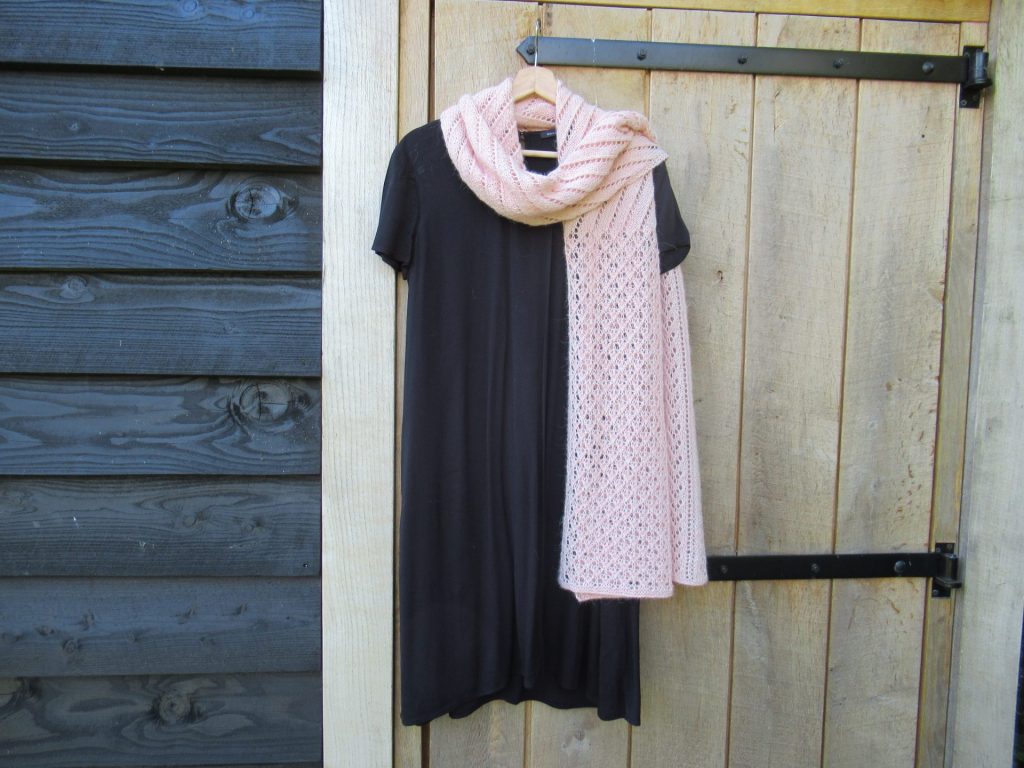
There is often more to knitting than meets the eye. Take this scarf that I’ve just finished. To an outsider, it may look like just another knitted lacy scarf, but to me it’s much more than that. To me it represents memories of Norway and a group of virtual knitting friends, with some literature and fine art thrown in as well.
Let’s take a look at the basics first – the pattern and the yarn. The pattern is called Lace Sampler Scarf and is a Churchmouse Classic.
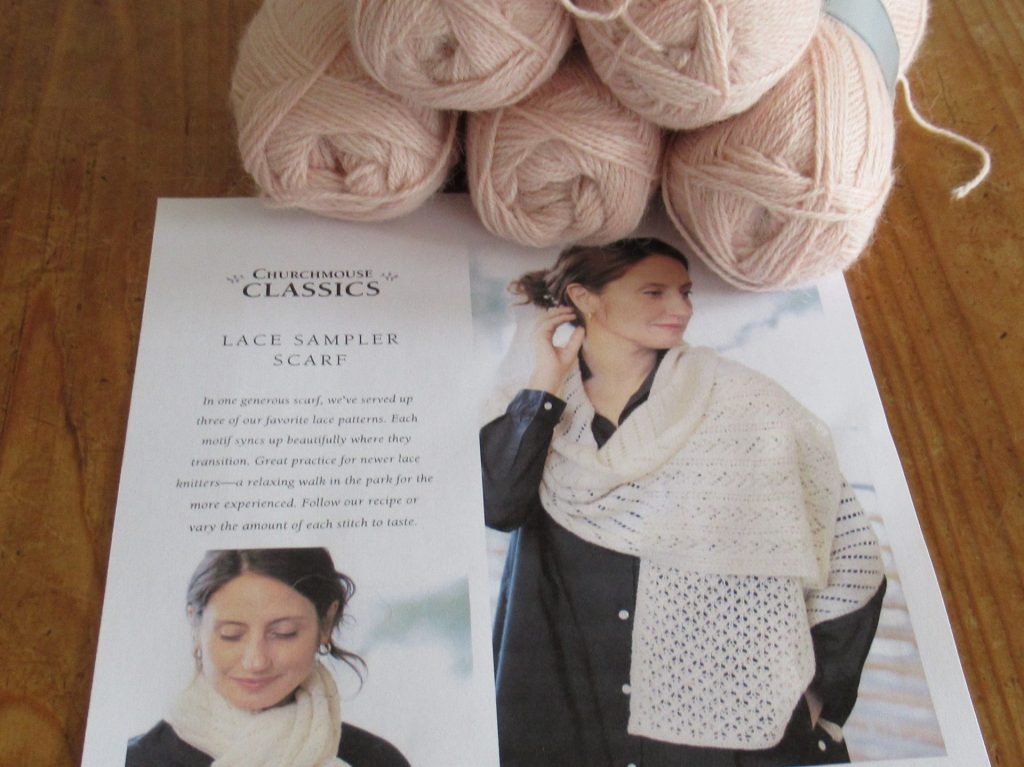
Over the years I’ve knit many items designed by the Churchmouse design team. Their patterns have beautiful photographs, are written with much attention to detail and always contain some tips and techniques. They also have a very friendly and helpful Ravelry board and, although I will in all likelihood never meet any of the people I chat with there in real life, their virtual friendship means a lot to me.
The yarn is 100% alpaca in a sport weight that I once brought home as a souvenir from Norway, where we have spent many wonderful summer holidays. I remember buying the yarn at a Husfliden shop in Mosjøen, a lovely small town about a hundred kilometres south of the Polar Circle.
I wasn’t into photographing yarn shops then (I didn’t even have a camera at the time), but I do have a few pictures taken by my husband to give you an impression of the town. Here is one of those attractive Norwegian wooden houses.
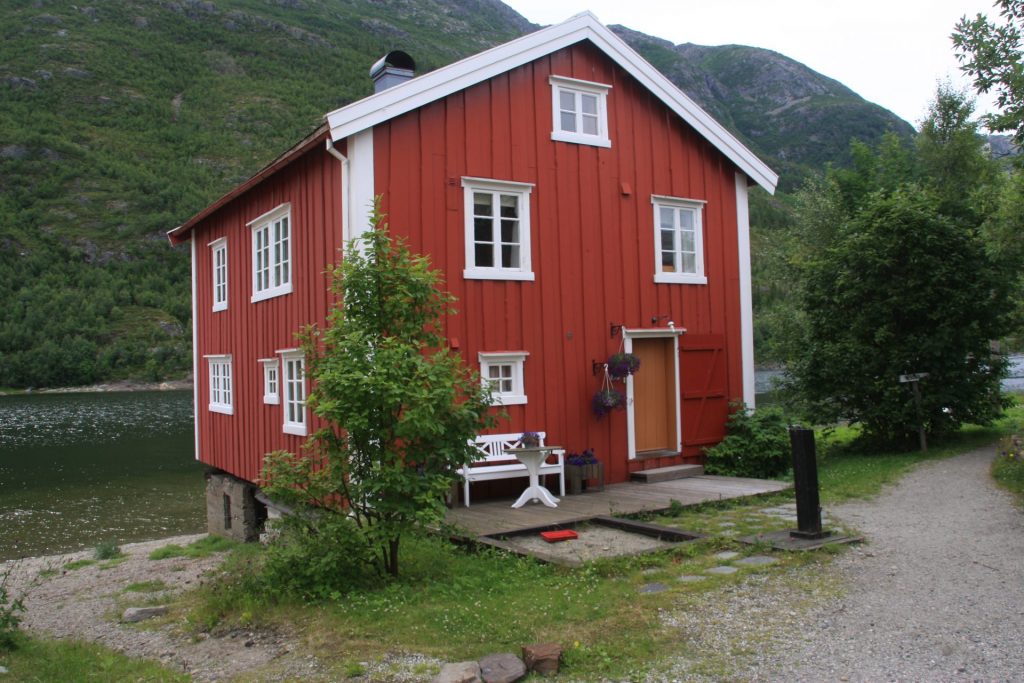
And this is a picture of one of the oldest streets of the town – Sjøgata (Sea Road).
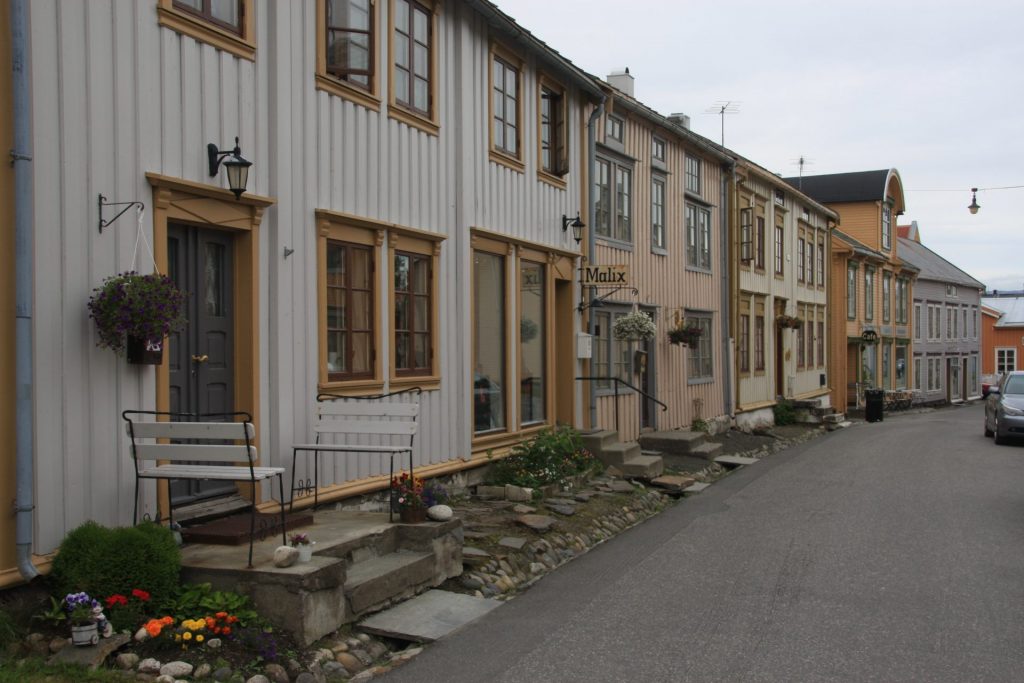
The Lace Sampler Scarf uses three different lace patterns. It is a sampler, after all – originally meant as a practice piece. It starts with some Van Dyke Lace, followed by a section in Diagonal Lace and ending with some English Mesh Lace (photo below from bottom to top).
The designers playfully made the sections all in different lengths. That was the only thing about the pattern that I didn’t like. In fact, it really irked me. My mind is apparently more rigid symmetrically oriented than theirs. So I adapted the pattern to make the first and the last sections the same length, and the middle section twice as long.
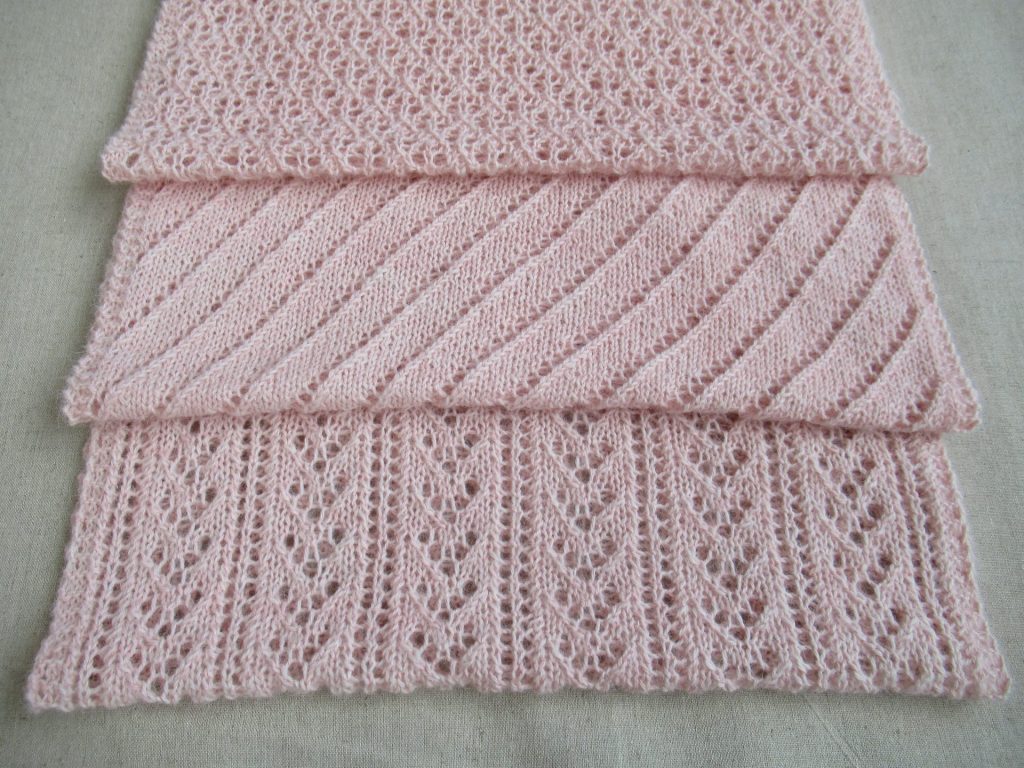
While I was knitting, I didn’t really think about the lace patterns very much. Diagonal lace speaks for itself with its rows of diagonal eyelets. English mesh looks a lot like, well, mesh. And Van Dijk is a common enough name in this country. I knit on more or less thoughtlessly, enjoying the soft yarn in my hands and the different rhythms of the patterns.
But when I had just started on the last section, the book I was rereading also mentioned Van Dyke Lace and my attention was caught. It was Jane and the Ghosts of Netley by Stephanie Barron. (This is the seventh novel in a series of mysteries in which author Jane Austen features as an amateur detective. The novels capture the style and times of the real Jane Austen perfectly and are great fun.)
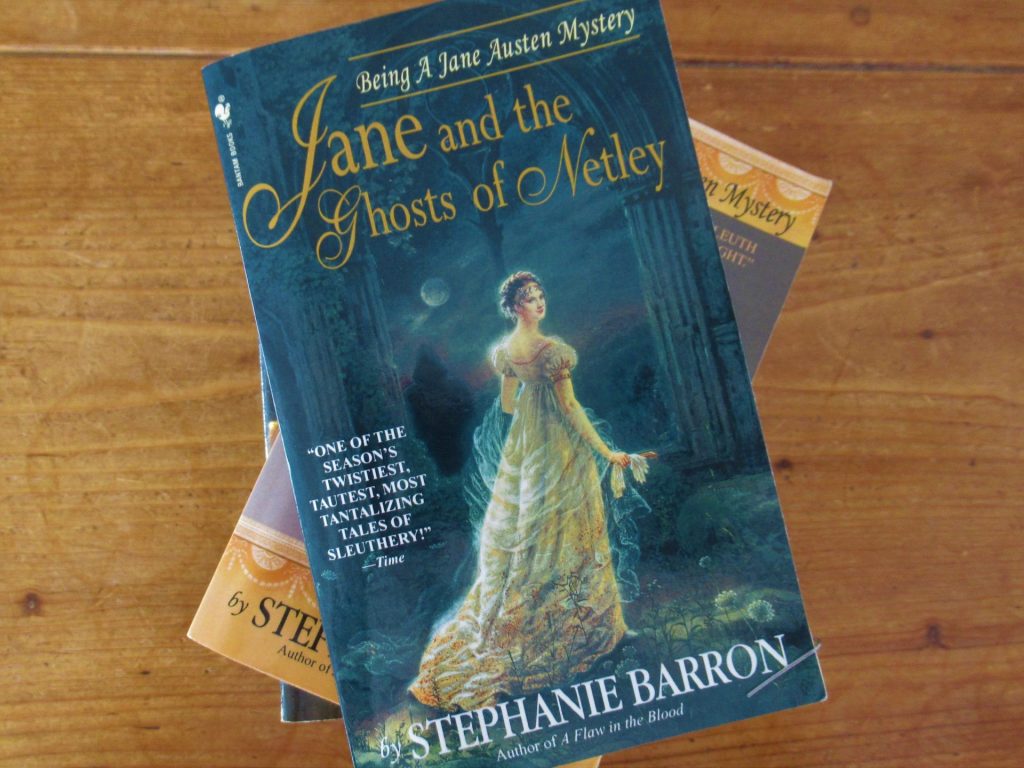
On p. 129 Jane is trying on a dress at modiste Madame Clarisse’s when an acquaintance asks, ‘I wonder if Madame Clarisse is familiar with the demi-ruff à la Queen Elizabeth, pleated in Vandyke?’ And a little later, ‘Forgive me for speaking as I find, Miss Austen, but you’ve rather a short neck – and the white demi-ruff, Vandyke-stile, should lengthen its appearance to admiration.’
Wait a second! Van Dyke Lace, pleated in Vandyke, a demi-ruff Vandyke-stile… where does this all come from? Oh, of course, it refers to Anthony van Dyke, the 17th Century artist who painted lace ruffs and collars so exquisitely! There are some great examples at the Mauritshuis in The Hague and the Rijksmuseum in Amsterdam. (These are either bobbin lace or needle lace – I don’t know enough about lace to tell.)
Then I started looking for examples of Van Dyke Lace in knitting and found out that there isn’t just one kind of knitted Van Dyke Lace, but many. This is my/Churchmouse’s Van Dyke Lace:
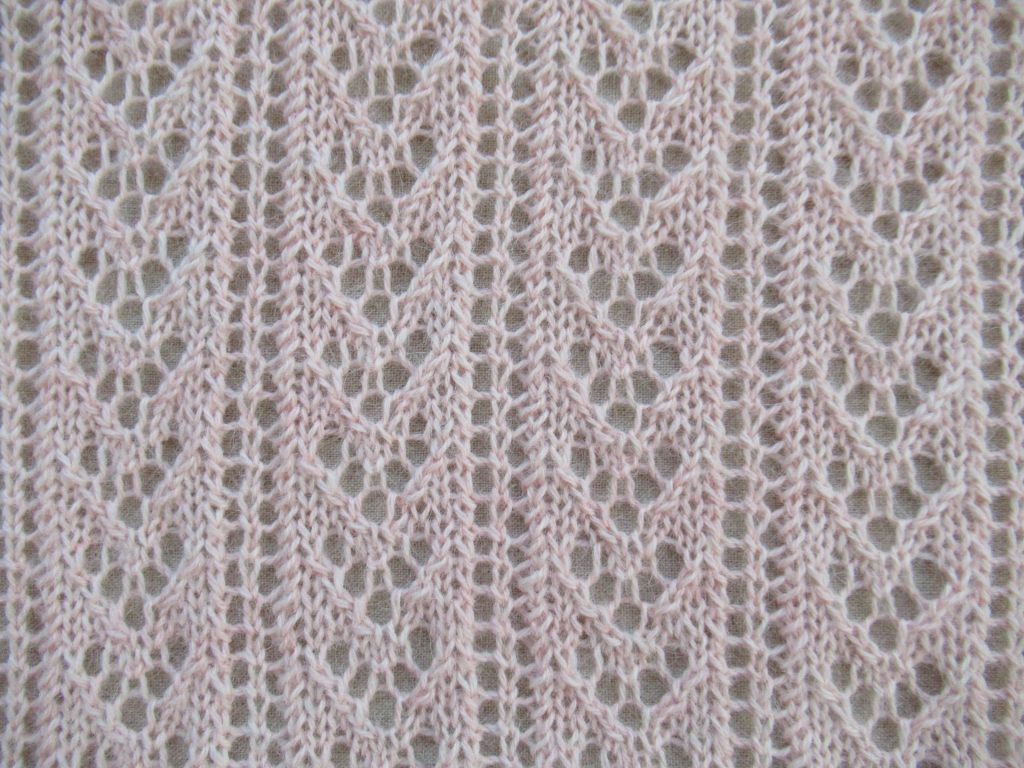
The Vandyke lace in Barbara Walker’s Third Treasury of Knitting Patterns looks very different:
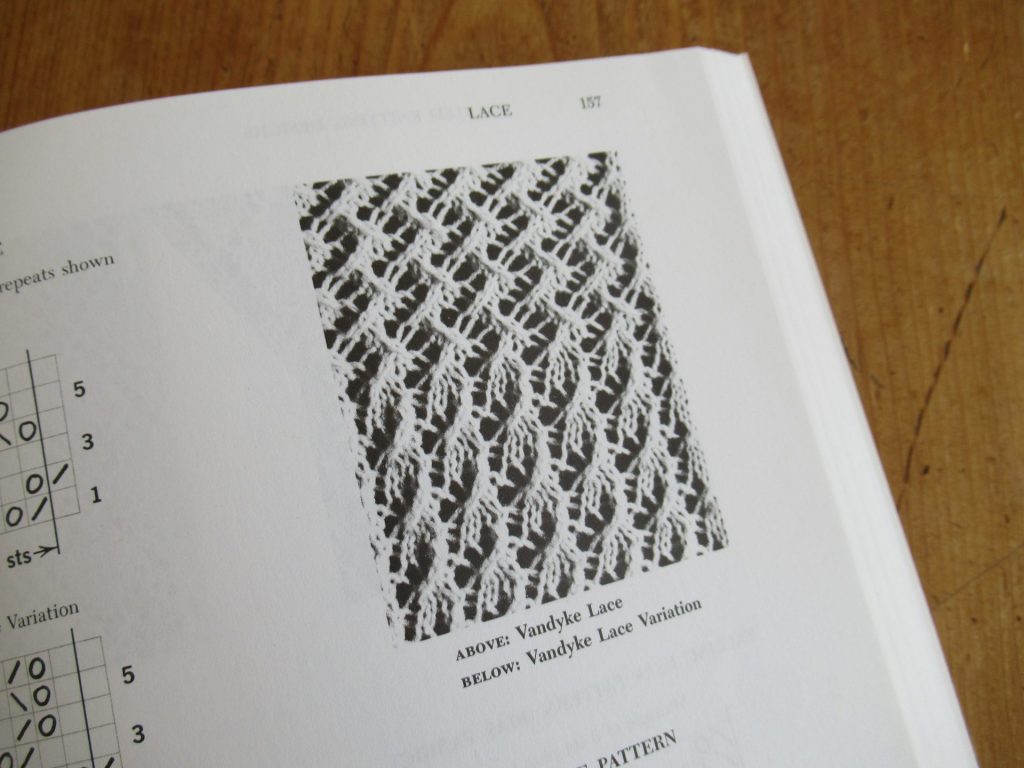
In Treasuries I and II, Walker also mentions a Vandyke check pattern, Vandyke faggot, Vandyke leaf pattern, Vandyke medallion edging and Vandyke swag stitch.
In Heirloom Knitting, about Shetland lace knitting, Sharon Miller describes a Vandyke Edging – pointy with zigzags.
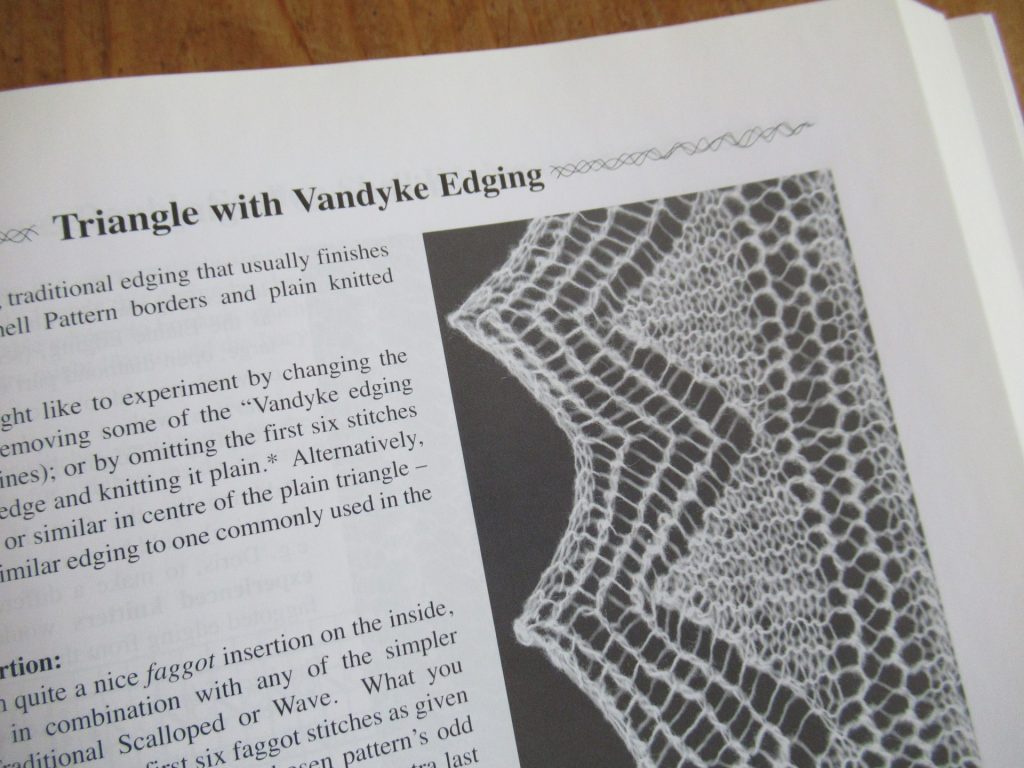
The common denominator seems to be that all Van Dyke lace is pointy or zigzaggy in some way. There are probably many more variations on this theme elsewhere. I just love it that there is always more to discover about knitting.
Well, here is another picture of ‘my’ Van Dyke Lace (the section with the V’s). This isn’t fine lace as in Van Dyke’s portraits and Shetland knitting. Compared to the gossamer yarns used in Shetland lace (which can be up to 6.000 metres per 100 grams), the yarn I used (which was 334 metres per 100 grams) is like ship’s rope compared to dental floss. But to me the result looks more than fine.
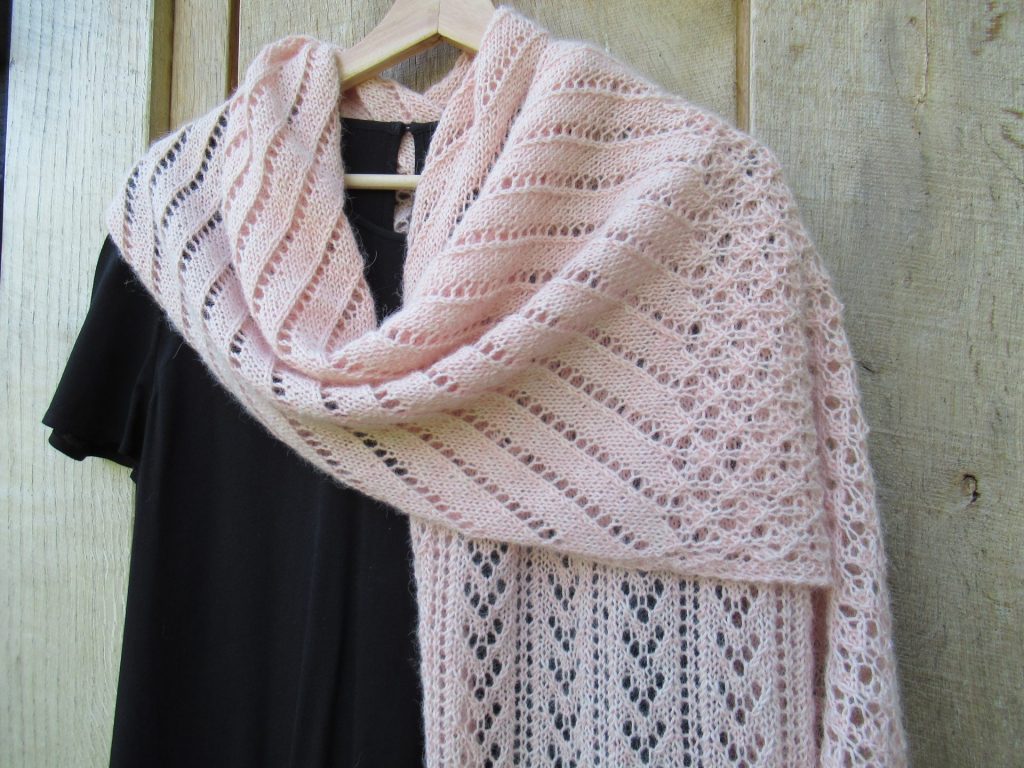
I give many of the things I knit away, but I don’t know anybody who would like to have a shawl in this shade of pink, so there is nothing for it but to keep this one. And you know what? I don’t mind in the least, because every time I wear it, it will remind me of Norway, of my virtual knitting friends and of the things I discovered in the process.
Thús
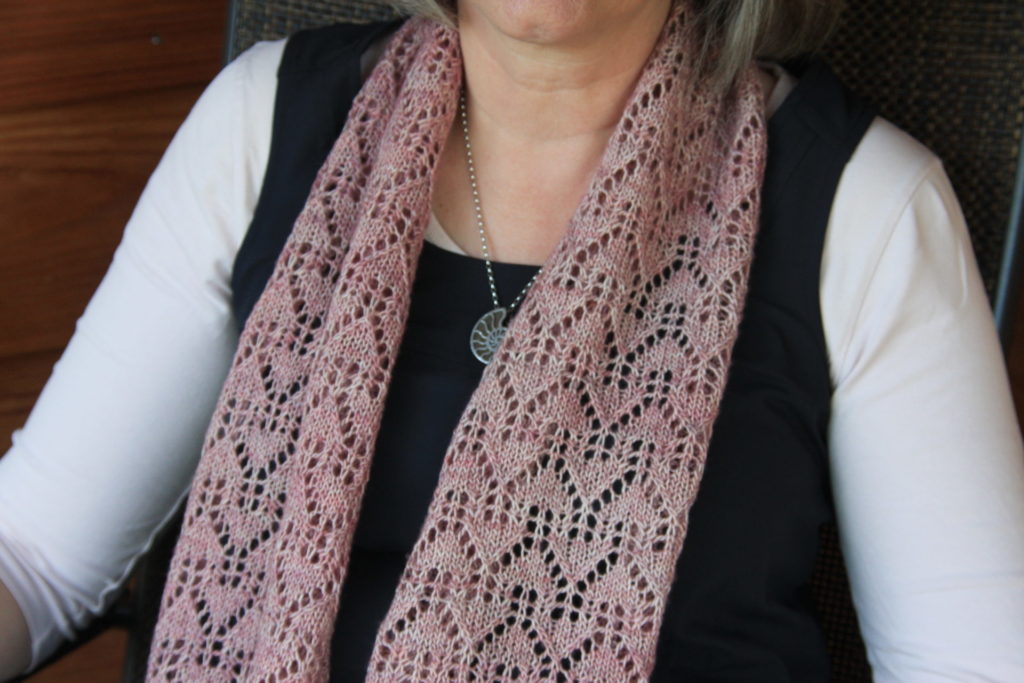
Hello!
Well, here is the new (free) pattern that I promised you last time. It’s a loop/cowl called Thús, which is the Frisian word for Home.
As a child growing up in Friesland, I had no idea what I wanted to be when I grew up. What I did know, was that I wanted a peaceful, cosy home.
My wish was granted.
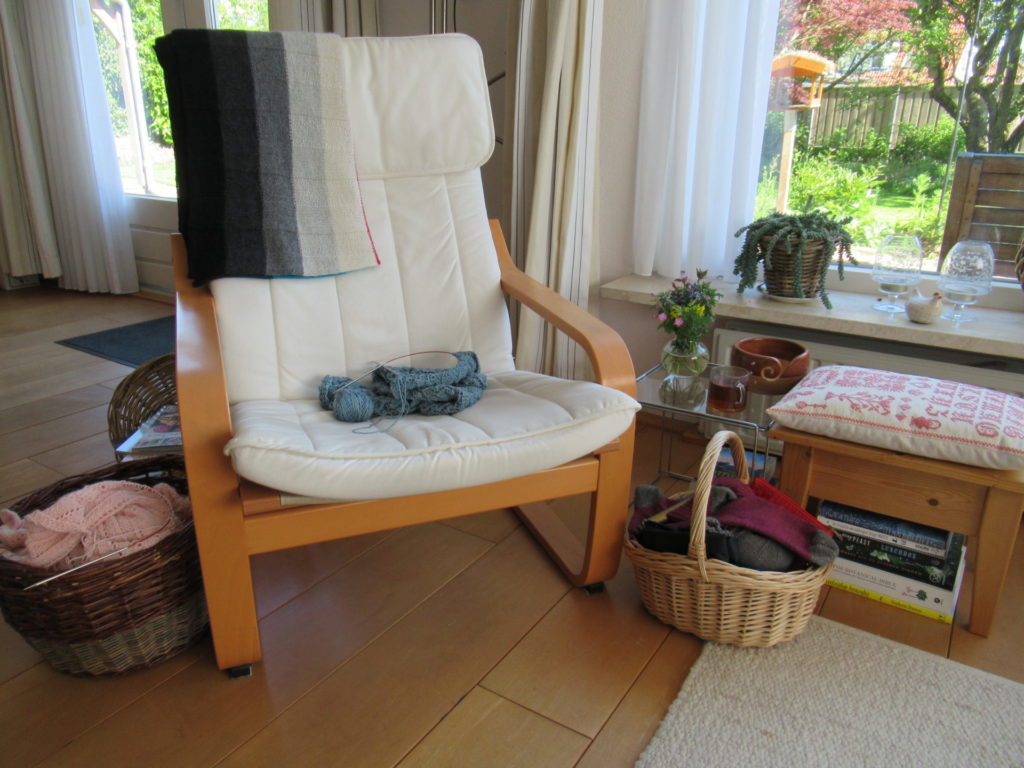
But I don’t take it for granted. I’m grateful for my home every single day, now more than ever.
When we were first exhorted to ‘Stay Home, Stay Safe’, my initial reaction was, ‘……….??????’ (Read: Stunned – is this really happening?) Soon followed by thoughts like, ‘What can I do, other than just staying home?’ and also, ‘But what about people who don’t have a safe home?’
One of the ideas that popped into my mind for positive things to do was to design a knitting pattern. Something small and not too complicated, but just complicated enough to take a knitter’s mind off their worries for a while. Something that would be comforting to wear and suitable to send as a gift to a friend or relative when it’s impossible to visit them.
After many swatches, sketches and tries, it became this loop. I’ve made two versions. You’ve already seen the pink one at the top of this post, and this is me wearing the blue one.
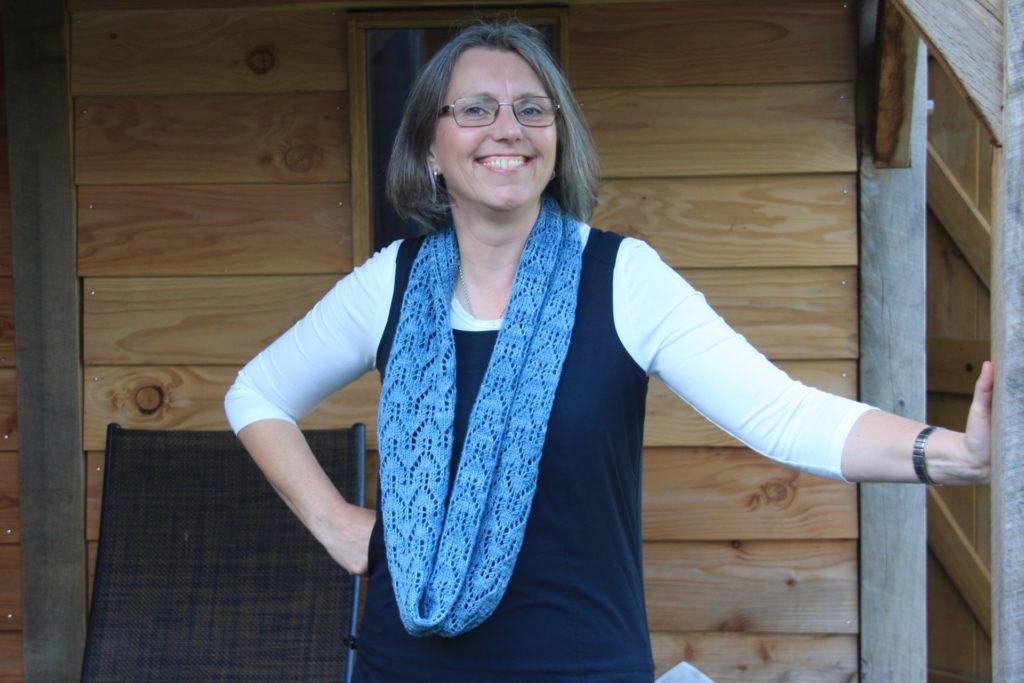
(I’m so not cut out to be a model. It is way out of my comfort zone to be in the spotlights like this, but someone has to show what it looks like when worn.)
Knitting may seem trivial in a world in crisis. And maybe it is. But for me it’s a way to bring some beauty into the world, and also a way to express my love and concern.
With a little bit of imagination, you can see that the stitch pattern looks like rows of tiny interconnected houses.
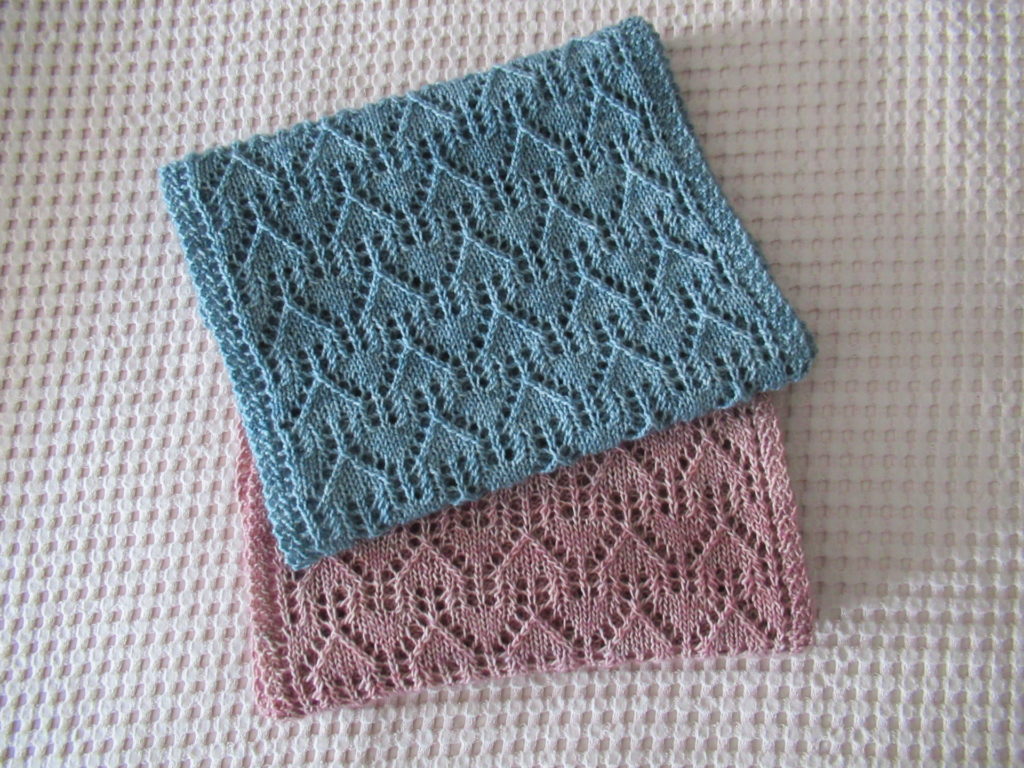
It’s my take on John Donne’s ‘No man is an island’*. Even if we are all staying in our own homes, we are still all connected.
Now, here are some technicalities.
Thús takes just one 100-gram skein of fingering-weight or sock yarn. I think most knitters will have something like this in their homes somewhere. I chose blue and pink, because those are the colours I feel most at home with.
The pink version is made from a skein of Merino Singles dyed by Catharina at Wolverhalen (I wrote about her here). For the blue version I used a skein of Tosh Sock that had been marinating in my yarn stash for a while. These two yarns are very similar, and yet knit up differently.

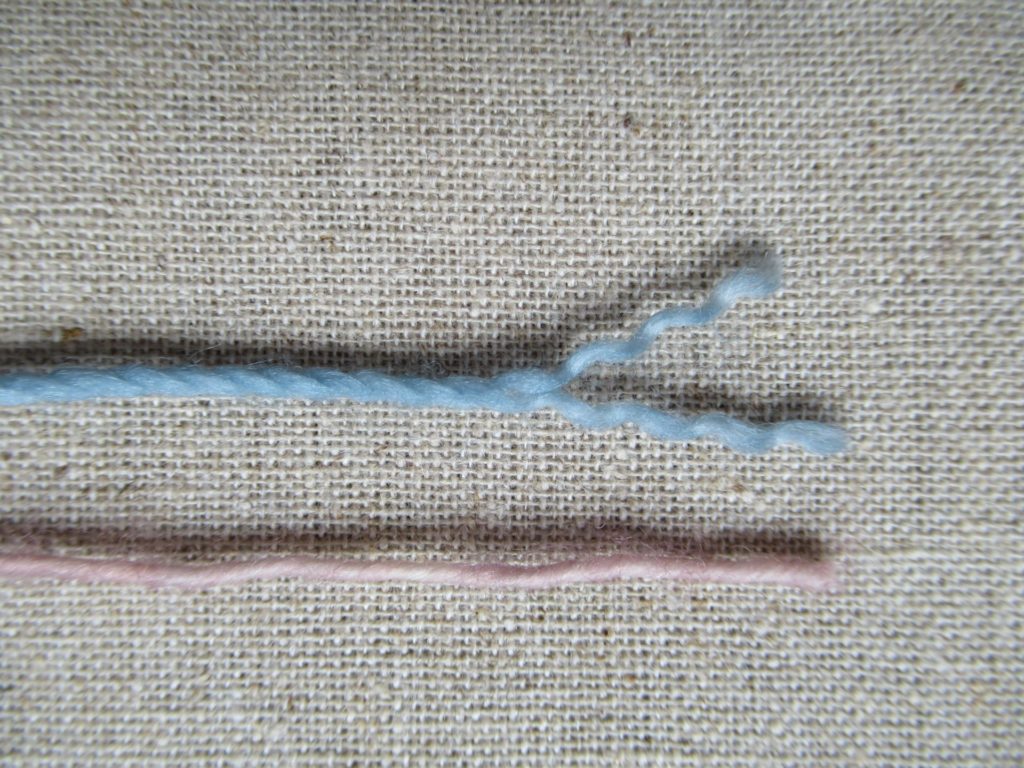
Specs of the blue yarn: 100% merino wool; total meterage/weight 361 m/395 yds/100 g
Specs of the pink yarn: 100% merino wool; total meterage/weight 366 m/400 yds/100 g
The difference is that the pink yarn is a single, untwined thread, while the blue yarn consists of two plies. As a result, the blue version turned out shorter, cosier and squishier, while the pink version is sleeker, drapier and considerably longer than the blue one – it has five more rows of tiny houses.
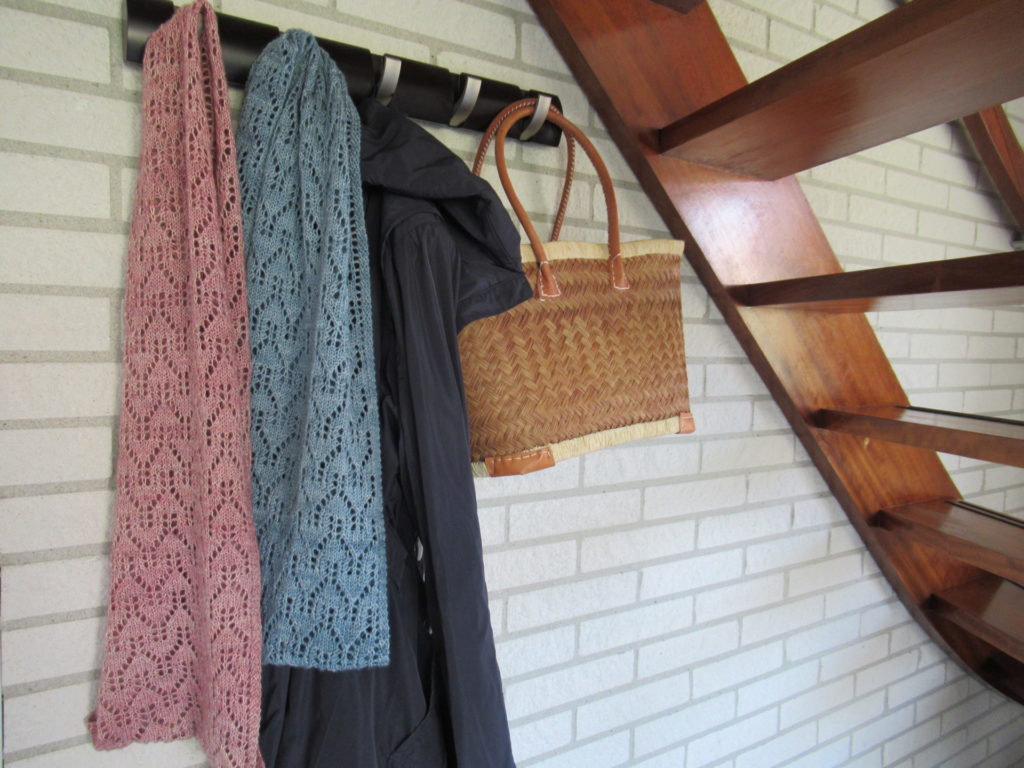
The loop starts with a provisional cast-on and is knit flat (back and forth). I’ve heard of knitters who love grafting ends together, but I have never met any of them. I certainly don’t belong to that rare species. So, no grafting here. The ends are joined together using a much more knitter-friendly three-needle bind-off (all explained in the pattern).
Thús can be worn single…
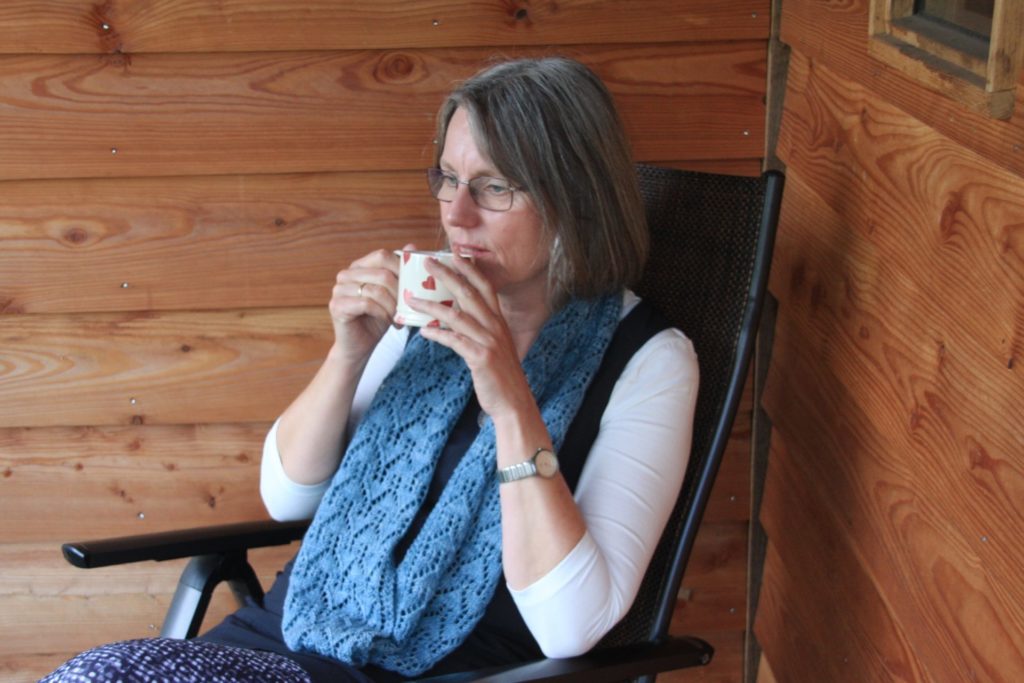
…or wrapped around twice.
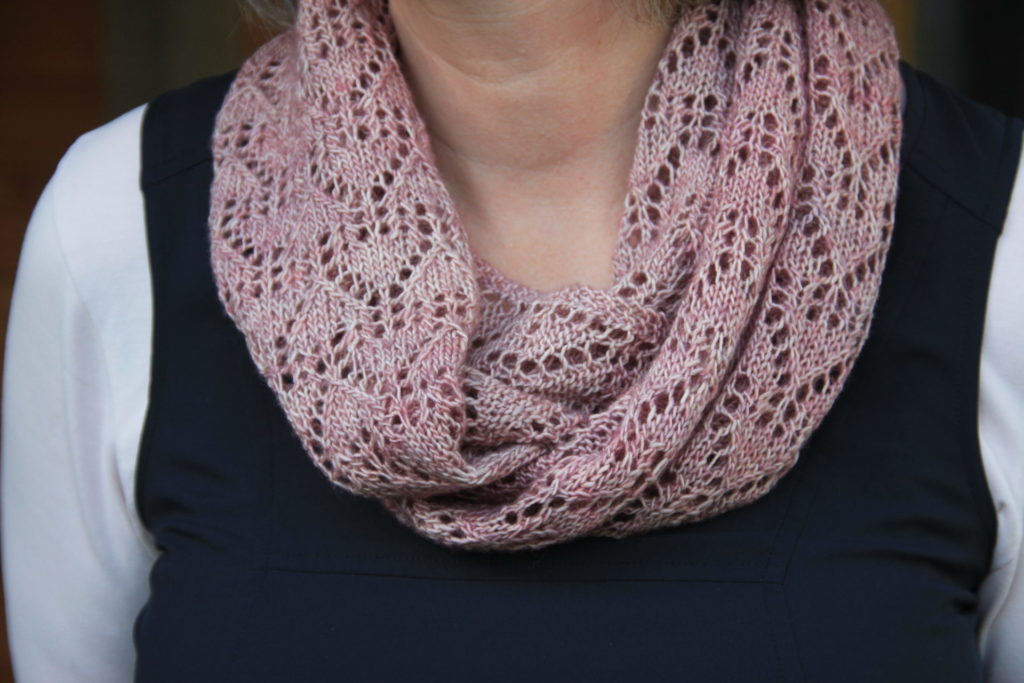
Thús is a free pattern – no strings attached. But if you’d like to do something in return, please consider making a donation to an organisation supporting refugees, other homeless people, or children/adults in unsafe home situations.
Thús can be found here on Ravelry
(available in English AND Dutch, also to non-Ravelry members)
Thank you and happy knitting!
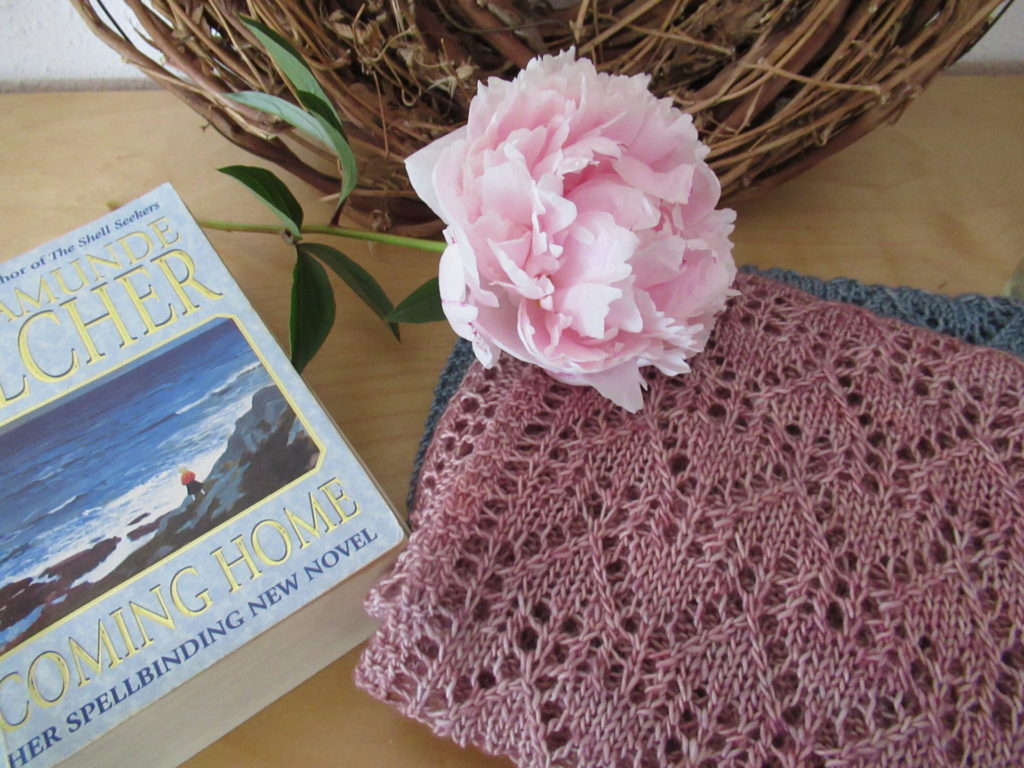
* The quote comes from John Donne’s Devotions upon Emergent Occasions, Meditation XVII. This is the entire passage:
‘No man is an island, entire of itself; every man is a piece of the continent, a part of the main. If a clod be washed away by the sea, Europe is the less, as well as if a promontory were, as well as if a manor of thy friend’s or of thine own were. Any man’s death diminishes me, because I am involved in mankind, and therefore never send to know for whom the bells tolls; it tolls for thee.’
Song of the Sea
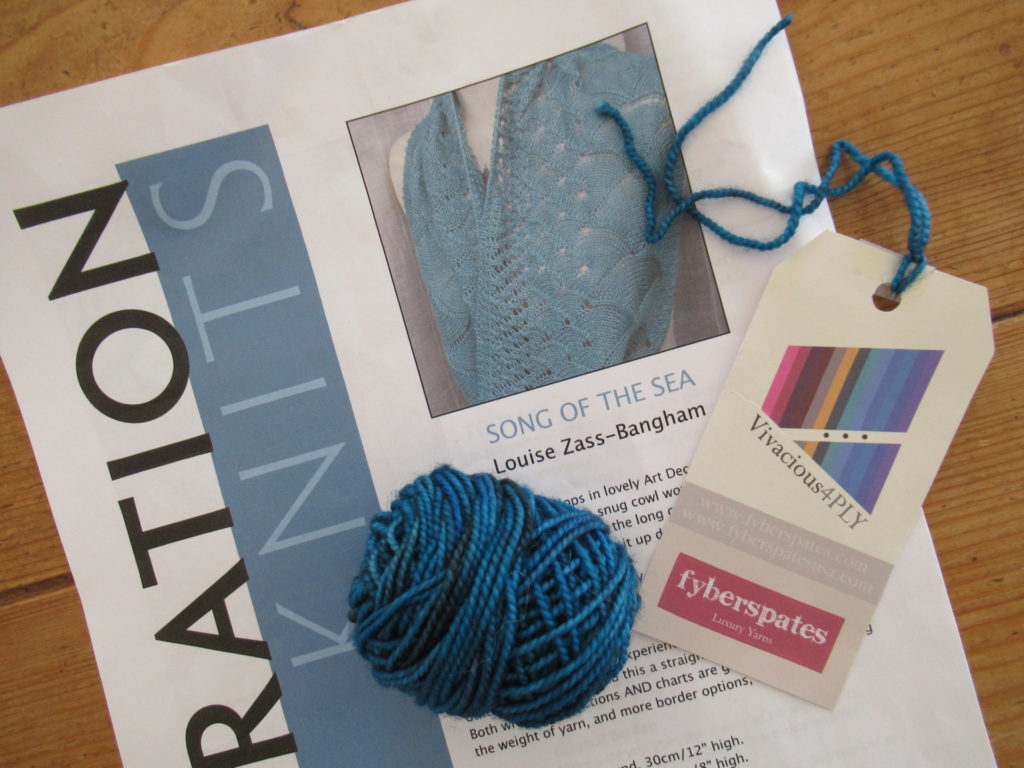
Hello!
Today, I’d like to tell you about a UFO (UnFinished Object) that I’ve just finished. It’s a loop cowl from a pattern called Song of the Sea (Ravelry link), designed by Louise Zass-Bangham.
A lovely pattern and lovely yarn. So why did it become a UFO? Well, there’s a story behind it.
Several years ago, friends of ours gave up their jobs and house, and sold or gave away almost all of their belongings to sail the seas of the world indefinitely.
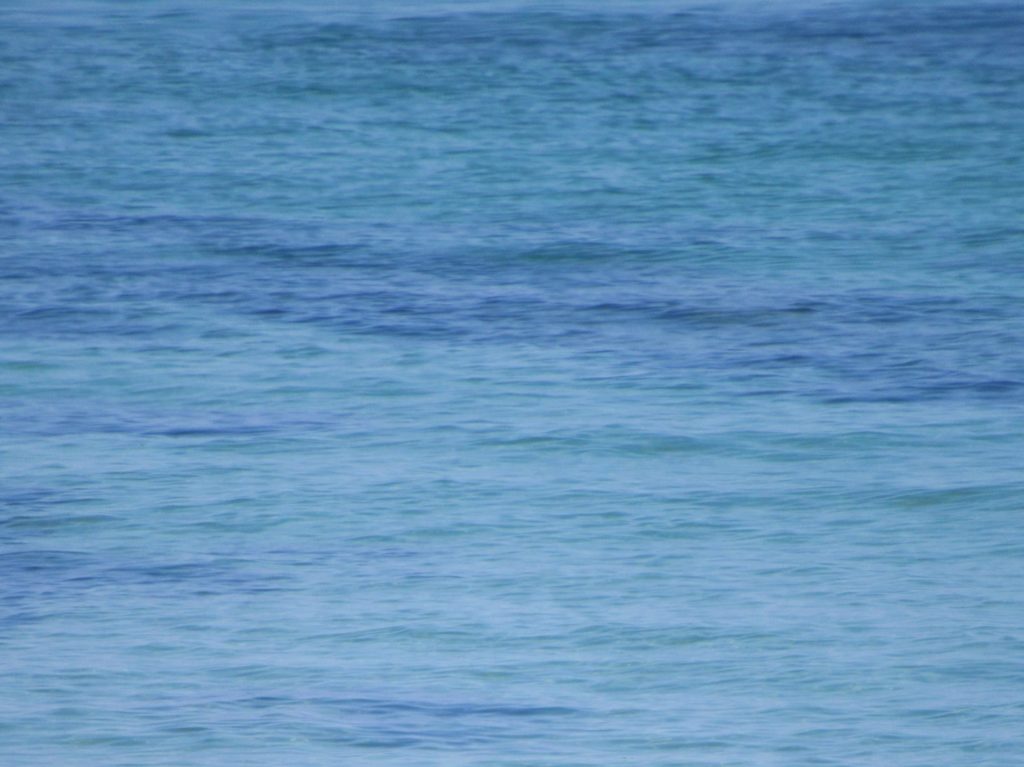
I was knitting this cowl as a farewell present for one of them. When it was nearly finished, it suddenly dawned on me that she would just be wearing shorts and bikinis where they were heading. They weren’t going to sail to colder climes.
It had taken our friends a lot of trouble to get rid of everything they didn’t need anymore, and I didn’t want to burden them with something they would never use. So that’s how my Song of the Sea ended up as a UFO.
Looking at it again earlier this year, I decided that it was far too nice to be left unfinished. Now I’ve knit the last few rounds and blocked it.
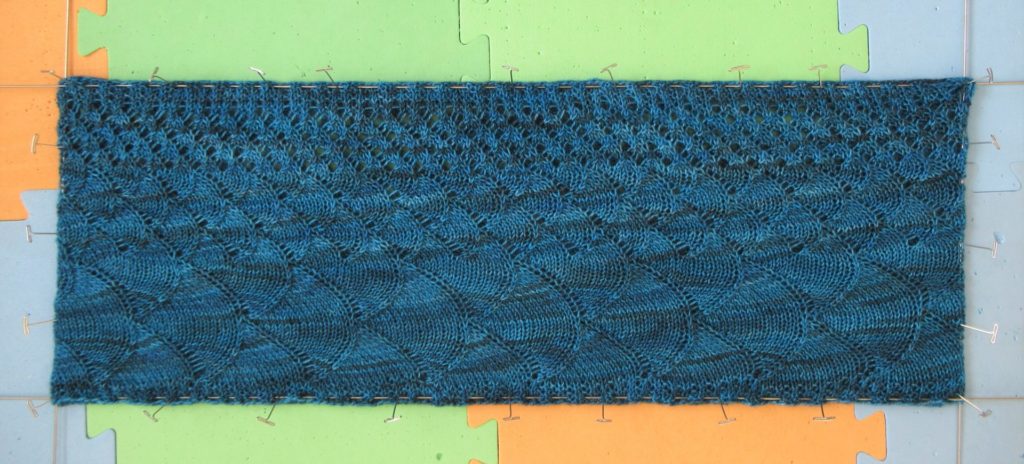
Song of the Sea is knit in the round and has three different stitch patterns, forming large breakers, medium-sized waves and tiny wavelets (in knitting order, from bottom to top). Here’s a close-up:
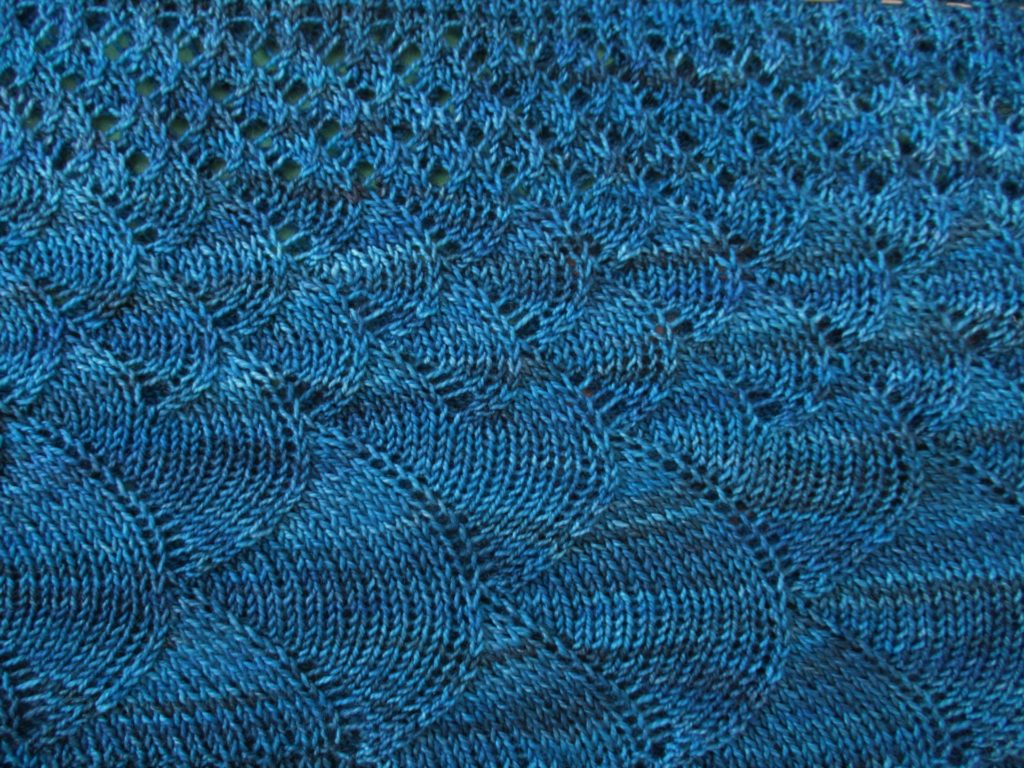
The pattern has a choice of two sizes – a long and a short version. I made the long one. It can be worn singly…
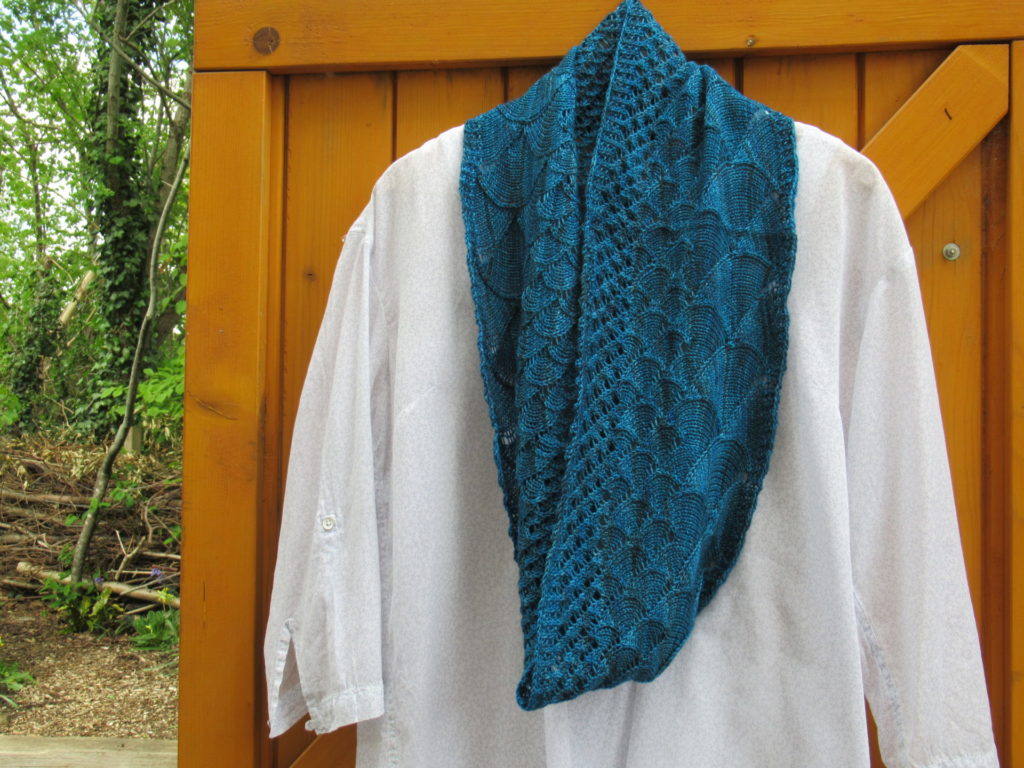
… or twisted double for more warmth.
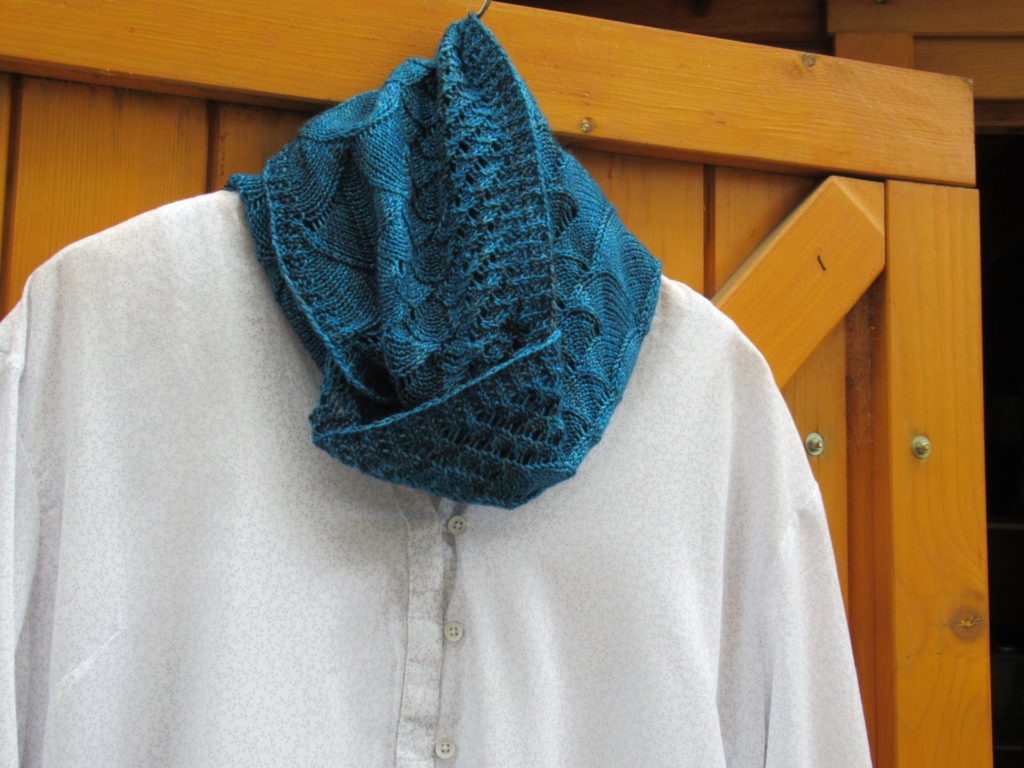
It’s nice, isn’t it? So what am I going to do with it, now that it’s finished? Well, I’ve decided to keep it for if/when our friends come back, even if it is only for a short visit. I’ll gift-wrap it, stick a sticky note with her name on it, so that I won’t forget what’s inside, and put it away in the basket where I keep more gifts for later/someday.
I couldn’t find anything about the inspiration behind this design, but it made me think of the animated film Song of the Sea. Based on an Irish folk tale, the film tells the story of 10-year-old Ben and his mute sister Saoirse, who turns out to be a selkie (somebody who can turn into a seal and back again).
The drawings in this film are exquisite. To give you an impression in case you haven’t seen it, here is the official trailer:
From their latest newsletter, I know that our friends are safe and well ‘down under’. They frequently don’t have access to the internet, but when they do they sometimes read my blog. So, if you’re reading this, dear T and H, I wish you fair seas and following winds!
This is the second of the nine UFOs I intend to finish this year. I’d better get a move on!
